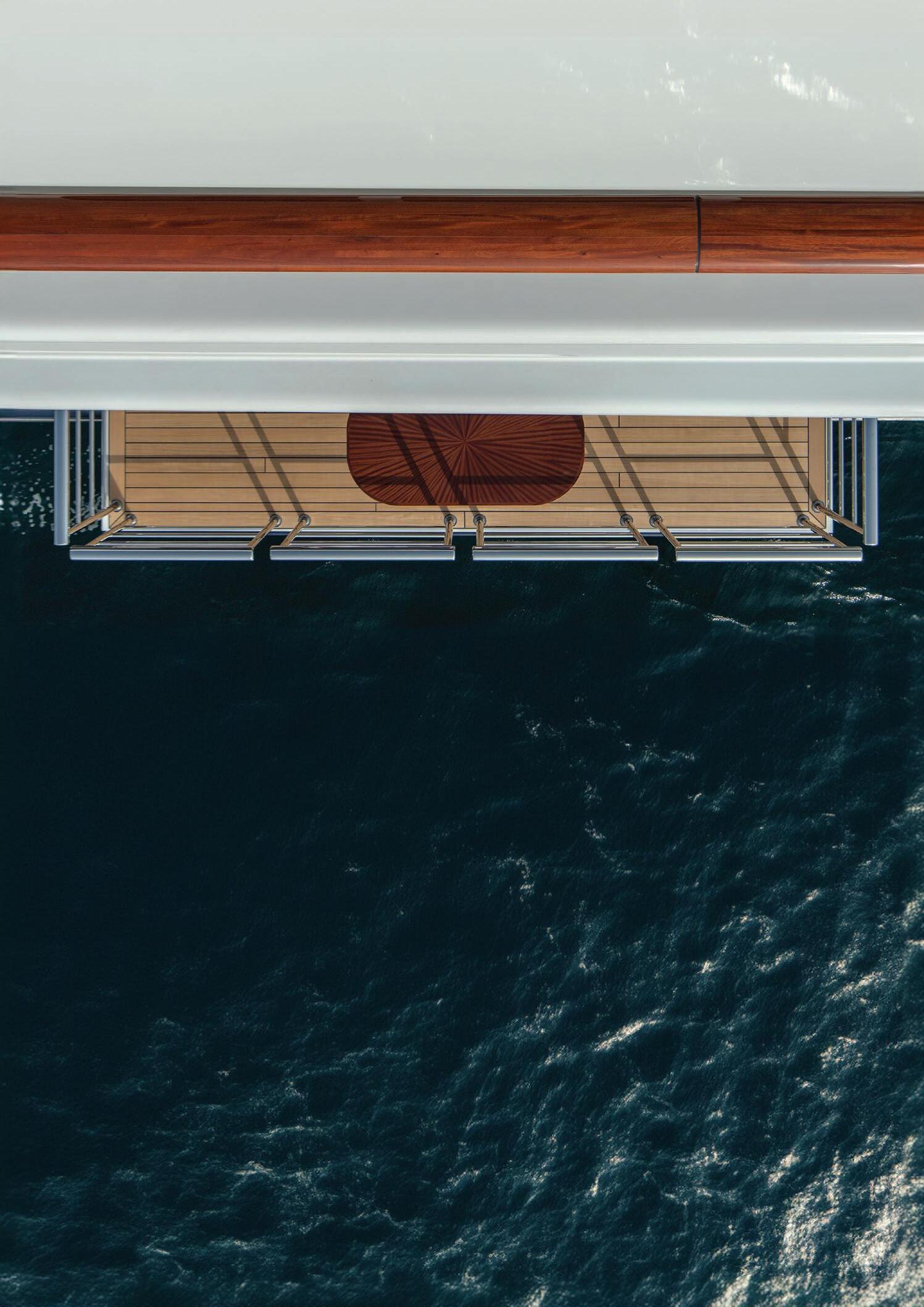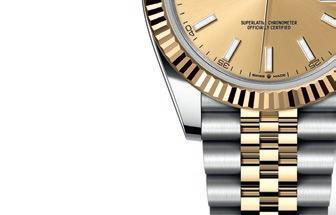




The champion Formula 1 driver shares his winning mentality as TAG Heuer keeps time at the Monaco Grand Prix

Rising 200 metres above the Thames, River Park Tower stands as the tallest residential building in Zone 1 London. This landmark address offers a luxurious collection of one-to-five bedroom apartments and penthouses. Residents enjoy unparalleled access to world-class amenities, including in-residence dining delivered by the UK’s first Park Hyatt hotel, housed within the same distinguished development.
Prices from £ 1,053,000


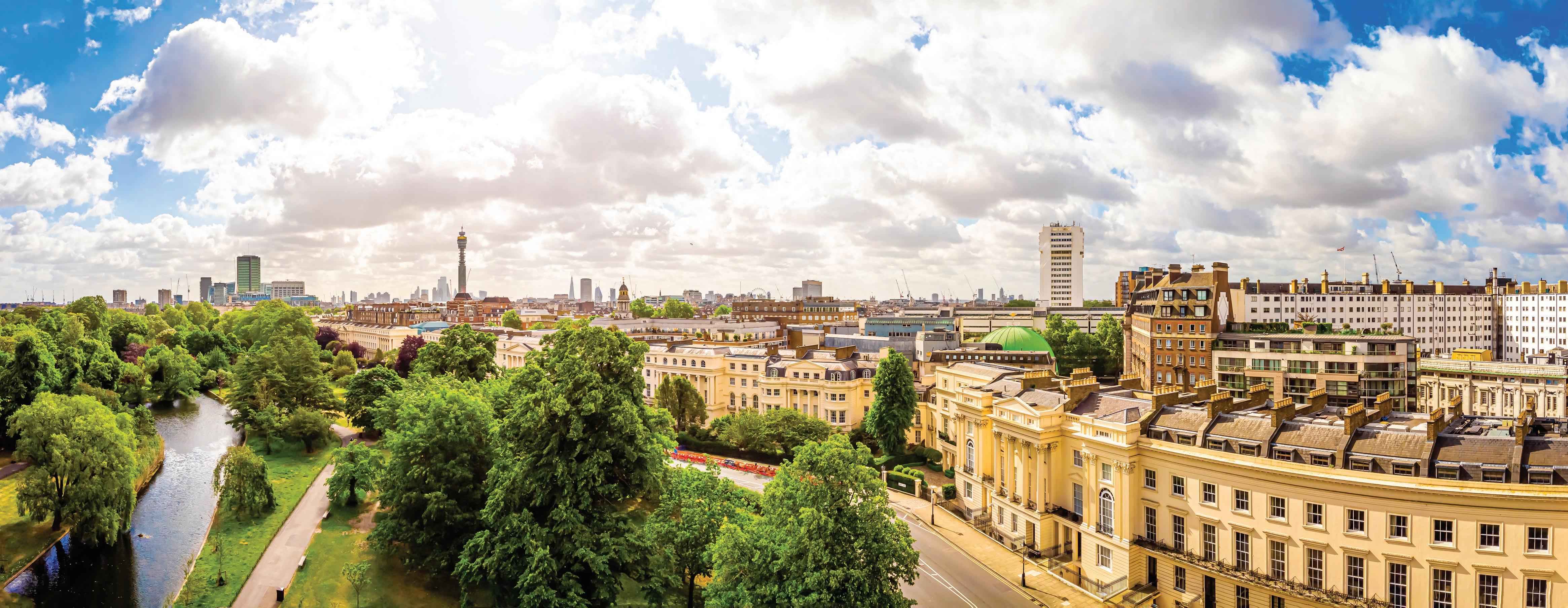

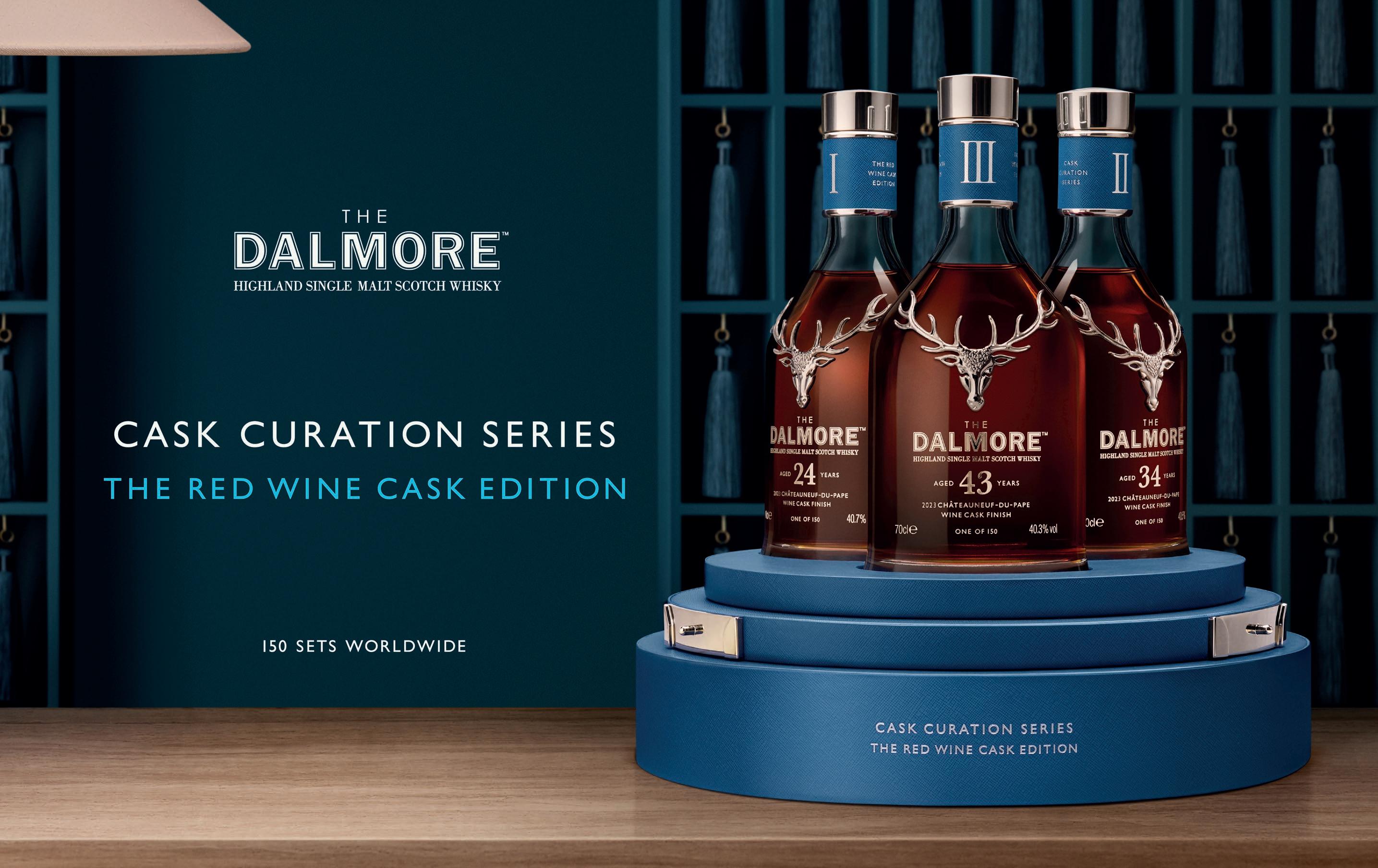


When it comes to wellness, we often find the greatest wisdom comes from those living life in the fast lane. Take our cover star, four-time Formula 1 world champion Max Verstappen, whose winning mindset is the definition of mindful
In our interview (page 32), Max reveals that he approaches every race with total confidence in his ability to command each F1 circuit – and a relaxed mentality that allows him to learn from life’s losses, rather than overthink them.
Similarly, speaking of his ambition to advance the watchmaking industry with the astounding Diver [Air] timepiece, Ulysse Nardin managing director Matthieu Haverlan reveals that collaboration – and even imitation – is something to be embraced; so long as genuine, changemaking innovation remains the name of the game (page 74). It was clear when we met earlier this year that the word “impossible” is merely a challenge to Matthieu – in fact, I got the sense that he and his team consider it a starting point.
With these refreshing outlooks driving recordbreaking achievements across different industries, could it be that true empowerment comes from the point where mindfulness meets innovation?
In this issue, Tempus explores many areas where this might be the case – the rising trend of science-led treatments in the spa sector (48), the emergence of AI-driven scents within the fragrance industry (70), and the expedition yacht trends that are once again changing the way we explore the ocean (22). But it’s also clear there’s a hunger to slow down and reconnect, whether we’re embracing the evolution of digital detox retreats (18), ‘runcations’ that combine sightseeing and fitness (82), or artwork from Leah Wood that takes its cues from the seasons of the year (88).
We hope this edition of Tempus is as thoughtful as it is thought-provoking, and offers you a moment’s pause before returning to your own experiences of peak performance.
Enjoy the issue

Michelle Johnson Editor-in-chief Tempus

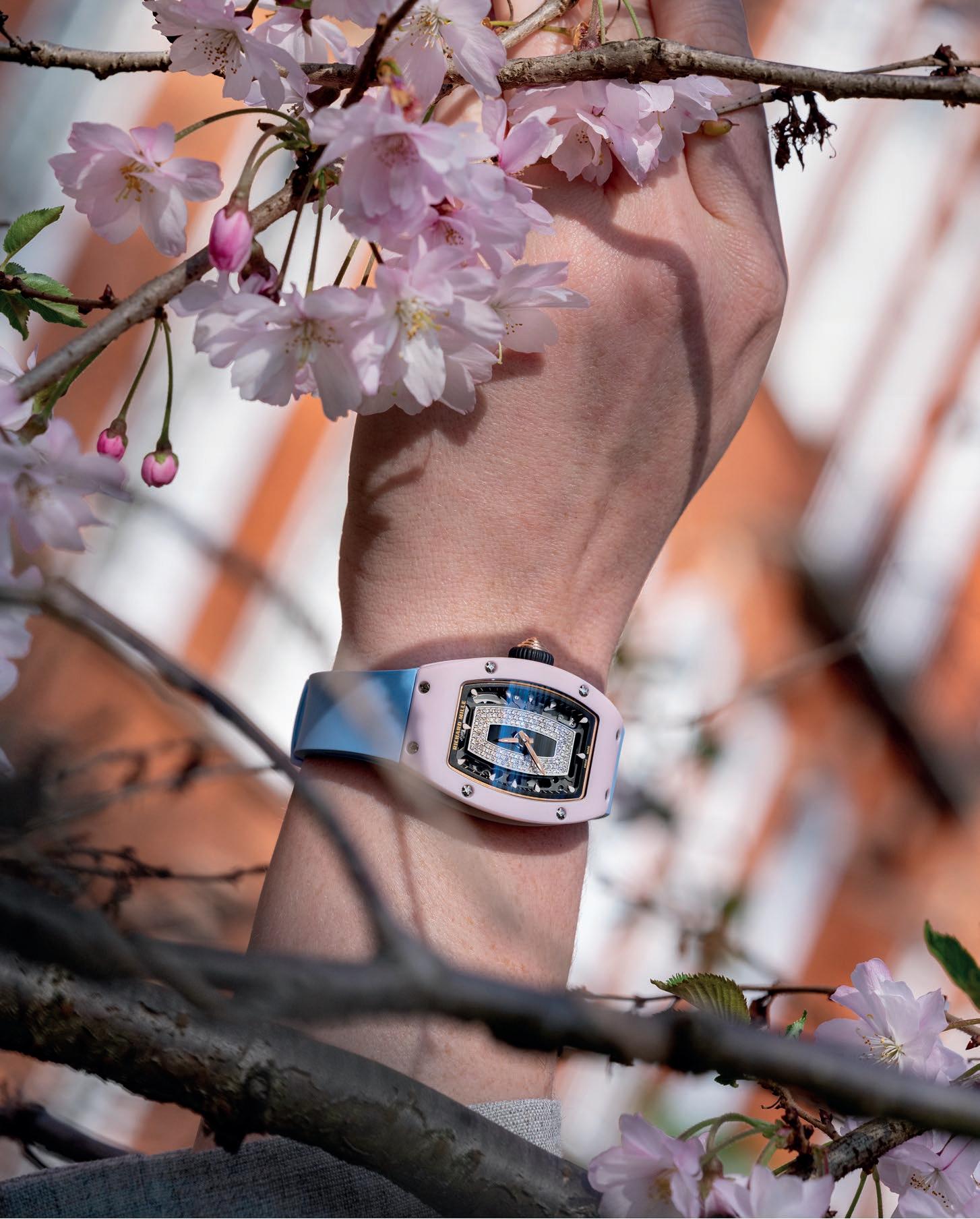





Rikesh Chauhan
Tempus’s style columnist Rikesh shares his passion for the ultimate wardrobe essential – jeans – as he recommends the best men’s denim staples for the transitional season (112).
Lysanne Currie
From Gen Z to seasonal artwork, expert journalist Lysanne explores generational wealth trends (96) and interviews artist and activist Leah Wood for her timely new exhibition (88).
Ming Liu
Luxury journalist, watch and motoring expert Ming sits down with our cover star Max Verstappen at this year’s Monaco Grand Prix to talk champion mindset – and keeping time (32).
Editorial team
Editor-in-chief
Michelle Johnson
michelle@tempusmagazine.co.uk
Creative Director
Ross Forbes ross@tempusmagazine.co.uk
Digital Editor
Shivani Dubey shivani@tempusmagazine.co.uk
Contributors
Judy Cogan, Tessa Crowley, Lysanne Currie, Lauren Jade Hill, Ming Liu, Charlotte McManus, Rory FH Smith
Sub-Editors
Dominique Dinse, Dawn Emery
Designer Emma Howcutt-Kelly
COMMERCIAL
Head of Partnerships
Dan Scudder
dan@tempusmagazine.co.uk
+44 (0) 203 519 1005
VANTAGE MEDIA
Managing Director Peter Malmstrom
Rory FH Smith
Test driving the latest trends for Tempus, motoring expert Rory takes the impressive Land Rover Defender Octa for a spin (28), and finds out why expedition yachting is making more of a splash than ever before (22)
COVER IMAGE
Formula 1 racing driver Max Verstappen
Photographer: Pierre Alban Hüe de Fontenay at the Maybourne Riviera Hotel for TAG Heuer
Article on page: 32
@tempusmagazine @tempusmagazine




14 The Luxe List Our essential guide to this season’s finest gifts and most exciting new launches
18 The great resent Discover the joy of missing out as we experience the evolution of digital detox
22 Adventure awaits How expedition yachting is once again making new waves in ocean travel
28 Diamond in the rough We put the Land Rover Defender Octa through its paces
32 Maximum impact Formula 1 champion Max Verstappen shares his winning mindset
38 Phenomenal fusion Aki London prepares for service at the historic One Cavendish Square
42 La dolce vita Take a tour through some of our favourite areas of Italy
48 Wellness 2.0 Discover the world’s most cutting-edge spa treatments
52 Beneath the surface Labareau founder Lindsay van der Looij on blending skincare and science
58 Fashion focus Meet the most exciting faces in fashion design
66 A fond farewell The cast of Downton Abbey bid goodbye to the beloved aristocratic period drama
70 Olfactory intelligence Discover how AI scents are transforming high end fragrance
74 Lighter than [Air] Ulysse Nardin MD Matthieu Haverlan on his drive to revolutionise watchmaking
78 A tale of two mountains We head to Whistler Blackbomb to experience skiing at scale
82 More than miles Travel differently with these perfect ‘runcation’ destinations for fitness fanatics
88 Into the woods Artist and activist Leah Wood looks to the seasons for inspiration at her new exhibition
92 Alternative assets These collectible investments are putting the fun-factor back into finance
96 Investment to impact How Gen Z is changing what it means to be wealthy
103 RE:VIEW Discover seasonal recipes from Cowdray Estate, plus our pick of the best fairs, festivals and more
108 Save the date The finest events of the season
112 Making a comeback Tempus style columnist Rikesh Chauhan shares his pick of the best seasonal denim


How do you know when something isn’t working out? Red flags that seem obvious in hindsight can be difficult to spot in the moment, and rose-tinted glasses keep us in unhealthy relationships long past their sell-by dates. And that’s why assessing your private bank is so hard.

By Rob Agnew, Partner and Head of Private Capital at Isio
We choose private banks to manage our wealth because we trust them with our money and to provide the very highest quality of service and expertise. Well-known private banking brands convey prestige and we are reassured by the status of a longstanding institution.
For anyone coming into new money from selling their business or from inheritance, for example, a private bank can feel like the obvious solution – a one-stop shop offering discretion, sophistication and access to investment opportunities that are otherwise out of reach. But over time you might get the feeling that what you were promised at the start isn’t what you are getting now. If this is happening to you, how can you tell? And what can you do about it?
The reluctance to change a private banking relationship is understandable. Wealth brings complexity and the effort and risk of overhauling a relationship that is ‘adequate’ may feel like too much. The administrative burden of moving accounts, transferring assets and dealing with paperwork often discourages change.
Emotional ties also reinforce inertia. Longstanding family associations with an institution, a sense of loyalty to an adviser, or the prestige of a well-known name will all impact the decision to break up with your private bank. These factors create a sense of comfort, but comfort is not the same as quality.
Complacency can be costly. Private bank investment solutions which should be personalised are increasingly turning out to be variations of a central model. Fees are rarely transparent and it is difficult to establish the total cost, and even harder to compare between banks and determine value for money.
Performance is reported selectively, usually against peer groups that provide little meaningful benchmark for success against your personal objectives. Meanwhile, what is presented as advice can often be more akin to product sales, with private banks incentivised to promote what suits them, rather than what best serves their clients.
Despite the difficulties of evaluating your private bank relationship, there are clear red flags to look out for. The most significant is when you ask for your strategy or portfolio to be adapted to a specific objective and that request is with hesitation, or declined altogether. You are paying for bespoke wealth management and any friction suggests you are receiving a service that is standardised rather than tailored.
You should also be able to identify an all-in cost of service. Where this is obscured, it is a sign that your interests may not be fully aligned with those of your private bank. Equally important is understanding the nature of the advice itself. Too often, investment recommendations are shaped less by client objectives than by what the bank is best positioned to sell. When recommendations resemble a bank’s historic strengths and pushy to point of feeling sales-oriented, rather than based on impartial advice, it is a clear sign that the relationship is no longer serving your needs.
Dealing with the same people matters. High turnover of senior bankers, who are being replaced by less experienced staff, is another warning sign that quality of service could be set to deteriorate. This can reduce
the quality of your engagement to a transactional, rather than deeply personal, relationship.
Investment performance is more complex to assess and if markets are benign you may feel less inclined to scrutinise returns. Private banks often benchmark your portfolio performance against broad industry averages, but comparisons should show your portfolio relative to a portfolio with similar objectives. If you have a long-term growth objective, ask for performance to be compared to one of the world’s leading pension funds or endowments. Don’t settle for mediocrity disguised as competence.
Finally, don’t get sucked in by glossy reports and curated events. They can create the impression of sophistication, fuelling the inertia which makes severing a private bank relationship more difficult. The essential question you need to ask yourself is whether your bank is providing genuinely bespoke advice and excellent value.
When doubts accumulate, ending the relationship can appear daunting, but there are simple steps you can take to make looking around for a new partner straightforward. The first step is an audit assessing whether fees, performance and service have met the commitments your bank originally made. The next is to evaluate what you are getting against other providers and not just banks, but genuine investment specialists.
When making a change, preparation is crucial. Understand exit terms, transfer processes and potential tax considerations. This will help you switch in a way which minimises disruption and ensuring continuity for your portfolio.
Just as in other professional fields, there is a distinction between generalists and specialists. You likely wouldn’t want your GP performing brain surgery. Wealth is no different. Private banks can provide high quality banking services but for managing wealth and investments, a specialist will have genuine expertise in constructing and managing portfolios and adapting strategies to your evolving needs.
Wealthy individuals and their families are increasingly turning to investment specialists, or establishing a family office which works in close partnership with them. This arrangement offers control, independence and access to sophisticated knowledge and high-quality solutions in a world where the challenges to successfully managing wealth are growing.
In an environment where the financial needs of wealthy individuals are increasingly complex but the potential to protect and grow wealth is higher than ever, remaining in a comfortable but unproductive private banking relationship is a significant risk. While potentially daunting, the best decision you take this year might be to break up with your private bank.

Our essential guide to the most exciting new launches and finest seasonal gifts

The Dalmore Cask Curation Series
The third chapter of The Dalmore’s Cask Curation Series is here, and this stunning release (right) comprises of a trio of rich and layered whiskies finished in Châteauneufdu-Pape red wine casks from Château Mont-Redon. The 24 Years Old, 34 Years Old and 43 Years Old single malts each showcase the distillery’s dedication to using the finest wine casks to enhance their exquisite whisky. Just 150 sets are now available globally, priced at £36,100. Slàinte Mhath. Find out more on page 26
thedalmore.com/caskcuration
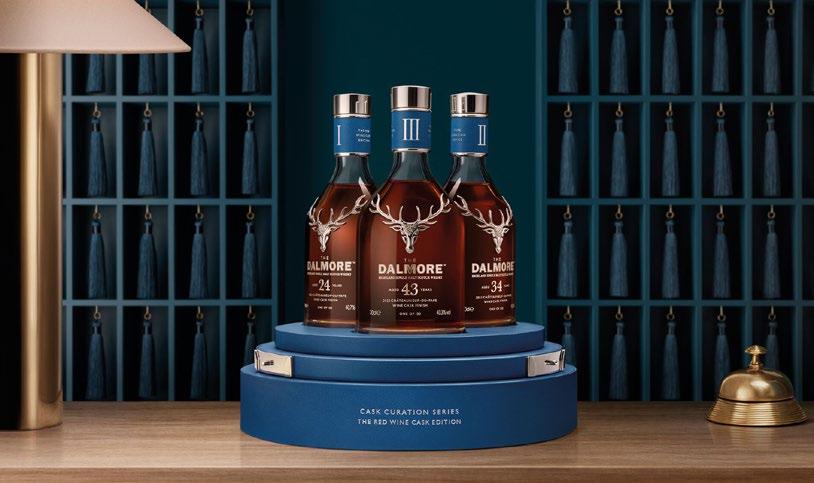
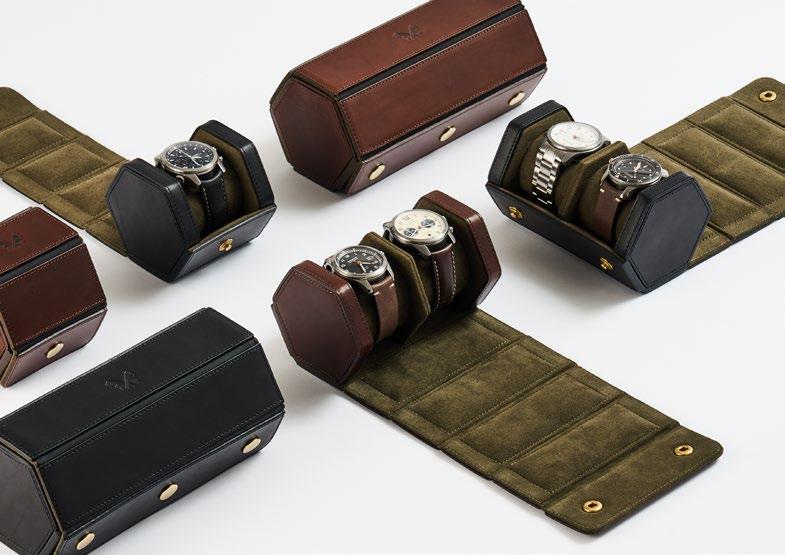
Code 11.59 By Audemars Piguet
Selfwinding Flying Tourbillon
Audemars Piguet’s latest limited edition novelties comprise of three vibrant stone dial references in the Code 11.59 by Audemars Piguet collection. Featuring the watchmaker’s ultra-thin 38mm selfwinding flying tourbillon (typically reserved for larger watches), the trio of watches was created by sourcing three precious stones from around the world: ruby root (left), blue sodalite and green malachite. Each dial is respectively paired with a case crafted in 18-carat white, pink, or yellow gold. Completing the design, the vibrant dial colours continue seamlessly into matching alligator leather straps with large square scales – for time spent in full colour.
audemarspiguet.com
Bennett Winch Watch Roll
In 2020, Bennett Winch reimagined the way watches are stored, launching the world’s first flat-bed hexagonal watch roll. After the success of the original triple watch format, the brand recognised the need for both dual and single versions, which have now been released (left). Each roll is handmade in London, combining Tuscan leather panels, a flexible Kevlar® core and cushioned Alcantara® lining. The result is a structure that transforms from a rigid protective shell when closed, into a soft preparation and display surface when open. It’s safe to say that a lot of time goes into these luxurious handmade watch rolls.
bennettwinch.com
Piaget is one of the world’s foremost high jewellery houses, and these three new additions to its Rainbow Possession Collection are a perfect showcase of the maison’s savoir faire. The sophisticated bracelet (right), pendant and ring are decorated with delicate rainbow set stones – diamond, ruby, sapphire and tsavorite – which are selected for their hue and size, ensuring perfect gradation of colour. Stylish jewellery that makes a colourful statement, rain or shine. »
piaget.com



Robert Braithwaite RBB 19 boat
This reimagined RBB 19 is a boat built as a tribute to Robert Braithwaite CBE DL, the legendary British yacht manufacturer who founded Sunseeker Yachts. Built to order, the RBB 19 (right) is a bigger and more contempoarary version of the Sovereign Hostess 17 –featured in the James Bond film Quantum of Solace, which saw Robert cameo at the helm, driving actor Daniel Craig across an
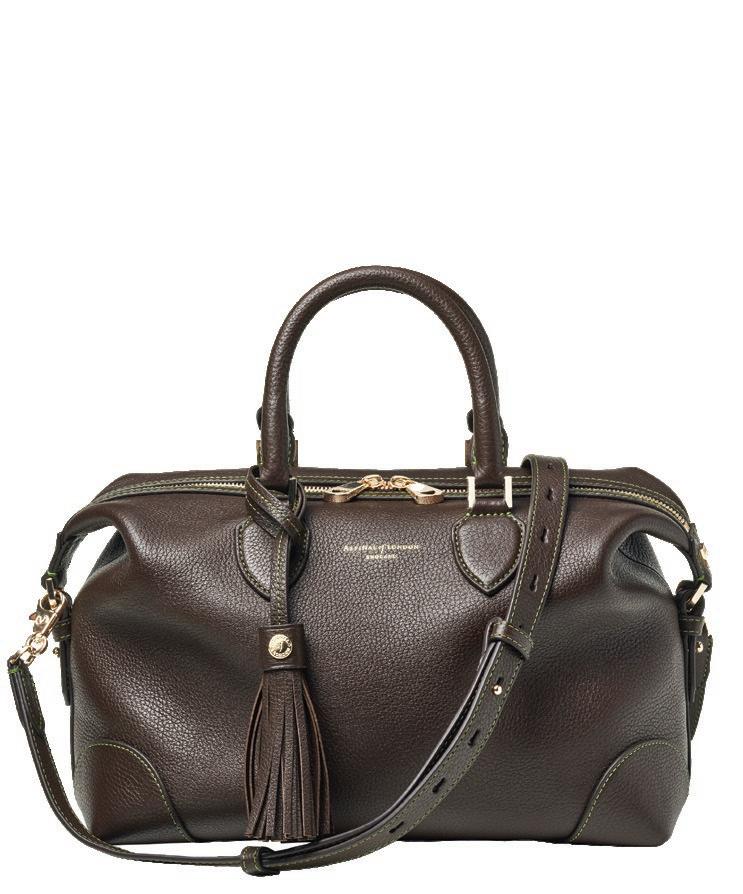
Lazulio by Diptyque
A new addition to the Les Essences de Diptyque collection (left), Lazulio – inspired by the peacock feather – is an eau de parfum celebrating a richness of textures and colours for an intense, radiant olfactory experience. Lively, tangy rhubarb blends harmoniously with creamy, balsamy facets of benzoin, adding an enveloping, addictive dimension to the composition. The harmony is enriched by vetiver from Haiti, with its vibrant shadings of wood and citrus. Meanwhile, a delicate touch of rose gives the ensemble an elegant lift. Luxurious, intoxicating and showstopping – as a good perfume should be. Scent-sational.
diptyqueparis.com

Aspinal of London Travel Ready collection
Indulge in autumnal style with Aspinal of London’s elegant Travel Ready collection (left), presented in sumptuous, seasonal brown hues. Bringing elegance and intention to the art of departure, whether heading away for a long weekend, checking into a city hotel, or arriving early for the first train, the collection offers everything needed to be perfectly prepared. From cabin cases and flight bags to backpacks, tote bags and cross body pouches, level up your packing so you focus on travelling in serious style.
aspinaloflondon.com

La Bougie Mission Fig candle
From cosy and calming autumnal spices to the spicy citrus of summer, a great scented candle can subtly influence the ambience of any room. La Bougie’s Mission Fig scent (right) is a great addition to your candle collection. A favourite of the legendary Adare Manor, this candle contains notes of parched earth, fig leaves and blond wood. La Bougie was created by former royal chef Lucy Hagerty, who creates each La Bougie fragrance entirely in the brand’s West Cork perfumery, using prized aromatics and botanical oils from around the world. Instant serenity.
Lürssen Fine Art Book
German luxury yacht builder Lürssen marks its 150th anniversary with an exclusive fine art book (left). Photographer Jarmo Pohanjiemi embarked on a 10-month, globe-spanning journey, documenting 36 Lürssen yachts and capturing the excellence of yacht-building through his lens – from the turquoise waters of the Maldives to the vibrant coastlines of Thailand and the storied European shores. The Lürssen Fine Art Book presents the fleet as never before: synchronised swimmers aboard Flying Fox, Pelorus navigating a freak storm off Cyprus, and sweeping aerial views of yachts gliding through some of the world’s most secluded waters. The limited-edition book is available through ACC Art Books.
accartbooks.com; lurssen.com
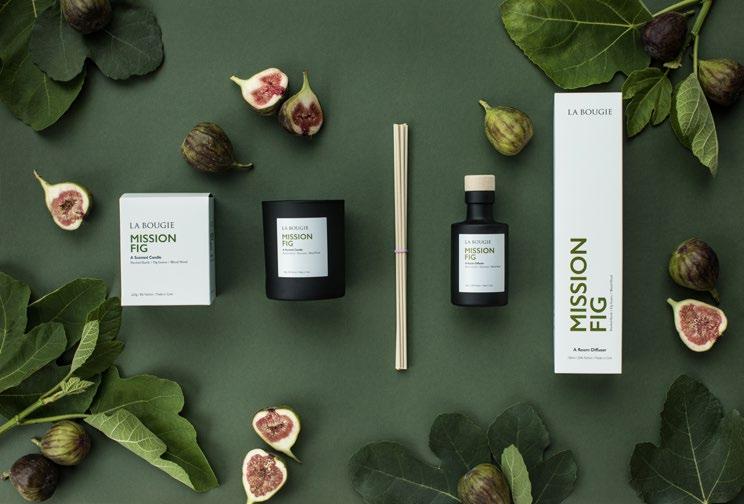

labougie.co.uk 10
River Park Tower
Rising 57 storeys above the River Thames, River Park Tower stands as the tallest completed residential building in Zone 1 London. This landmark address offers a collection of one- to fivebedroom apartments and penthouses. Residents enjoy world-class services, including a 24-hour concierge and in-residence dining delivered by the UK’s first Park Hyatt hotel, housed within the same distinguished development. Its amenities include the Sky Terrace and Lounge, children’s playroom, cinema rooms, gym, boardrooms and business centre. The location combines the serenity of riverside living with the buzz of a central London postcode – for those who expect the very best.
riverparktower.com
As the opportunity to disconnect from the digital realm becomes more appealing than ever when planning our travel, we find out how to revel in the joy of missing out
Words: Lauren Jade Hill
If there’s one travel trend we’ve seen grow exponentially in recent times, it’s the pursuit of digital disconnection. JOMO, or the ‘joy of missing out’, encapsulates this rising appreciation for time away from the perpetual activity of our digital lives. Increasing numbers of people are looking for destinations where they can fully switch off,which has led to more experience providers tapping into this style of travel.
Unplugged is one such operation. Launched in 2020, with a 90% increase in occupancy rate this year, Unplugged brings together more than 30 digital-disconnection cabins across the UK. The most recent addition to the collection, Elsa, was launched in a tree-lined corner of a Cornish estate this May, with amenities such as a wood-fired hot tub, where you can switch off, slow down and reconnect with yourself and the natural world. At these eco-friendly cabins, guests lock away their phones in exchange for an old-school Nokia phone, physical map, compass and a Polaroid camera.
Co-founders Hector Hughes and Ben Elliott launched Unplugged after experiencing burnout from their careers in the tech industry. “I burnt out – hard,” says Hector. “In an attempt to cure that burnout, I booked a silent retreat in the Himalayas for a hard reset. The silence was great, but the most transformative part of it was locking away my phone. I realised I hadn’t been away from my phone in years, and the relief I felt was incredible.”
After returning feeling fully recharged, Hector reached out to Ben, and the pair decided to come up with a way netizens could find that sense of disconnection closer to home.
“When I returned, I quit my job and started Unplugged. Ben and I wanted to help other busy folk access my experience but without flying across the globe. And with the screentime epidemic getting worse year on year, there was a huge demand for an offline destination.
“Our mission is to improve collective human wellbeing and normalise going offline regularly, and we’re making steps towards that every day,” he says. “Our digital detoxes remind people what ‘human’ feels like, without the constant stress and distraction from our phones. It’s simple - but it can be life-changing.”
Indeed, these digital detox retreats are shown to improve both physical and mental health as they reduce stress, improve sleep and help you feel like you are truly living in the present. »
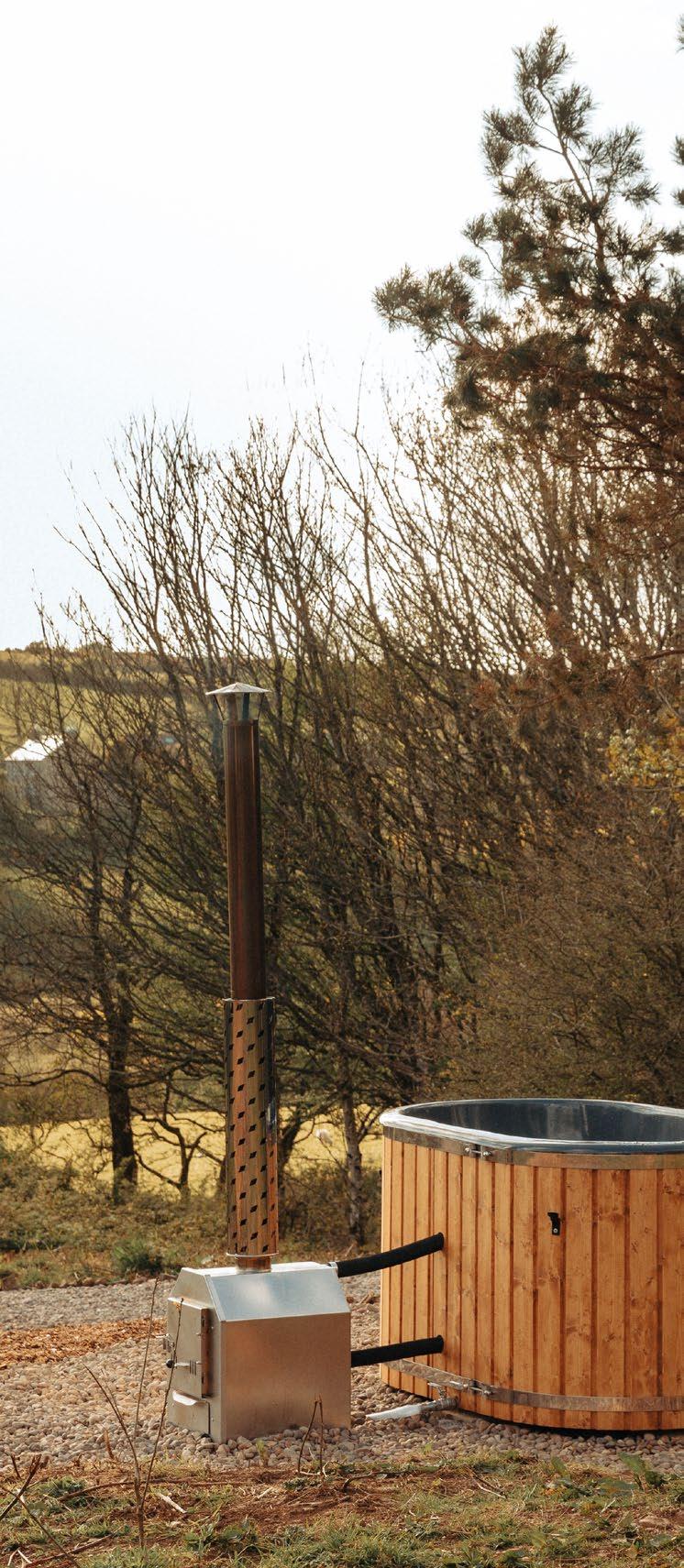

Over on the island of Saint Barthélemy in the Caribbean’s arc of Leeward Islands, Le Barth Villas has just launched its new Quiet Villas Collection in response to the increasing demand for this type of stay. While bedding down in one of eight panoramic sea-view villas, guests can opt to surrender their devices and disconnect from screens and wifi to ultimately unplug from digital noise and instead immerse themselves in the serenity of these picturesque shores. A guided yoga session helps ground the body and mind, Atma Janzu aquatic therapy provides greater restoration, and a curated collection of books and Le Barth notebook enhance quiet reflection.
Of these private luxury villas, cliffside Cap au Vent and Yellow Bird provide panoramic views from Pointe Milou, while Ginger looks out from its hilltop setting above Petite Saline. Oui, Paulista and Casa del Mar place you on the water’s edge of Petit Cul de Sac. Both found close to Gustavia, the June and Axel Rock villas pair easy access to the island’s main hub with sunset sea views and the surrounding natural elements. Across in the equally scenic Maldives, InterContinental Maldives Maamunagau Resort is also encouraging guests to fully disconnect through serene retreats including the Hermit Days Silent Immersion stay and Digital Detox package. A wellness mentor guides you through your personalised stay encompassing yoga and meditation among its highlights. Surrender your digital devices on arrival to fully commit to your break from digital disruption.
Of course, several stalwarts from the world of wellness have long known the benefits of cutting yourself off from the digital realm. In Hua Hin, Thailand, the legendary wellness sanctuary Chiva-Som has long promoted the profound benefits of a digital detox. By encouraging guests to take a purposeful break from technology, the resort enables guests to better restore clarity, balance and peace of mind, and to reconnect with themselves and the world around them. Through curated digital detox retreats, both Chiva-Som and its newer sister property, Zulal Wellness Resort in Qatar, bring together activities such as yoga, meditation, NSDR (NonSleep Deep Rest) practice, spa therapies and mindful creative activities to help guests fully benefit from their time away from the constant ping of distractions. Taking this concept a step further, Zulal Wellness Resort has also begun to host a new Family Digital Detox Retreat, for children aged nine to 15, aimed at inspiring relaxation, promoting rejuvenation and strengthening family bonds.
As technology carries on dominating our daily lives, the number of retreats, and the demand for them, can only continue to grow.
Whether you opt for digitally disconnected time in nature or a full wellness regime, it’s never been easier to experience the joy found in giving ourselves a much-needed break from the technological world.
unplugged.rest; lebarthvillas.com; chivasom.com; zulal.com; maldives.intercontinental.com
Finding freedom: Unplugged’s Elsa cabin, Cornwall (previous, ©Rebecca Hope). Clockwise from right: private infinity pool at Le Barth Villas (©Laurent Benoit), and villas Yellow Bird and Casa del Mar offer serene escapism.




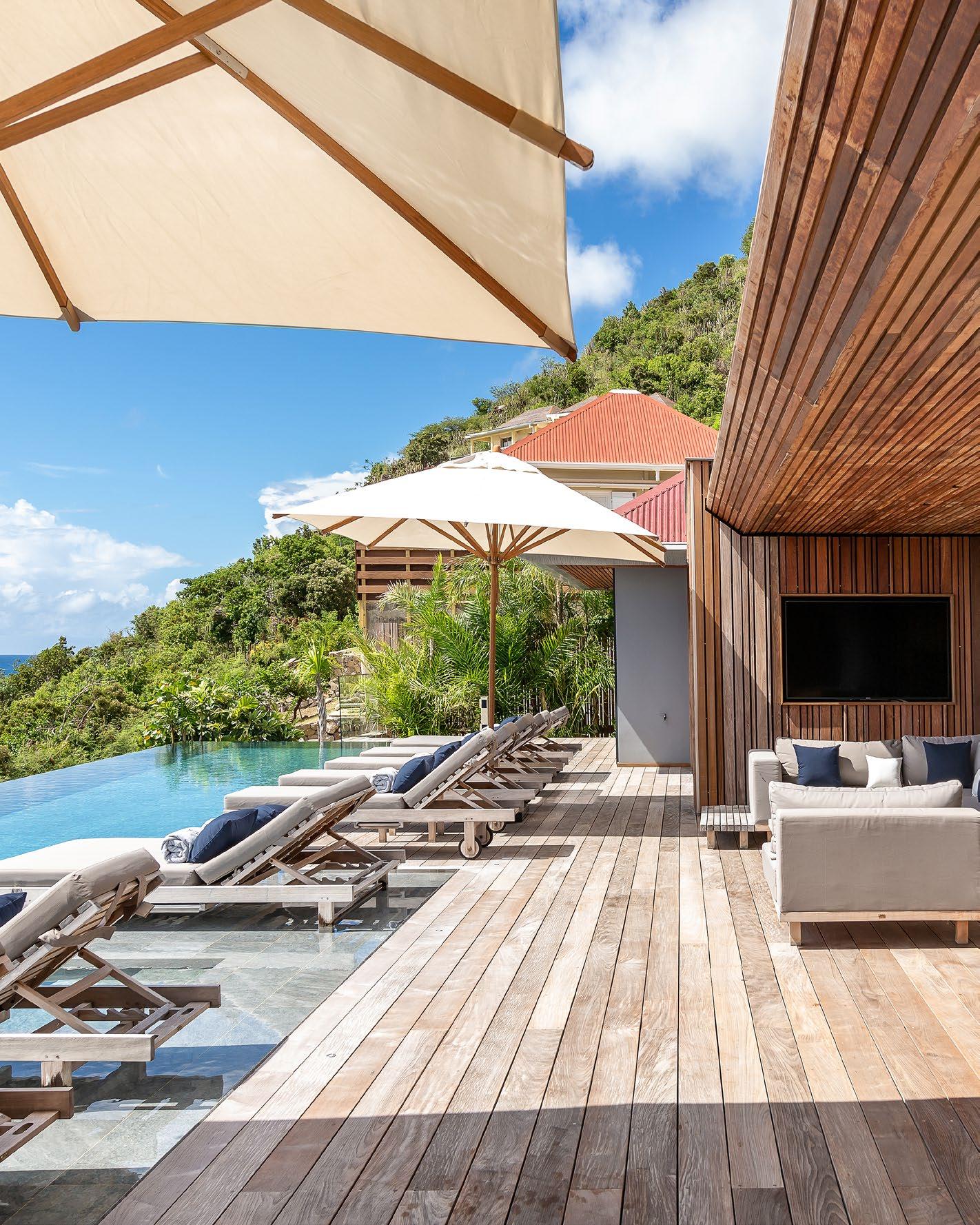
The expedition yachting trend is far from slowing down – in fact, our appetite for exploration is bigger than ever. We set sail to find out more…
Words:
Rory FH Smith

Think of yacht charters and most minds will conjure up images of a dazzling white superyacht bobbing majestically in an Italian inlet or off the coast of Ibiza, the Cote d’Azur or Greek Islands. And they wouldn’t be wrong – that’s where the vast majority of these floating palaces still reside each summer. But there’s a small but growing yacht charter contingent up to something much more interesting.
“Clients are becoming more curious about destinations outside that traditional Mediterranean and Caribbean milk run,” says Guy Mannering, retail charter broker at Cecil Wright. “There’s certainly a growing appetite for itineraries that feel a bit more unique.”
But that might be a bit of an understatement if Guy’s stories are anything to go by. The former captain of yachts measuring up to 50m speaks of expeditions to Antarctica, Patagonia, Greenland and
remote parts of Indonesia.
“Even within the Med and Caribbean, people are asking far more detail in their itinerary than they have done before, to make sure they’re seeing places that are slightly off the beaten track,” he adds. “A lot of younger members of the families that are pushing their parents to break out the norm and do more adventurous trips. I think social media is probably playing a big role in that.”
Beyond Guy’s personal experience, there are clear signs that the yacht market is becoming more audacious, with a significant rise in the number of adventure-ready explorer yachts being commissioned.
According to a report from brokerage Smart Yachts earlier this year, the number of explorer yachts in production has nearly doubled from 58 in 2020 to 105 in 2025, with an estimated 786 explorer yachts in
existence around the world.
“Even the term explorer yacht makes you think: where else can we go? And what might be interesting?” asks Guy. “If it’s got a submarine on the back of the yacht, then what exactly are we going be seeing if we charted a yacht like that?”
While regular yachts can access some remote corners of the globe, explorer yachts are particularly well suited to it. Equipped with large fuel tanks for long-distance cruising, Ice-class or double-skin steel hulls, large garages for equipment, raised helms for better visibility (ideal for spotting icebergs), as well as deep steel hulls for handling rough seas and helicopter decks for remote access, explorers are the yacht of choice for many wanting to sail on the wild side. »
cecilwright.com

THE LOCATION: PATAGONIA & ANTARCTICA
Given the relative proximity of these two remote wildernesses, the ultimate expedition that takes in peaks of Patagonia at the tip of South America and the biting cold of Antarctica (right) is a charter between the two. “For me, it's the ultimate thing that you could ever do in terms of Expedition style travel,” says Guy. Charters can comprise of sailing around Patagonia before taking a private jet to King George Island in Antarctica, and then using the yacht as a base for further on-land expeditions and activities like heli-skiing. “Other than going into space or beneath the ocean, you can’t get more remote in terms of an experience,” adds Guy.
The rugged 45.6m explorer yacht was first built in 1988 as a Dutch trawler, before being converted in 2023 as a yacht fit for exploration. Sleeping 10 guests in five staterooms with eight crew, the steel hulled, hybrid-electric Scintilla Maris has a 9,000 nautical mile range, which is ideal for covering off large distances in remote corners of the world. Fit for operating in icy, cold regions, it has high vantage outposts, which are well suited for wildlife watching, such as whales, birds and awe-inspiring icebergs.

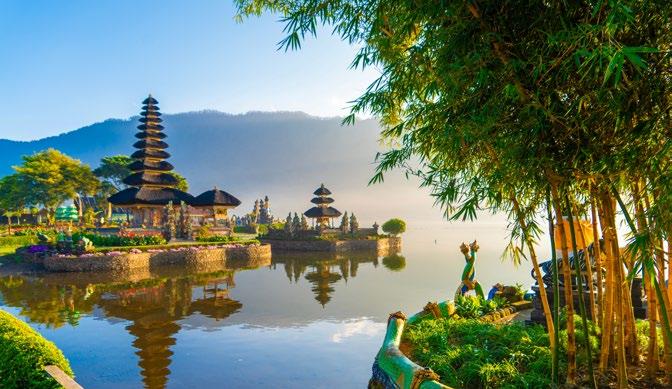
THE LOCATION: GREENLAND, ICELAND & NORWAY
“Greenland (along with the Norwegian fjords) is very under-explored, always quiet, and yet offers the chance to see polar bears, whales, and the Northern Lights [right] – especially in the summer,” says Guy. When it comes to dramatic scenery, you’d be hard pushed to beat the region's numerous waterfalls and towering fjords.
THE YACHT: KING BENJI
At 47m, explorer yacht King Benji was built in 2024 by Dunya Yachts. With enough room for 10 people in five cabins, including a full-beam master suite, Benji is well suited to carrying the equipment needed for extreme exploration, with a huge aft deck 10tonne crane. In addition, the yacht features a hot and cold plunge pooljacuzzi, sky lounge, dedicated observation pod and a whole host of kit to use in the water.
For those seeking warmer climes, look no further than Indonesia and its 17,000 islands, many of which are remote and uninhabited. From wild Komodo dragons, to beach life in Bali, and diving in remote crystal-clear waters, Indonesia (left) is a sun-drenched spot ripe for exploration. “I’ve cruised into similar areas myself, and the waters are just crystal clear for perfect conditions for using submarine,” says Guy. “Having a yacht that can go there and also host people on board with all these bits of kit and toys stored away is ideal.”
Despite its ice-classed hull, La Datcha is an ideal yacht for exploring the deep blue around the Indonesian islands, with its three-person submersible, two helicopters, sauna, gym, observation lounge and helipad. With enough room on board for 12 people across six cabins, the 77m yacht was built by Damen Yachting in 2020.

THERE IS A GROWING APPETITE FOR ITINERARIES THAT FEEL UNIQUE
— Guy Mannering, Cecil Wright
Riding the wave: Expedition yachts for charter, such as the Arience (previous) and King Benji (right, ©Jeff Brown), offer the most adventurous yachting with a wealth of luxury amenities



Renowned Highland single malt producer The Dalmore unveils the highly anticipated third instalment of their Cask Curation Series, The Red Wine Cask Edition. Launched in 2023, the Cask Curation series was born to celebrate the distillery’s time honoured and innovative approach to cask selection, tracing its artform back to 1868. Their particular focus on sourcing casks from the world’s finest wineries realises itself in this latest release, which is sure to excite those acquainted with Château Mont-Redon, the visionary winemakers from the Châteauneuf-du-Pape region.
Now in its fourth generation of family management under Pierre Fabre, the estate’s characterful wines benefit not only from their distinctive soil composition and pebbled landscape, but also its blend of grapes resulting in complex layers of flavour that pair beautifully in enhancing The Dalmore’s single malt whisky.
This 2025 edition of three bottlings from The Dalmore embodies a 24, 34, and a stunning 43 Years Old single malt whisky, all finished in 2023 Châteauneuf-du-Pape wine casks from the Mont-Redon estate. At 24 Years Old, expect notes of crème brûlée and hints of dark toffee, with an extra decade adding subtle floral notes and hints of Seville orange at 34 Years Old, before progressing to dark chocolate with hints of honeyed mango and warming spice at 43 Years Old, completing a trio of rich and complex single malts.
The Dalmore’s Master Distiller, Richard Paterson, describes the bottlings as: “A wonderful journey of discovery, to see how different aged and rare whiskies can be subtly enhanced by this red wine. The three single malt whiskies within this edition of Cask Curation Series, are, in my opinion, the pinnacle of red wine cask curation.” This devotion to using wine casks is apparent not just in the distillery’s ultra limited offerings presented here, but also in approachable core expressions like The Dalmore Cigar Malt Reserve and King Alexander III, both of which feature Cabernet Sauvignon wine barriques in the maturation journeys.
Consistent with previous releases in the series, the Red Wine edition comes presented in a bespoke carry case that doubles as a platform for display, hand crafted by Italian luggage makers AB Florence in a bold lapis blue, inspired by the hue of ripening grapes on the vine at Château Mont-Redon.
150 sets are available globally from 1 October. For more information visit thedalmore.com/caskcuration
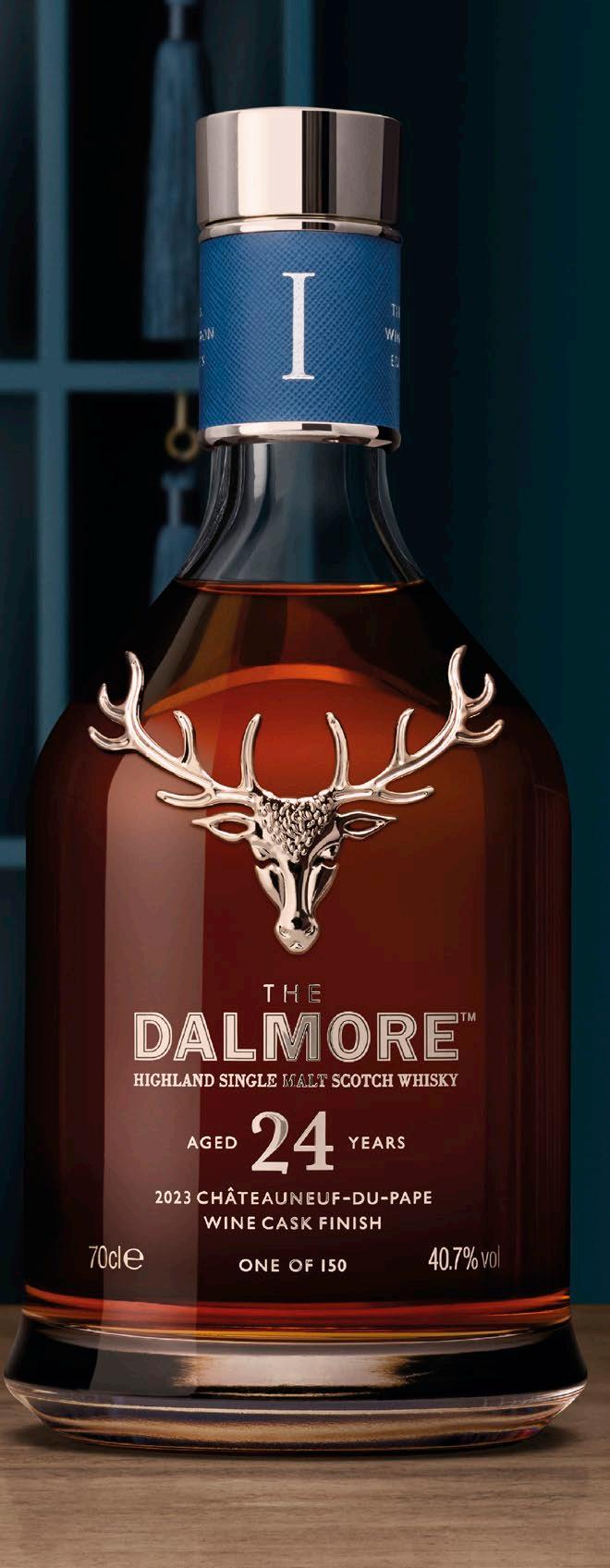
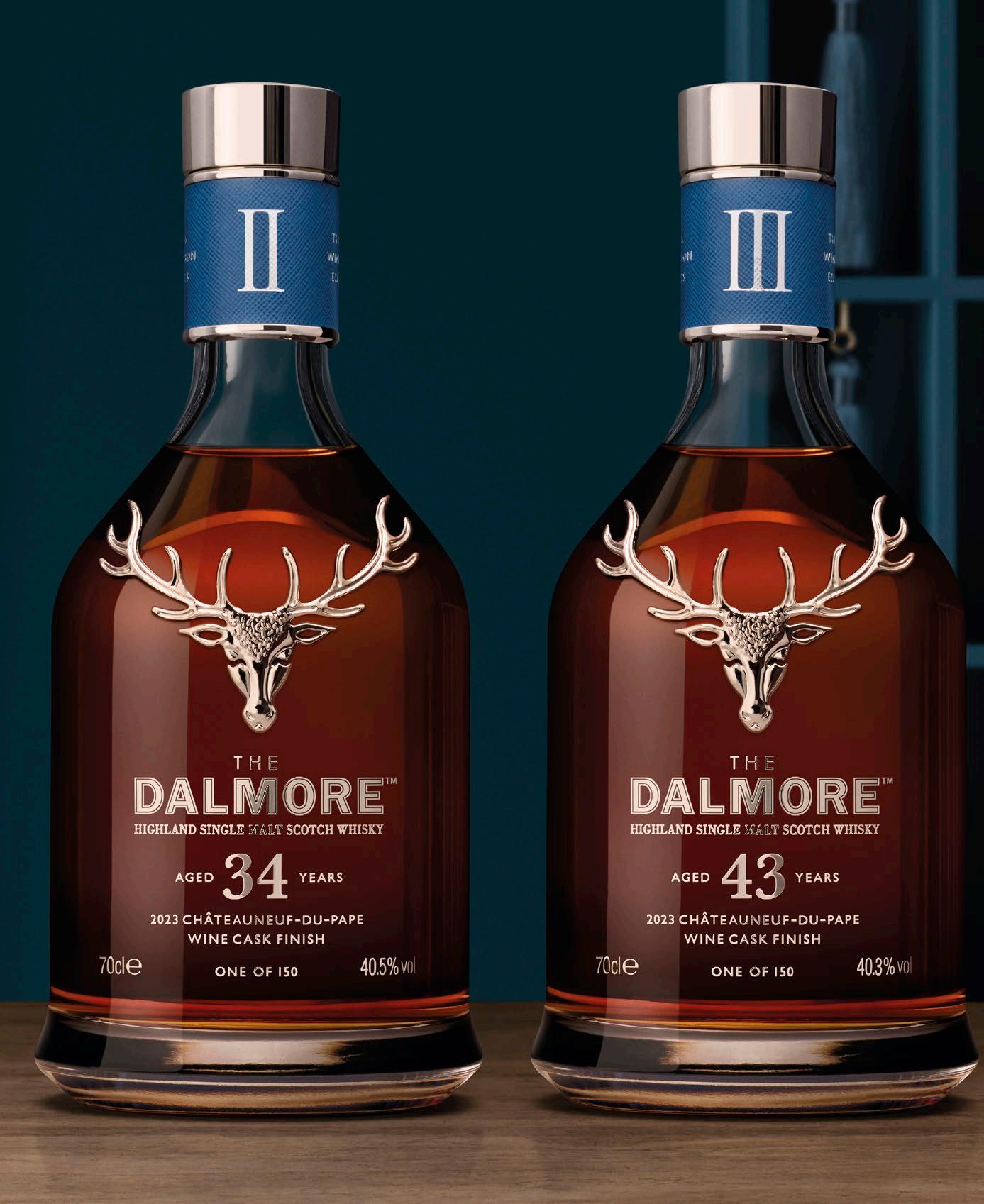
70 years after the first Far Eastern Expedition, we put the new Land Rover Defender Octa to the test
Words: Rory FH Smith
One can only assume there must have been a few drinks involved when six Oxford and Cambridge students first dreamt up the audacious Far Eastern Expedition in 1955. The 18,000-mile adventure through Europe, the Middle East, India and Southeast Asia would see two identical, early Series 1 Land Rovers and their six plucky occupants set off from Hyde Park in London and arrive in Singapore six months and six days later. While the expedition had previously been considered impossible, the students proved it could be done and, perhaps more importantly, cemented Land Rover’s reputation as a rugged and seemingly unstoppable force over land. Since then, the Land Rover’s repository of off-road accolades has grown substantially,
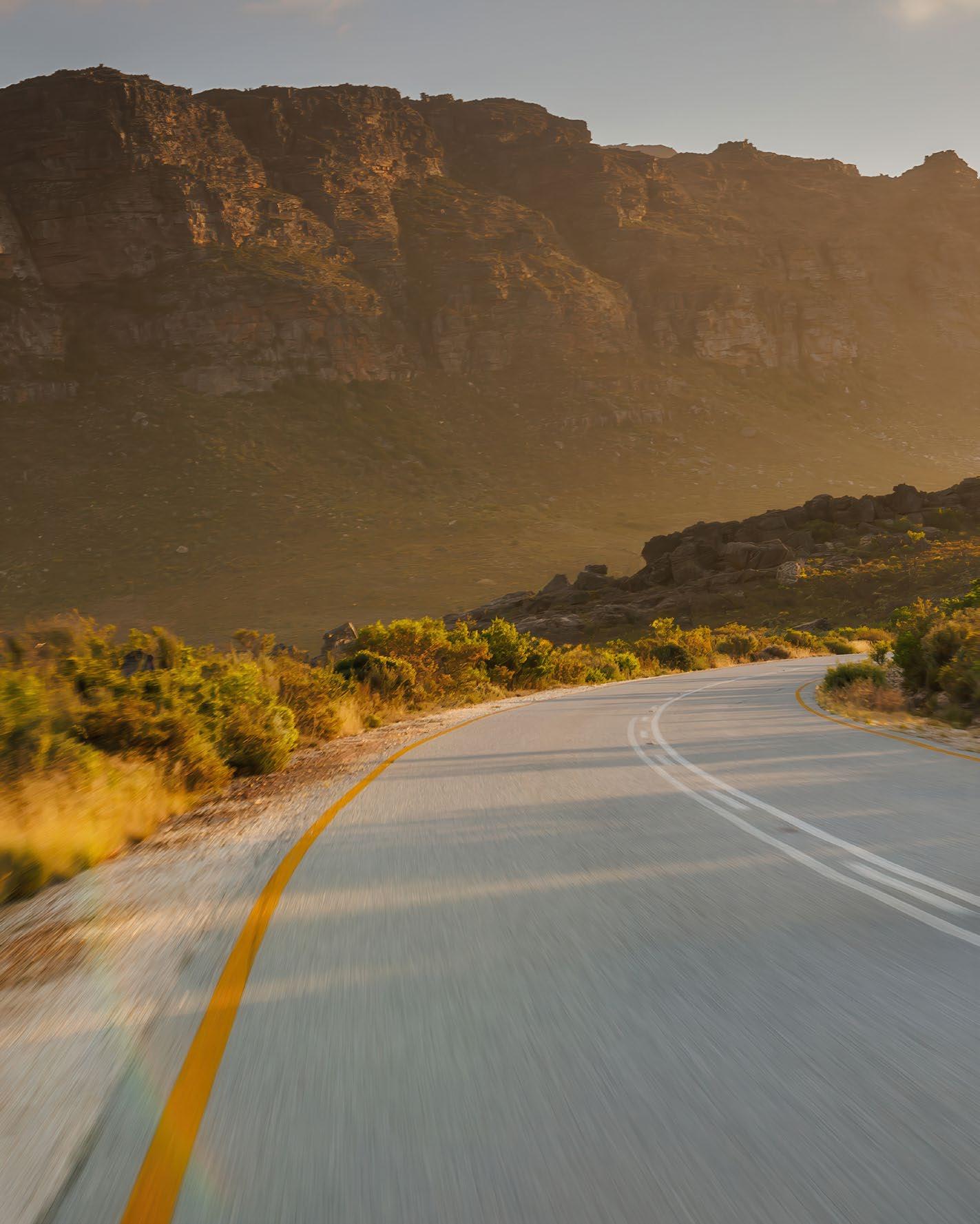
with the much-loved British vehicle providing the backbone for expeditions across vast and often uncharted swathes of the world. When the Land Rover range expanded beyond the original series models, so did the scope for adventure, giving rise to competitions such as the Camel Trophy which ran from 1980-2000 and was dubbed the “Olympics of 4x4” as teams battled it out in their Land Rovers through jungles, mountains and swamps.
The Land Rover G4 Challenge continued to up the ante from 2003 to 2008, by combining offroad driving with outdoor sports. Now, in 2025, I’m about to take part in the latest chapter in Land Rover’s voluminous book of adventures, driving its latest model, the Defender Octa, 500 miles on and off road through the South African bush. »

While its cryptic name might conjure up images of covert operations, the Octa moniker is actually derived from the eight-sides of a diamond – one of the hardest and most desirable minerals on earth. Think tough yet luxurious and you’re pretty much on the money when it comes to the most performance-focused – and expensive –Defender yet. With the launch vehicle, Edition One, priced at £160,800, and the “regular” Octa valued at £145,300, it’s not for the faint-hearted. On first approach, it doesn’t look too different from its Defender siblings, but don’t be fooled by its subtly enhanced looks: the Octa is a different beast from any Defender that went before it.
On closer inspection, it is 68mm wider than the “standard” Defender, 28mm taller and a whole lot tougher. The blistered wheel arches, functional rims, deeper grille and flecks of chopped carbon fibre hint at the Octa’s real party piece buried deep inside the bodywork – a BMWderived 4.4-litre twin turbo V8 that produces 626bhp. On paper, it’s enough to propel the twoand-a-half tonne Octa to 62mph from standstill in just 3.8-seconds and onto a limited top speed of 155mph. In the South African bush, these figures are really brought to life.
Our adventure starts in glorious Cape Town, which appears to be the spiritual home of Land Rovers past and present. Here, the sheltered and sun-drenched streets around the V&A Waterfront are awash with beaten up old Defenders, carrying battle scars from previous expeditions into the bush. My spotless Octa looks a little out of place by comparison but all that’s about to change.
After making a swift exit from Cape Town, it’s not long until we’re exposed to the wide, open expanse leading up to the Cederberg Mountains, north of the legislative capital. Like a blend of the Scottish Highlands, the towering mountains of the Alps and the orange, rocky outcrops of US states like Colorado and Utah, the landscape is mesmerising but punishing on the Defender’s underpinnings.
Thankfully, the Octa comes equipped with a “trick” 6D suspension system, the same one found on the latest Range Rover Sport SV. Soaking up the spine-shattering lumps and bumps of the potholed dirt tracks that weave their way up through the red rock of the Matjiesrivier Nature Reserve, we glide along with all four wheels firmly planted on the ground for maximum traction, while everything remains calm, cool and comfortable in the cabin.
Far from civilisation, there’s no shortage of dead straight stretches of dirt track and roughly paved roads on which to test the Octa’s performance credentials. Off the line, the Octa is by all means a fast car but it’s one step removed from the frankly bonkers way cars like the Mercedes-AMG G 63 or Aston Martin DBX 707 deliver pace. It’s more refined and grown-up and, crucially, more intelligent in the way it drives. The Octa
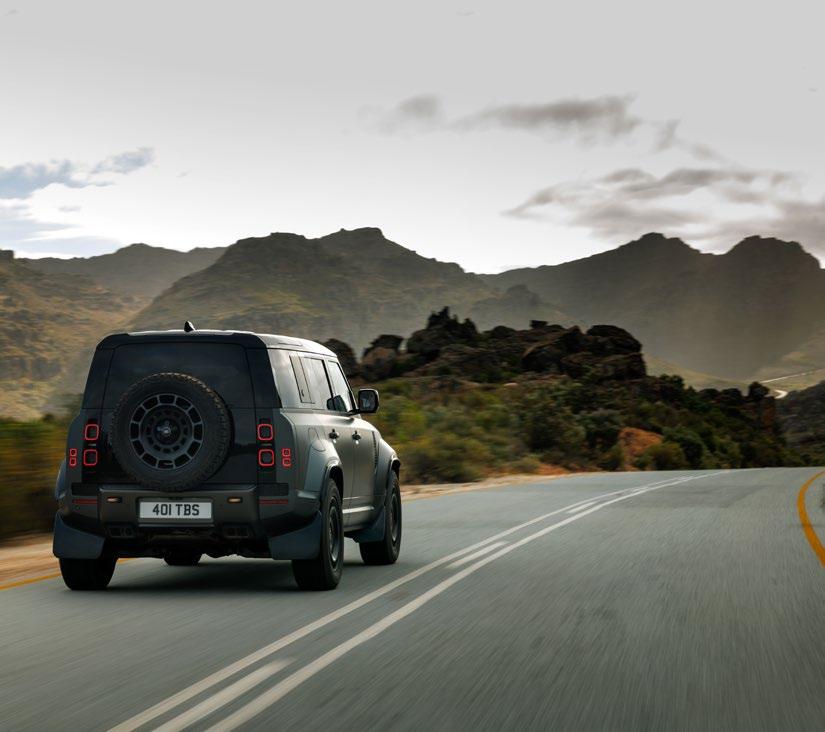
DON’T BE FOOLED BY ITS SUBTLY ENHANCED LOOKS: THE OCTA IS A DIFFERENT BEAST FROM ANY DEFENDER THAT HAS COME BEFORE
hammers over rough ground and holds its own around bends at breakneck speed like no other car could, despite loose surfaces, rocks and ruts.
It’s remarkably capable and comfortable, particularly when equipped with a chunky set of tyres. Its ability to accept hard knocks and shocks is unrivalled and it has the pace and performance of a high-riding rally car but with many of the creature comforts you’d expect to find on its Range Rover cousin.
After a long and hard day’s driving, we arrive at the Bushman’s Kloof retreat, an oasis set amid the wilderness, 20 miles southeast of the town of Clanwilliam on South Africa’s western flank. Here, everything from kudu (African antelopes) to Cape Mountain Zebras, ostriches and wildcats roam around the collection of charming, colonial-style villas. Despite spending all day dashing over terrain that would typically shake the screws

out of most vehicles, the Octa is unfazed, albeit covered in a thick layer of the South African bush.
While the Octa’s ancestors might have tackled far greater distances than my adventure up the western side of South Africa, they did so at a fraction of the speed and comfort. Sure, today’s regular Defender could complete the same journey, but it wouldn’t be as comfortable nor as capable as its soupedup sibling. And while the top-end Octa is a good £100,000 more than the car on which it’s based, it is a rare and hugely fun example of a practical, high-riding sports car that can go anywhere and do anything. In a world where we’ve reached peak performance on the road, perhaps it’s time more carmakers channelled their inner Octa and opted for the road less travelled to have some fun.
landrover.co.uk




We sit down with Formula 1 champion and world number 1 racing driver Max Verstappen on the eve of the Monaco Grand Prix to find out the secret behind his winning mentality
Words: Ming Liu
Wearing blue jeans, a blue cap and a navy polo that’s loud with the livery and logos of the Red Bull Racing Formula 1 team, Max Verstappen (right) is sitting cool and collected in a deck chair in Monaco. The four-time F1 world champion is looking as relaxed as ever, blending into the back-drop of Monaco’s famed Port Hercules, with its backdrop of Belle Époque architecture and terracotta roofs pitched towards a Mediterranean sky of dusky pinks and purples. Sailing boats, cruise ships and superyachts bob on the horizon behind him.
It’s nearly 6pm after qualifying day at the Formula 1 TAG Heuer Grand Prix de Monaco when Tempus sits down with the Dutch driver. Max first won the historic race in 2021, then went on to defend that title in 2023 against Fernando Alonso through wet and unpredictable conditions – and now he’s fresh from the latest qualifying race, coming in at fourth place (but in fact had earned fifth, only to be elevated after a penalty on British rival driver Sir Lewis Hamilton, but that’s another story…).
Tomorrow is race day and Max Verstappen is talking about pressure. Or rather, the lack of pressure.
“I don’t really think about it too much,” he says. “I always have the same kind of mindset before I go into a weekend. I just see what happens [and] am quite relaxed about it all. I’m confident that when I sit in the car I’ll extract the most I can out of it… I know how to prepare myself in the best way possible. Some weekends go better than others, that’s something that you have to accept.”
If the 27-year-old champion sounds almost unfazed about preparing for what is F1’s most glamorous and high-profile race, that’s because his runaway success and experience seems completely and seamlessly entwined with his being. His stardom feels as if destined from day one. Born in Hasselt, Belgium to the son of former F1 driver Jos Verstappen and ultra-cool karting mum Sophie, the Dutch-Belgian racing driver had an early career imprinted with a succession of firsts and frankly eye-popping wowmoments. At age eight, Verstappen hit
his first major competition with the mini category championships, where he won all 21 karting races in Belgium. By 16 he was turning heads with whiplash-like effect, debuting at the FIA F3 European championship where, after winning his sixth race, went on to score an incredible six consecutive victories, placing him third in the overall ranking. At 17, Max was Formula 1’s youngest ever competitor –and became the youngest ever race winner at the age of 18 years and 228 days.
Still a teenager in 2016, and following a victory in Spain, Max was promoted only after four races from Scuderia Toro Rosso to the main Red Bull Racing team. His star continued its ascent, with the dominating, career-defining years of 2022 and 2023, followed by a strong title defence in 2024. Today, the four-time world champion is nipping at the heels of legendary record holders Juan Manuel Fangio, Michael Schumacher and Lewis Hamilton, and boasts 45 pole positions, 66 Grand Prix wins, 119 podium finishes and more than 3,200 career points to his name. »
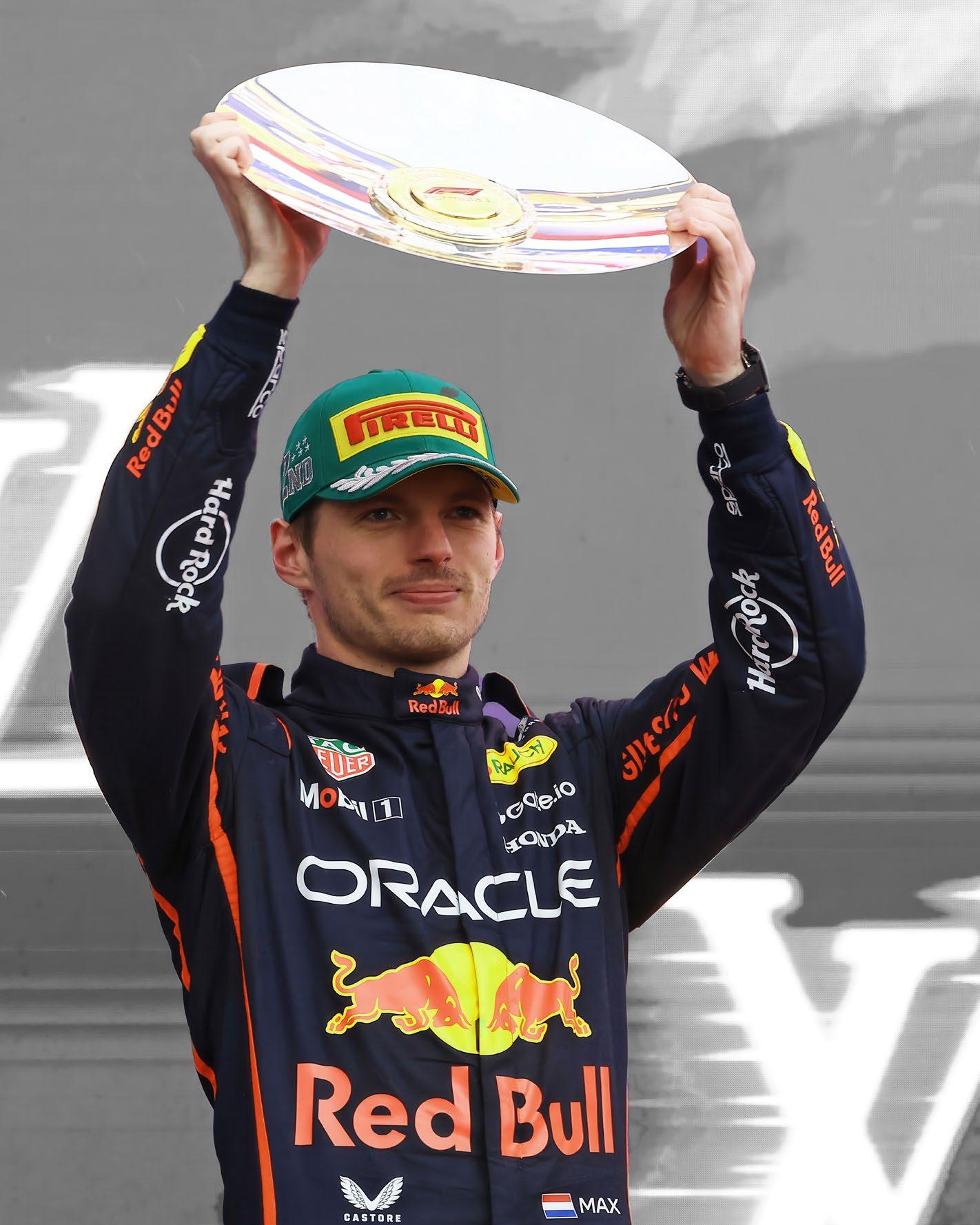
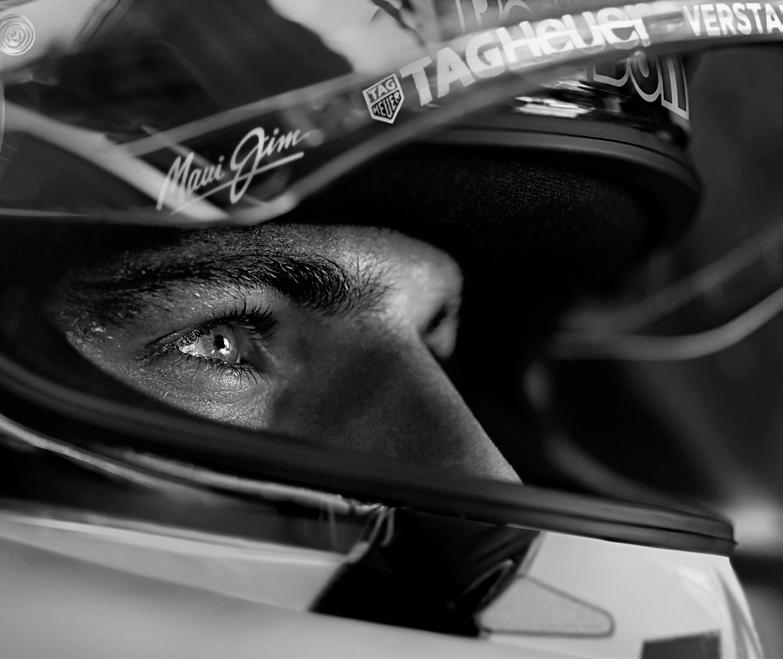
This year Max is coming up to 10 years with Red Bull Racing, which he says is a place that, “I can just be myself, which is most important.” To him, the team feels like family. “You build up friendships and relationships with a lot of people that have been part of the team for a long time.”
Adding to that extended family is the Swiss watchmaker TAG Heuer. Max is, fittingly, wearing his square-shaped TAG Heuer Monaco Split-Second chronograph, a special customised watch that was gifted to the driver during the Monaco Grand Prix last year. An avant-garde timepiece both inside and out, the chronograph features a sophisticated rattrapante complication and comes encased in ultra-light grade-5 titanium with wall-to-wall sapphire for extra visibility and ergonomy, not to mention ultra-cool good looks. The watch’s two subdials have been notably customised, which required 12 hours of work. Etched on the chronograph hour display are the words “World Champion” and three stars, representing 2021, 2022 and 2023, the years Verstappen held the title (the sapphire dial also features his number: 1). Meanwhile the minute counter features his name, paired with a subtle rendering of his beloved symbol of a lion’s head.
“I’m very proud to wear this watch, it’s very iconic,” says Max. “Plus of course there’s the people you’ve worked with along the way, between TAG Heuer and the team. This is a partnership that’s always been very nice, open and enjoyable – we’ve done some cool things.”
TAG Heuer this year has notably upped the ante on its F1 partnership. After being Official Timekeeper of the sport in the 1990s, the esteemed brand has resumed that role this year – as its parent company LVMH has signed a decade-long global partnership with F1, taking over from Rolex. And all this in the year that Formula 1 celebrates its 75th anniversary.
TAG Heuer is timing all 24 races in the 21 countries on the F1 circuit, but there is something uniquely mythical about Monaco in particular, says Antoine Pin, TAG Heuer’s chief executive. Speaking on the eve of the Monaco race, Antoine explains there is of course the glamour of Monte-Carlo itself, but also the TAG Heuer Monaco watch, which was first immortalised by Steve McQueen in the 1971 motor racing film Le Mans
And, continues Antoine: “We are also celebrating Formula 1, which probably is the most mythical modern sport today, where drivers are fundamentally the modern heroes of chivalry. They are defying that at every moment, ready to push their limits.” »
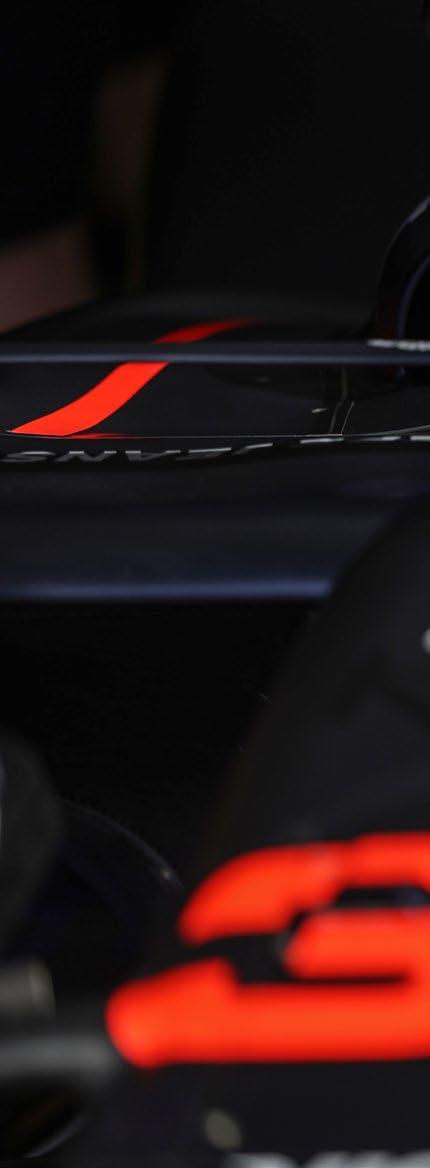
Champion mindset: Max Verstappen in action (above); and (right) the TAG Heuer Monaco collection honours racing legends – and legendary fans – such as Steve McQueen

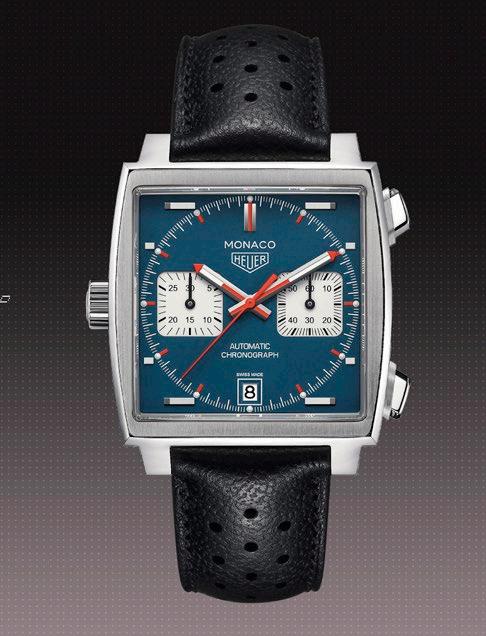
I ALWAYS HAVE THE SAME KIND OF MINDSET BEFORE I GO INTO A WEEKEND... I’M CONFIDENT THAT WHEN I SIT IN THE CAR I’LL EXTRACT THE MOST I CAN OUT OF IT
Race for the finish line: TAG Heuer becomes the Formula 1 Official Timekeeper (main and below); Max Verstappen prepares for victory (right)
TAG Heuer is marking its evolving role in F1 with a new tagline, ‘Designed to Win’, which Antoine points out is about celebrating the potential to accomplish success. The idea speaks to crafting and exploiting one’s capabilities and talents to achieve a goal –something that Max embodies naturally.
With the race set for the following day, how important is winning to Max? His reply is contemplative and balanced, much like the man himself: “Everyone likes winning but, when you’re not winning, I think you have to understand why. Or how it happened,” he says. “At the end of the day, that’s what this sport is about… everyone is here to try and win.”
(The Dutchman would go on to take fourth place in Monaco, followed by a summer of podium wins in Montreal, his home turf in Zandvoort, and Monza. Singapore is up next in October).
Since he started karting at age six, Max’s rise to the top of the sport has been played out in the public eye – and never more so than in recent years, thanks to the blockbuster success of the Netflix series, Drive to Survive. With the drivers dubbed the “Kardashians of Formula 1”, Max has notably much less airtime than others on the show, a fact that seems more deliberate than accidental – and which has landed descriptions of Max as being aloof and distant. But one gets the sense that he is consciously protecting his own space and time, mentally and physically. After all, everyone wants a piece of the four-time champion and one of the greatest drivers the sport has ever known.
But as Max told a journalist at Red Bull earlier this year: “I’ve worked my whole life to be successful in racing, and while that’s very important to me, at the end of the day, it doesn’t define real happiness,” he said. “True happiness comes from your friends and your family and your loved ones.”
In May, Max became a father, and one senses that he will guard that precious family time even more fiercely. He’s a Monaco resident, where he is in good company with F1 stars past and present. But for Max, flash, fame and glory were never his thing, and he appears more grounded than ever.
“I prefer to be very private and just live my life,” he tells us. “So whatever I do here, once I come home, I just want to spend time with my fami-ly, my friends and do my stuff. I’m not out there to be seen – and I don’t want to be seen.”
f1.com; tagheuer.com




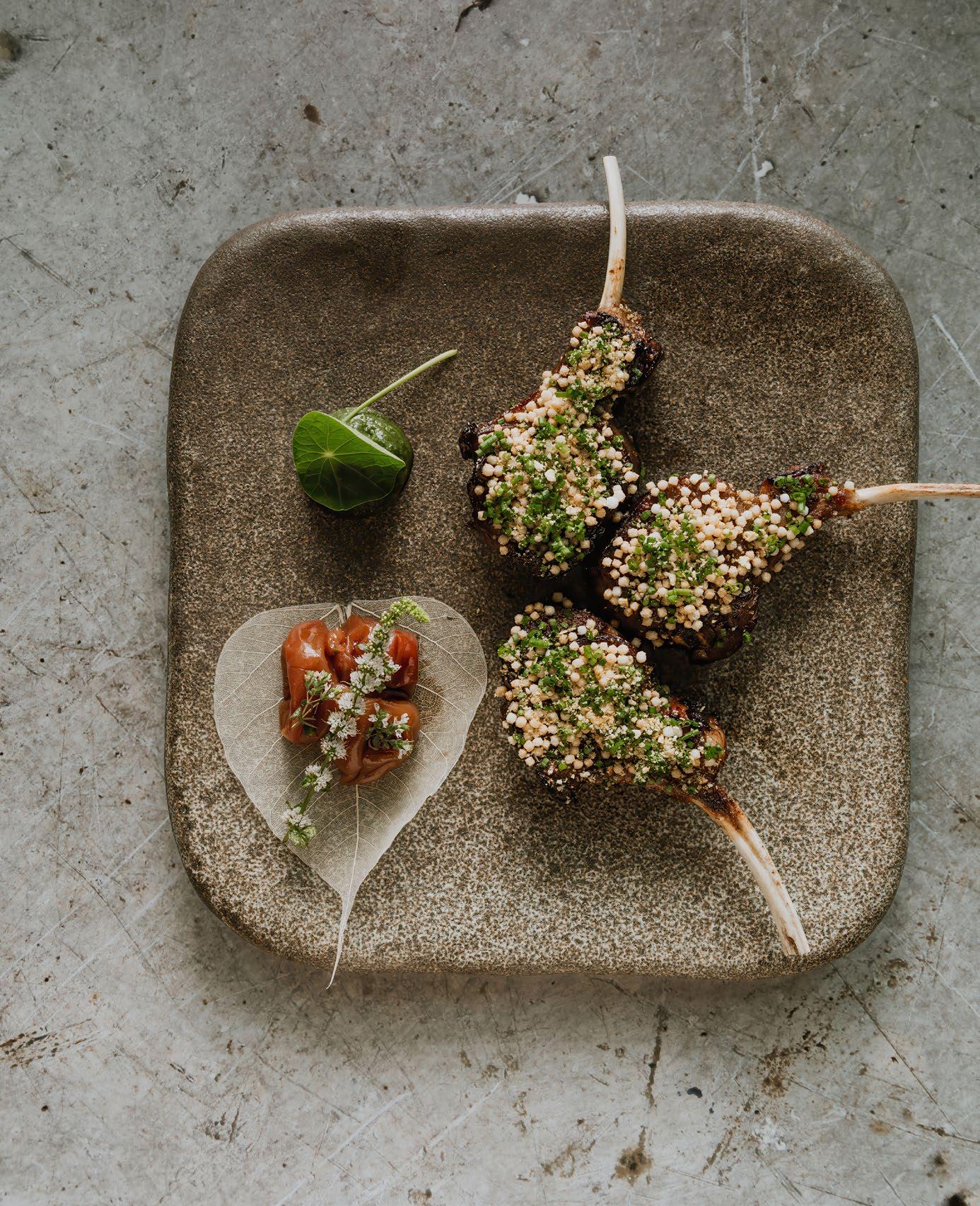
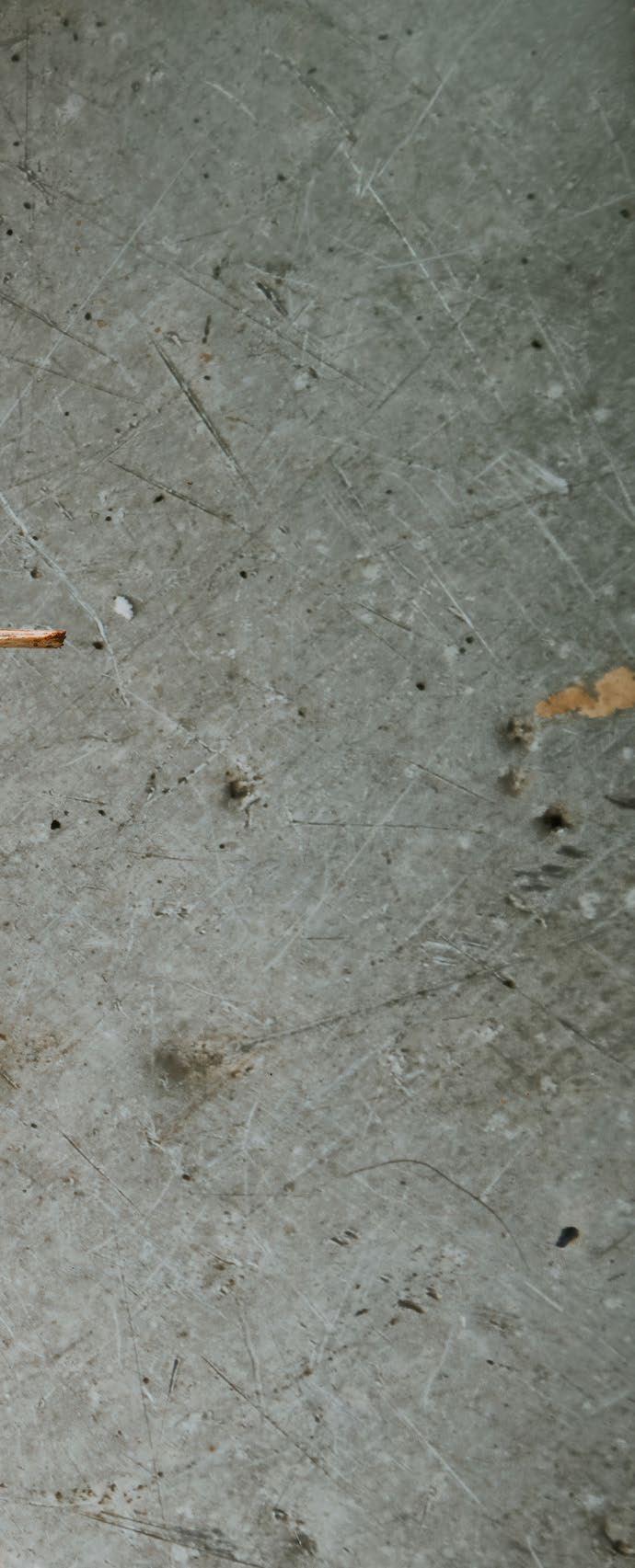
Brand new Aki London brings EuropeanJapanese fusion and Kyoto-inspired farmto-table cuisine to Cavendish Square
Launched in September to palpable excitement from London’s fine dining set, renowned Malta restaurant Aki opened its first international outpost at the Grade II-listed One Cavendish Square in London. The restaurant’s farm-to-table concept draws inspiration from Kyoto, Japan –with the restaurant’s chefs even growing their own Japanese ingredients in specially built micro-farms, and combining these exceptional flavours with a Mediterranean twist.
Standout dishes on the new menu include Tuna tartare with Japanese brown puffed rice, aged soy, and caviar (served dramatically on an ice plate); Wagyu tataki with Japanese beer mustard pickle, truffle, brown butter, and crispy leeks; hay-smoked scallop with tofu and fennel cream, fuji apple tosazu jelly, myoga, and hanaho; and natto and yuzu-marinated lamb with ume boshi and house-made herb miso.
The restaurant’s décor, designed by Francis Sultana, is inspired by the Japanese Screens exhibition at the Metropolitan Museum in New York, letting Japanese influences take centre stage while complementing the classic European elegance of the building.
Aki London’s sister restaurant, located in Maltese capital Valletta, has held a place on the Michelin Guide for four years – a high bar that CEO Robert Debono is certain London’s newest restaurant can meet. Here, Robert shares Aki’s journey from Malta to London. »
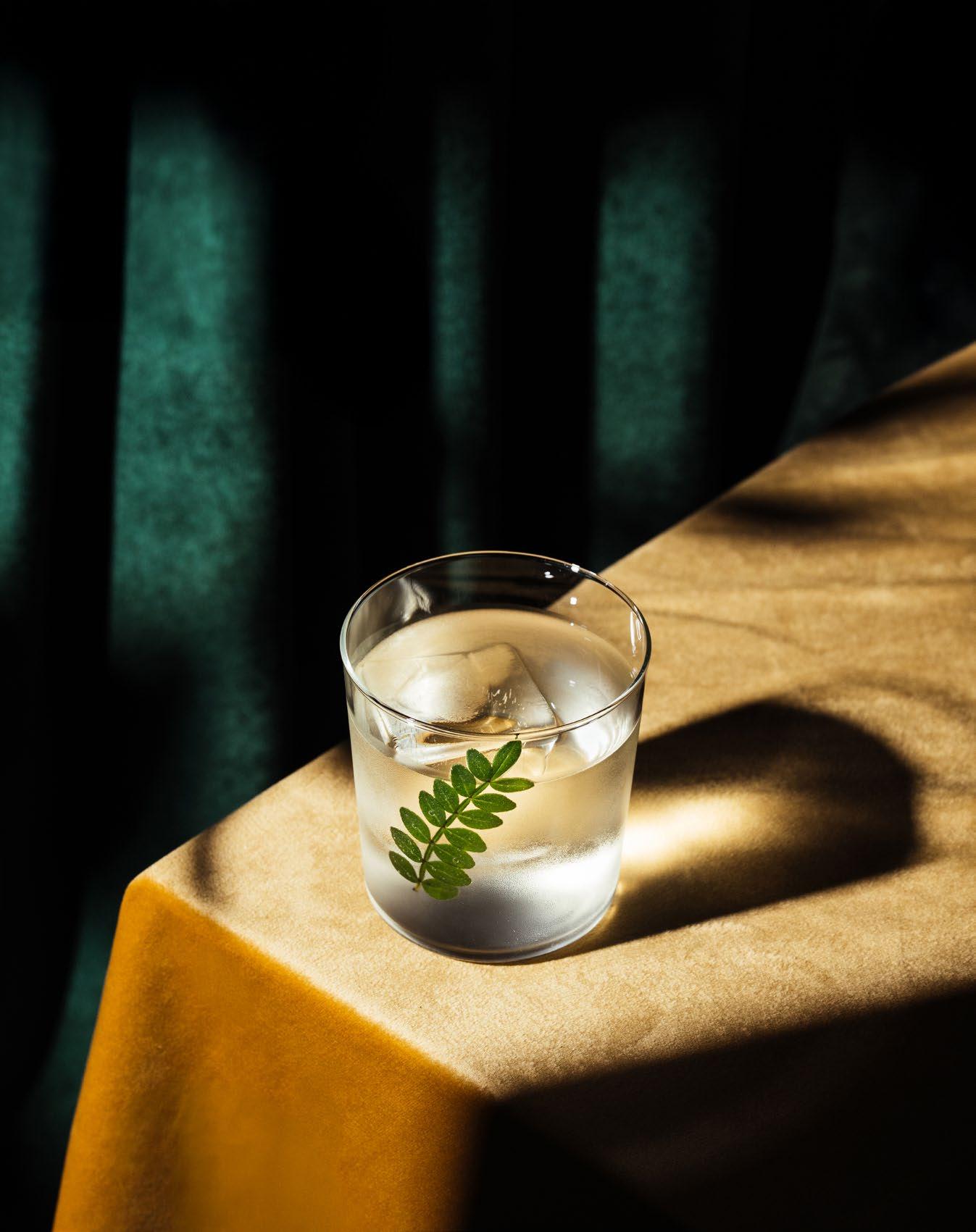
GUESTS MIGHT COME FOR THE CUISINE, BUT WE HOPE THEY LEAVE FEELING LIKE THEY’VE TAKEN PART IN A CULTURAL MOMENT
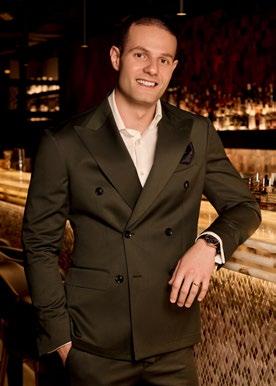
Robert, tell us about launching Aki’s first international outpost in London?
London is one of the greatest cities in the world and, for us, it represents the ultimate test. It’s home to some of the most dynamic and competitive restaurant brands globally. Aki has been a great success in Valletta, but London allows us to bring our philosophy to an international stage. This is just the beginning – we see London as the foundation for our global expansion, and our aim is to have a handful of restaurants across the capital in the coming years.
What differences have you found between Maltese and British tastes?
I think both Maltese and British diners are adventurous and curious – they want to be surprised and delighted, but they also value authenticity. The difference in London is scale: the audience is vast, sophisticated and used to an incredible range of international cuisines. That raises the bar, and that’s exactly the challenge we were looking for. For us, it’s about bringing Japanese precision, a subtle Maltese soul, and doing it with integrity in a city that demands the very best.
One Cavendish Square is an iconic venue. Tell us about choosing this location?
We knew that if we were going to launch in London, it had to be somewhere with heritage and presence. One Cavendish Square gave us that: a Grade II-listed former banking hall right in the heart of Marylebone. It had the grandeur we wanted, but also the intimacy to create different moods across the spaces. Over the past two years we’ve invested £15m to transform it into something that balances European elegance with Japanese artistry. It’s been a journey of respect: for the building’s history, for Japanese culture, and for the future of our brand.
Did the renovation present any challenges?
Working with a listed building always presents
challenges, because you want to respect and preserve the building s heritage while making it fit for a modern hospitality experience. The scale of the ceilings, the restrictions on what could be altered, and the sheer logistics of transforming an old banking hall into a restaurant and bar – all of that was complex. But, in the end, those challenges became opportunities. They pushed us to think creatively, and with Francis Sultana’s vision, we were able to achieve a space that feels both historic and completely contemporary.
How would you describe the impact of the restaurant’s décor?
The décor sets the emotional tone. It creates a sense of anticipation the moment you walk in, and then intimacy once you settle at the table. The design is a dialogue between cultures. Francis Sultana drew inspiration from Japanese screens and decorative traditions, but he placed them within the grandeur of a Georgian hall. You’ll see plaster trees rising to meet soaring ceilings, cloud motifs drifting across the walls, and kimono fabrics adding warmth and texture. For me, the overall impact is harmony, a sense that European heritage and Japanese refinement can live together beautifully in one space. People often tell us they feel transported, and that’s exactly what we wanted to achieve.
Aki London offers multiple spaces for guests to enjoy. Could you walk us through these?
The main dining hall is dramatic, it’s our grand stage, seating 80 guests under soaring ceilings. Then you have the private dining room upstairs, which is intimate and immersive, with hand-painted Japanese landscape frescoes done in a European style. Finally, downstairs in the former bank vaults, is our late-night bar. Each space has its own identity, but together they create a journey, from refined dining to private celebration, to late-night energy.
Tell us about Aki London’s impressive contemporary art collection?
The Aki Collection was never meant to be just decoration, it’s a cultural experience in its own right. Polina Sulina and Virginie Puertolas-Syn have curated works from some extraordinary artists, including those connected to the Venice Biennale. We’re proud to present Daniel Knorr, Kapwani Kiwanga, Nabil Nahas, alongside names like Ryan Gander, Yoshirotten, James Clar and Aziza Kadyri. Together, they bridge past, present and future in a way that elevates the whole dining experience. Guests might come for the cuisine, but we hope they leave feeling like they’ve taken part in a cultural moment.
Please tell us about your signature dishes and key flavours?
Our menu celebrates Kyoto’s farm-to-table ethos. You’ll find dishes like tuna tartare with puffed Japanese rice and caviar, or hay-smoked scallop with tofu and fuji apple jelly – each designed to balance authenticity with innovation. The flavours are seasonal, bright and precise, thanks to techniques like in-house fermentation and fish-to-tail cooking. We aim to let the ingredients speak, but with a contemporary twist that makes the experience unforgettable.
Aki London has 80 in-house micro-farms – what does this mean for both flavour and environmental impact?
Having 80 in-house micro-farms is a gamechanger. It means we can harvest rare Japanese herbs, seaweeds, and other ingredients moments before they reach the plate. The flavours are more vibrant, more authentic, and more alive. But it’s also about sustainability – by growing locally in recyclable substrates without pesticides, we dramatically reduce our carbon footprint. For us, it’s proof that you can deliver world-class flavour while being responsible to the planet.
akilondon.com
As Italy surpasses France and Japan as one of the world’s most visited luxury destinations, we take a tour through some of our favourite areas of this diverse and delightful country


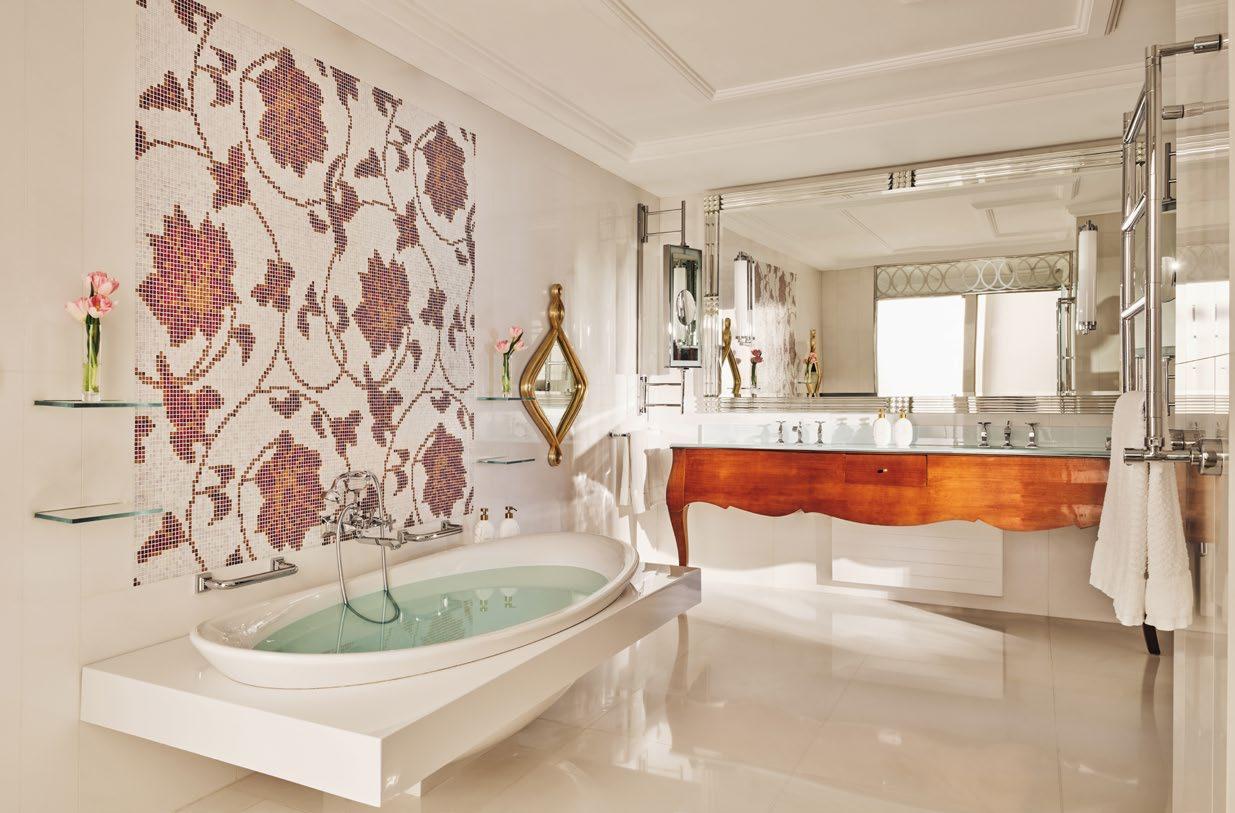
Where to stay: Hotel Principe di Savoia
Milan is the undisputed style capital of Italy, and what better way to experience its cosmopolitan flair than with a stay at the five-star Hotel Principe di Savoia (this page). The elegant grand dame, a Dorchester Collection hotel, is at the heart of Milan’s fashion and celebrity scene. Located near the Piazza della Repubblica and the future-facing Porta Nuova district – and just 10 minutes from the world-famous La Scala opera house – it’s the perfect location for shopping or exploring, with or without the runways of Milan Fashion Week.
The interiors of Hotel Principe di Savoia represent the epitome of classic Italian glamour. Rich fabrics adorn antique furniture, heavy silk curtains frame the windows, and the many artistic details remind you that you’re in the home of Italian design. The hotel has enjoyed collaborations with designers including Celeste Dell’Anna, who designed the hotel’s Imperial Suites (above), and Thierry Despont, who created the dramatic bar interiors (left). For her restoration of the Principe Suites, London-based Francesca Basu paid tribute to La Scala’s famously opulent design.
For serious shoppers, the hotel’s shopping guide and walking tours will open the doors of hidden ateliers and artisan workshops. Or why not relax on a tour of Lake Iseo by Riva before returning to enjoy classic hearty Milanese dishes, from risotto to ossobuco. »
dorchestercollection.com

Where to stay: This Time Tomorrow
Florence is a city where time moves slowly. The epitome of leisure and luxury, this Tuscan city is a melting pot of culture, art, architecture and food. It is also the birthplace of the Renaissance movement and home to artists such as Michelangelo, Leonardo Da Vinci and Botticelli – as well as luminaries like writer Dante Alighieri and the powerful Medici family. With so much to see and do, where does one start?
This Time Tomorrow (this page) is a bespoke private residential service curating city stays, with carefully curated travel experiences tailored to each guest. Situated in a beautiful baroque building are their eight art-filled apartments. Each is a retreat of ample space and privacy in a truly residential neighbourhood of local butchers, cafés, and hidden curiosities – with the city centre just a short ride or walk away.
Before you’ve even arrived in Florence, curator Eric Veroliemeulen and the team at This Time Tomorrow not only ensure you have everything you need for your stay but also help you create your dream experience in the artistic city based on your tastes and needs. Eric’s team finds the best restaurants, tourist attractions, museums, exhibitions, sunset views, cafes, bars, gyms and more. His teams of curators across the This Time Tomorrow portfolio have lived in their host cities for decades – so their recommendations are often hidden gems that you could only know if you were a local. They call it “off menu” exploring – the perfect way to show you the city they love and the reasons they love it.
thistimetomorrow.io


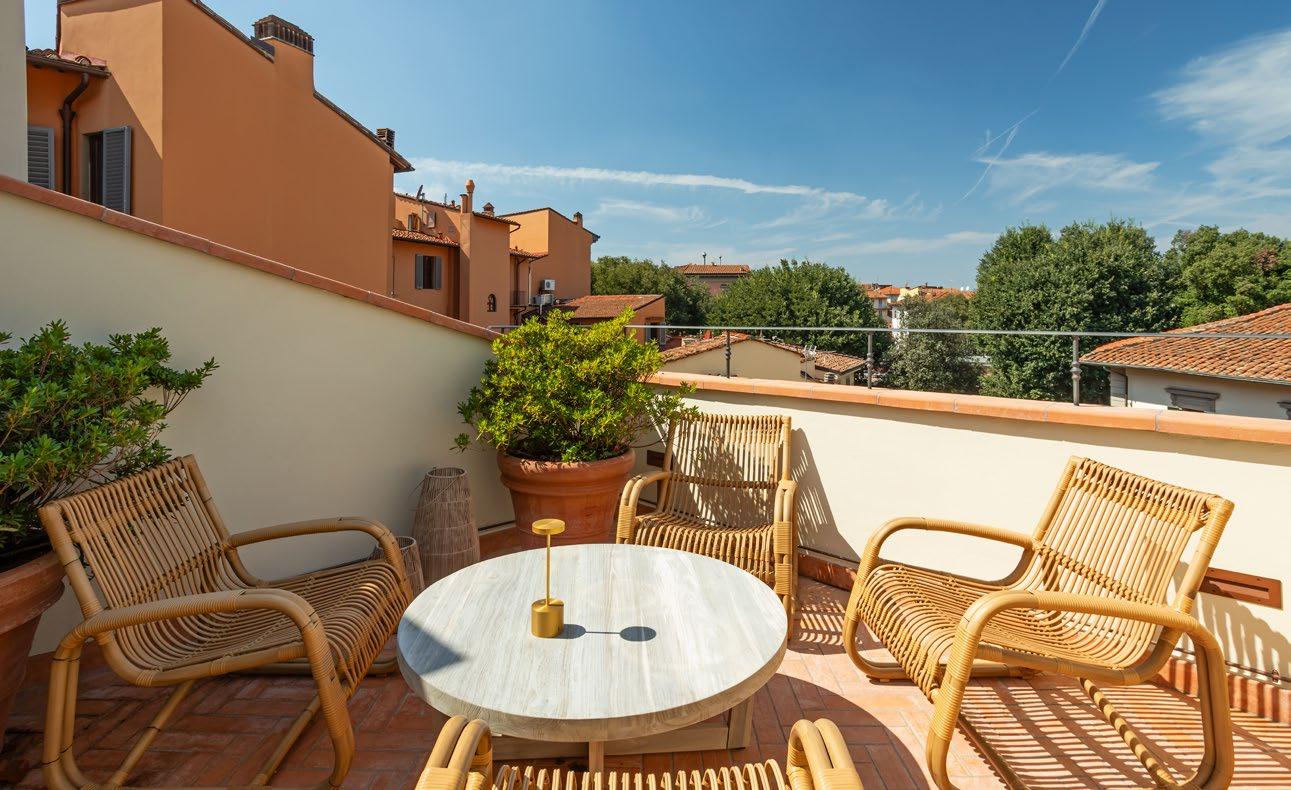

Recognised by the I Borghi più Belli d’Italia association as one of Italy’s most beautiful villages, Panicale is an impossibly picturesque hilltop town in the heart of Umbria. This historic, medieval town has been put firmly on the map in recent years thanks to the opening of design-led boutique hotel Rastrello (this page), a restored 14th-century palazzo with breathtaking, panoramic views over Lake Trasimeno and the surrounding, lush countryside. This summer, the hotel opened its garden annex, adding a further seven rooms to the property as well as a dedicated wellness area and outdoor dipping pool, enhancing its idyllic charm.
Umbria is well known for its incredible food and Rastrello’s own farm-to-table restaurant, Cucina e Giardino, serves delectable plates by chef Nicola Fanfano, featuring home-grown ingredients, including the hotel’s own award-winning extra-virgin olive oil.
This quaint medieval village and its winding, stone streets, ancient city gates and charming piazzas are brimming with history – notably its beautiful 130-seat theatre, Teatro Cesare Caporali, which dates back to 1694. Art lovers should make sure to visit Panicale’s Church of San Sebastiano, which is home to impressive frescos by Renaissance master Pietro Perugino.
For food lovers, come autumn, guests can partake in the olive oil harvest at the hotel’s nearby farm to experience the local tradition, or try your hand at truffle-hunting, a celebrated tradition in the region. »
rastrello.com

Where to stay: Romeo Naples
In contrast to many of our picks, there is little about Naples that we would describe as serene. The gateway to Italy is an energetic, thriving and vibrant city – and a true glimpse into the former principality’s remarkable melting pot of history, with traces of Spanish, Arabic and African influence in its architecture, music, food and culture. You can spend hours exploring the colourful winding streets of the historic and Spanish quarters, taking in hidden churches and piazzas and murals to icons – including footballer Diego Maradona – before shopping along the designer streets of Via Dei Mille and Via Filangieri.
Above the colourful chaos, with gasp-worthy views of Mount Vesuvius and the island of Capri across the busy harbour, is ROMEO Napoli (this page) – an impressive five-star hotel just a stone’s throw from the port and historic quarter alike. The contemporary hotel is tastefully curated with exciting artworks throughout, drawing inspiration from the landscape and culture of the city fused with the streamlined architectural style of Japan’s Kenzo Tange & Associates.
Its range of suites are outfitted to meet any need – from the sprawling residential penthouse and zen suites to specially outfitted wellness rooms that feature personal spa and saunas. Its wellness centre offers a fully outfitted gym and indulgent spa facilities, while culinary delights await at the sky-high Il Ristorante Alain Ducasse. Informal dining can also be enjoyed at La Terrazza (below), where guests can take a dip in the infinity pool or ninth floor panoramic plunge pool, featuring a whirlpool system.
Of course, no trip to Naples would be complete without a sojourn into ancient history: the archaeological cities of Pompeii and Herculaneum – painstakingly brought to life after they were buried by the eruption of Vesvius in 79AD – are located less than two hours away by car or train and an unmissable, fascinating glimpse into life almost 2,000 years ago.
theromeocollection.com



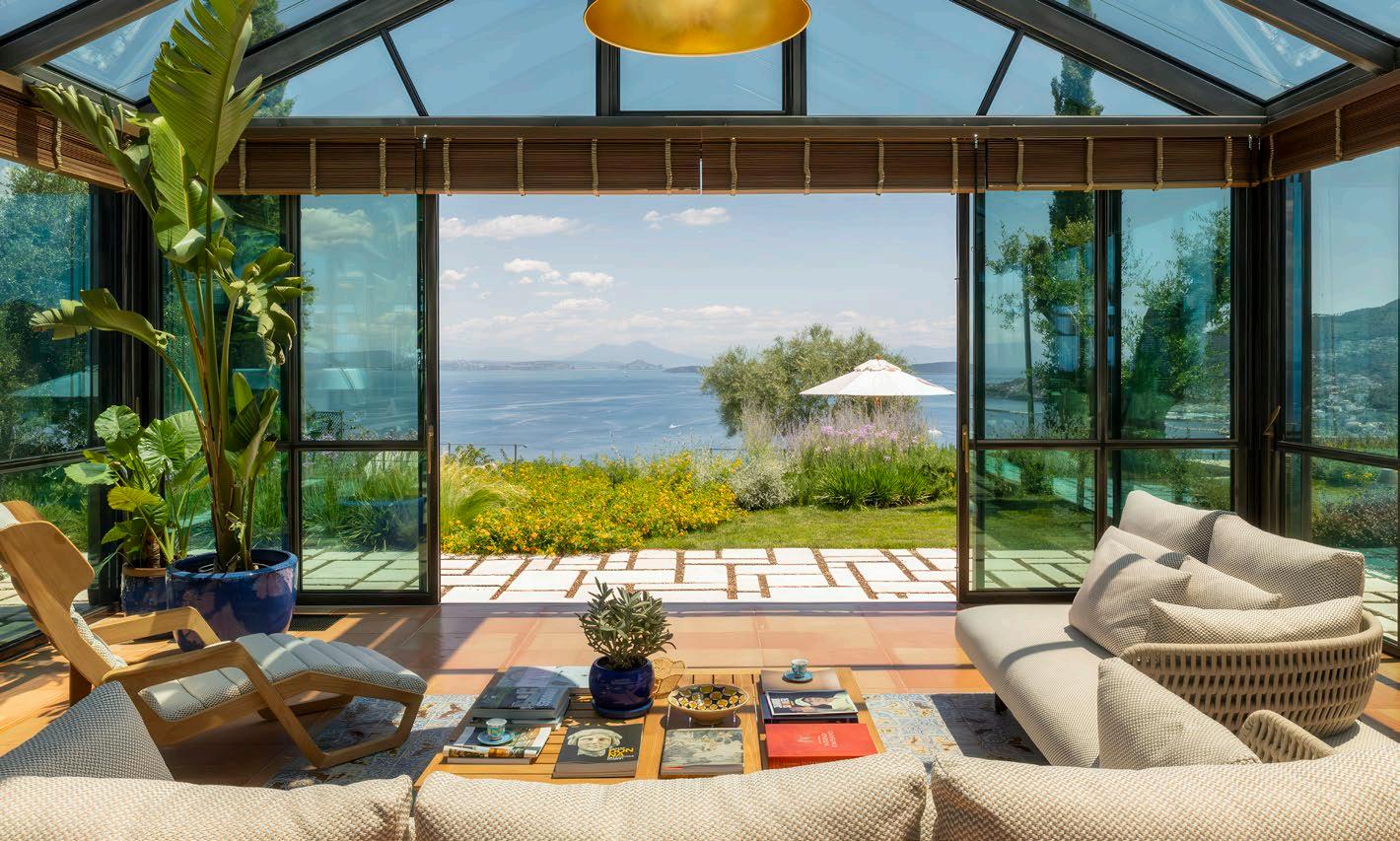
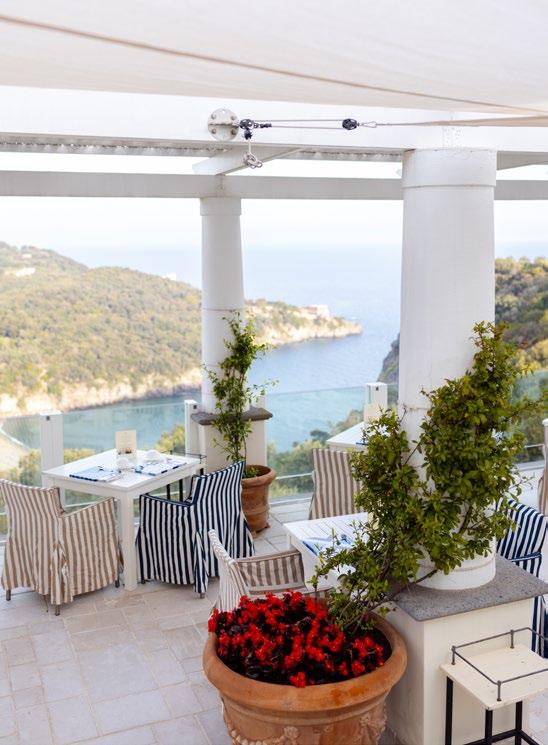
Where to stay: San Montano Resort & Spa
No trip to the south of Italy is complete without a jaunt across to one of the lush and verdant islands that dot its coastline. Often considered the little sister of Capri, Ischia is a peaceful island escape, bursting with colour from the red geraniums and lilac wisteria that line the roadsides. The five-star San Montano Resort & Spa sits atop one of the island’s highest points on three hectares of parkland, overlooking Ischia and the surrounding islands.
With a range of rooms, suites and villas – including stunning split-level suites with private infinity pools, and the remarkable lighthouse suite with its panoramic living area (above) – there is endless comfort, privacy and relaxation for all tastes. The resort’s Ocean Blue Spa provides indulgent treatments, while a wander through San Montano’s tranquil H20 Park, with a thermal spa pool and solarium, private plunge and rock pools, and sauna – and scented lemon groves is equally soothing for the soul.
If that’s not enough water therapy, the hotel’s chauffeur service provides access to its private beach, Spiaggia di San Montano, where you can also explore the famous thermal baths of Negombo. Another unmissable excursion is the Giardini la Mortella, a sensational subtropical and Mediterranean garden developed by Susana Walton – wife of the British composer Sir William – and designed by landscape architect Russell Page.
The exceptional hospitality continues with San Montano’s impeccable dining options: Franco’s for relaxed, flavourful fare (left); Acropoli Pizza & Bar; the Sunset Bar – where speciality cocktails abound – and La Veranda, the restaurant’s fine dining restaurant serving extraordinary fresh dishes that will delight the tastebuds. Between indulgent food and treatments and lemon-scented ocean air, we guarantee you won’t want to leave.
sanmontano.com

Discover the world’s most cutting-edge spa treatments, propelling the art of luxury pampering into the 22nd century
Words: Charlotte McManus
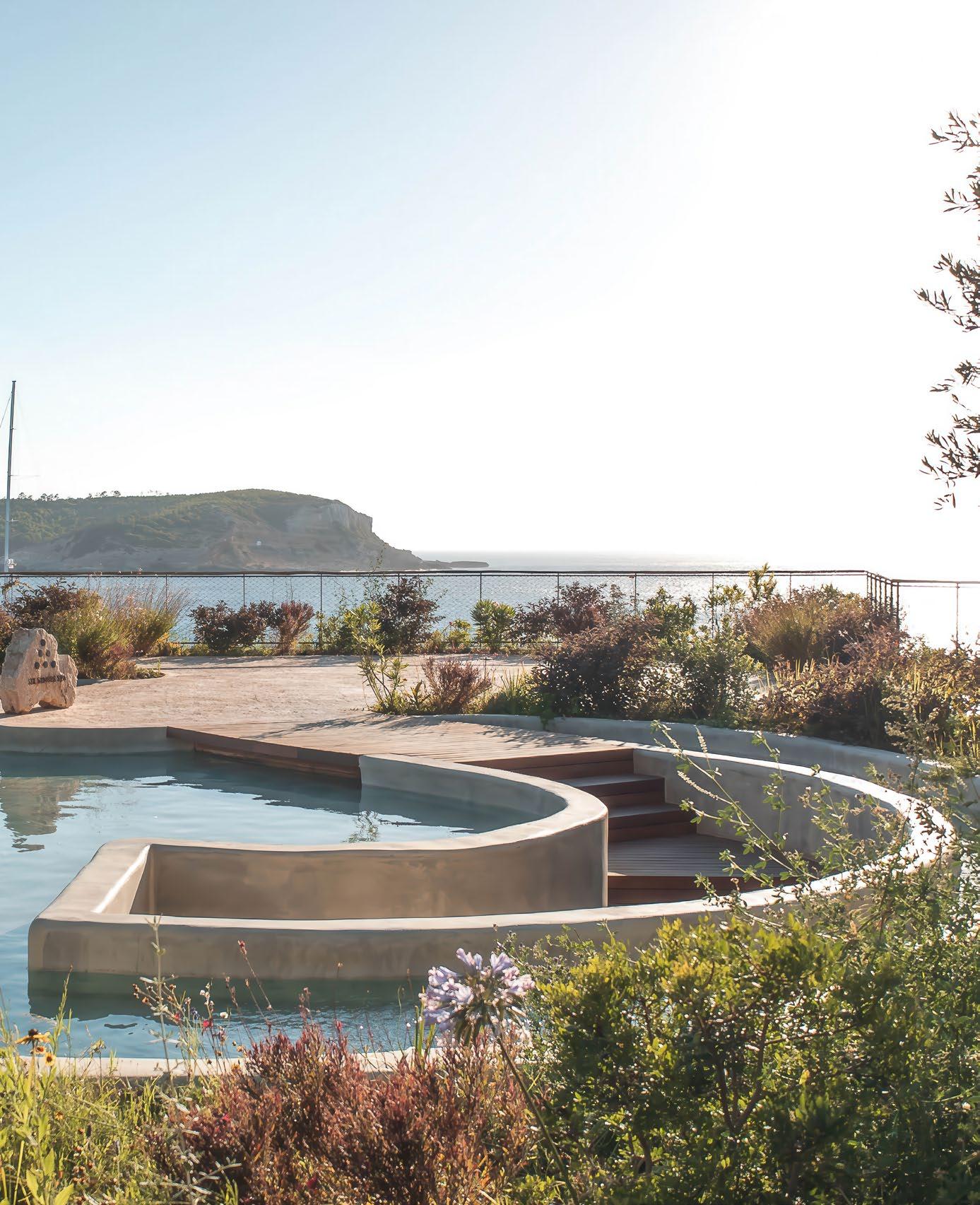
In the UAE, Dubai is fast becoming a hub for futuristic, high-concept wellness. It is home to SHA Emirates, the world’s first “healthy living island”, while clinics such as Skin111 deliver next-level skincare regimes using potent exosomes – nano-sized structures derived from stem cells.
Head to the Talise Spa at Jumeirah Marsa Al Arab, where The Remedy Suite promotes healing with touchless wellness technology, from chromospace light treatments to their “infrared triple detox”. With its Circadian Balance programme, jetlag sufferers can reset with hyperbaric oxygen therapy and a stint in the far-infrared iDome, together with a nifty pair of lymphatic compression boots.
Over in the United States, robotic AI-powered Aescape massages are à la mode at a clutch of top hotels, from Lotte New York Palace to The RitzCarlton Orlando. Simply choose your personal preferences for pressure, music and muscle groups, and let two synchronised robot arms do the rest.
And in Montreux, on the shores Lake Geneva, Swiss alpine wellness Mecca Clinique La Prairie has long been renowned for its evidence-based programmes, from their longevity-enhancing Audiovitality therapy to skincare rejuvenation using your own stem cells.
Alternatively, a staycation shouldn’t be sniffed at, given that the UK is making great strides in the fusion of medical innovation with luxury hospitality. Head to the capital to experience an antigravity-inspired session in a Zerobody Dry Float pod at The Bulgari Spa – just the thing for a good night’s sleep – followed by a spot of sub-zero cryotherapy at Lanserhof at The Arts Club.



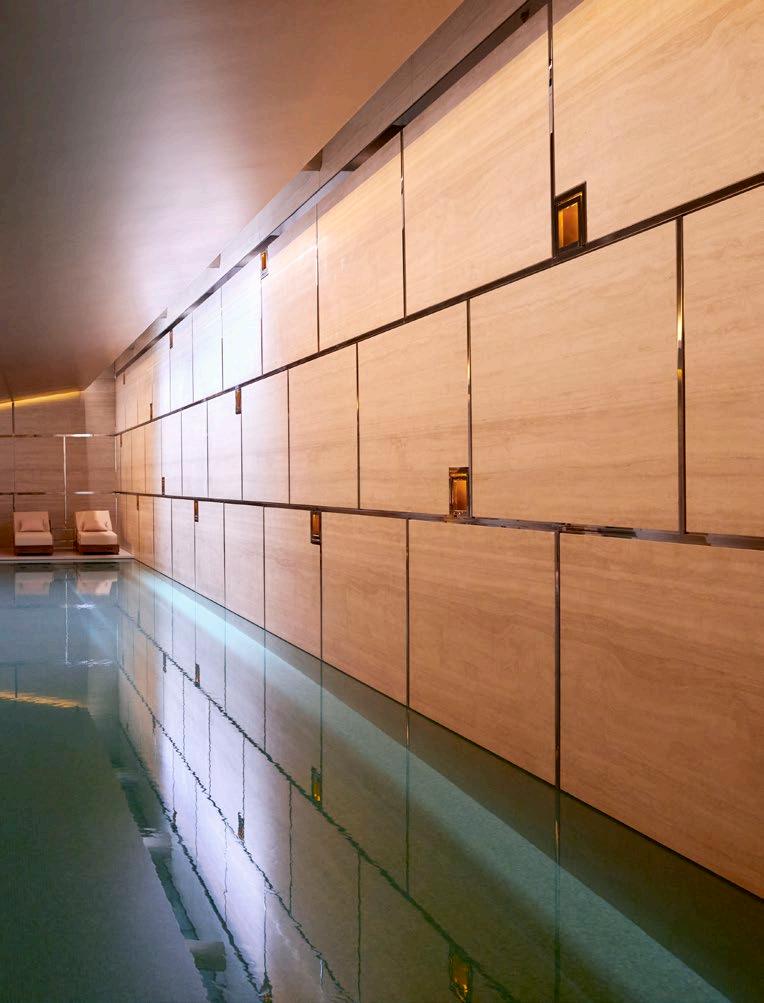

However, no London spa weekend would be complete without a stop at Maybourne-owned Surrenne, the ultra-luxe, science-driven spa and health club. Guests of The Emory or The Berkeley hotels can enjoy privileged access to this exceptionally exclusive sanctuary in Belgravia –though a second outpost has just opened at The Maybourne Riviera, for those on a jaunt to the Côte d’Azur.
“Many of our members already have incredible gyms, saunas and spas in their own homes, plus their own doctors,” says Hattie David-Wilkinson, Maybourne’s global head of wellness and longevity. “They are very well informed about their health and are looking for results-driven treatments where they see and feel a noticeable difference.”
Shaped by an all-star panel of experts – from celebrity skincare specialists to Harley Street hypnotherapists – Surrenne’s treatment menu includes facials enriched with lasers and frozen shots of CO2, while artful body sculpting combines radio frequency with high-intensity electromagnetic technology.
“We offer hyper-personalised experiences, with everything overseen by medical professionals, so each member’s journey is utterly unique,” says Hattie. “We exist at the intersection between cutting-edge science and the sensorial, set within a very luxurious environment geared towards health.”
As next-gen wellness offerings continue to evolve, it’s tempting to ponder what kinds of pioneering innovations will be revealed next.
Explains Seyi: “Longevity labs will offer biometric-driven treatments, powered by AI and real-time health data to deliver truly customised experiences for optimal health. These technologies will enable spas to provide more individualised and effective wellness journeys.”
Meanwhile, Hattie hints at intriguing developments in cognitive performance: “It’s a very new area. We’re looking into brain training, having just invested in a new piece of kit called Exomind. It uses transcranial muscle stimulation to help with everything from anxiety and depression to improved sleep and focus. We’ll also be introducing designated cognitive performance labs.”
One thing’s for certain, the future of wellness looks decidedly healthy.
High-tech health: Six Senses Ibiza (previous). This page, clockwise from top: Surenne Belgravia’s pool and steamroom; the RitzCarlton Orlando; Jumeirah
Marsa Al Arab, Dubai


Labareau founder Lindsay van der Looij on blending decades of skincare expertise with biotech innovations to create beauty that stands the test of time
Words: Shivani Dubey
Lindsay van der Looij (left) has worked in the skincare industry for more than two decades. As a leading skincare expert, she has worked with high profile celebrities, and cosmetic surgeons, as well as some of the biggest luxury brands in the market. Yet, she always felt that something was missing.
Frustrated with a lack of results from even the most high-end skincare brands, Lindsay established Labareau with a mission to fuse scientific innovation with luxury to create formulas that deliver visible, lasting results.
“My clients expected science-backed performance – and rightly so. I realised there was a missing link between luxury and true efficacy,” says Lindsay, speaking of her inspiration to creating the Dutch brand, whose products are available via their website.
“That’s when I decided to create Labareau,
merging clinical innovation with indulgent skincare.”
Setting it apart from any other skincare brand is its groundbreaking SAXZ-12 technology, developed in collaboration with leading scientists and biochemists, combining luxury, quality, and clinically proven effectiveness. The proprietary formula targets three key drivers of skin ageing: collagen degradation, moisture loss, and oxidative stress using a blend of three highly concentrated powerhouse ingredients – 97% skin-identical premium native atelocollagen, hyaluronic acid, and bioactive peptides for visibly smoother, firmer, and more youthful skin.
Here, we talk to Lindsay about bringing science to skincare, standing out in a world of hyper-personalisation and the future of luxury skincare. »
Lindsay, tell us about Labareau’s SAXZ-12 skincare technology?
SAXZ-12 is our proprietary delivery system designed to ensure optimal penetration of active ingredients into the deeper layers of the skin. Many skincare products sit on the surface, but SAXZ 12 allows our formulations to work from within, boosting hydration, stimulating collagen, and targeting fine lines at a cellular level. This complex ensures the best results.
What drove you to create this system?
I was driven by a desire to bridge the gap between clinical results and luxury skincare. I wanted to create a [product] line that felt indulgent but delivered transformative outcomes. Every formula is born out of both my professional experience and personal passion for skin health. I want women to finally experience skincare that really works, without compromise.
We have certainly seen a skincare shift towards biotech innovations. Why is the scientific element of skincare so important for Labareau?
Skincare is no longer just cosmetic; it’s deeply rooted in science. At Labareau, we believe in data driven formulations that are tested, proven, and effective. Biotechnology allows us to develop ingredients and delivery systems that actually change the skin’s behavior. It’s not about trends, it’s about transformation.
What challenges did you face bringing SAXZ-12 to market?
Introducing a new technology like SAXZ12 was initially met with scepticism. Many retailers and industry insiders are used to big heritage brands, and convincing them to trust something new takes time. Especially because Labareau is a doctor’s brand in a glamourous packaging. No brand has this combination. But, once they saw the results, and the loyal following we built, they understood that Labareau was different.
How does Labareau cater to the consumer shift towards more
sustainable, personalised skincare? We’re committed to sustainability through both our packaging and our approach to consumption. Our products are highly concentrated and multi-functional, which means fewer products, less waste and more impact. Personalisation comes through education; we help customers understand exactly what their skin needs, and how to build a minimal yet effective routine tailored to their goals.
Having worked in the skincare industry for decades, are there any consumer trends that excite you?
There’s a lot of talk about anti-aging, but few brands address proactive skin health – in other words, how to preserve and strengthen your skin before the signs of aging even appear. At Labareau, we focus on prevention just as much as correction. Skincare shouldn’t just fix problems; it should empower people to protect their skin long-term.
Are there any skincare myths that you would urge people to rethink?
That more is better. Layering 10 products doesn’t make your skin healthier – it often overwhelms and sensitises it. Focus on quality, not quantity. A few well-formulated products that work synergistically will always outperform a shelf full of trendy bottles. Start simple. Know your skin type and choose products that address your specific concerns. Don’t chase trends – trust ingredients with proven efficacy. And be consistent. Skincare is not a quick fix; it’s a commitment. With the right routine, your skin will reward you.
Where do you think luxury skincare is headed in the future?
I believe the future of luxury skincare lies in hybridisation, where clinical-grade performance meets sensorial experience. Consumers want products that are not only effective, but also emotionally rewarding to use. We’ll see more brands that combine medical innovation with beauty rituals, without losing sight of sustainability and ethical responsibility.
labareau.com
I WANT WOMEN TO FINALLY EXPERIENCE SKINCARE THAT REALLY WORKS, WITHOUT COMPROMISE



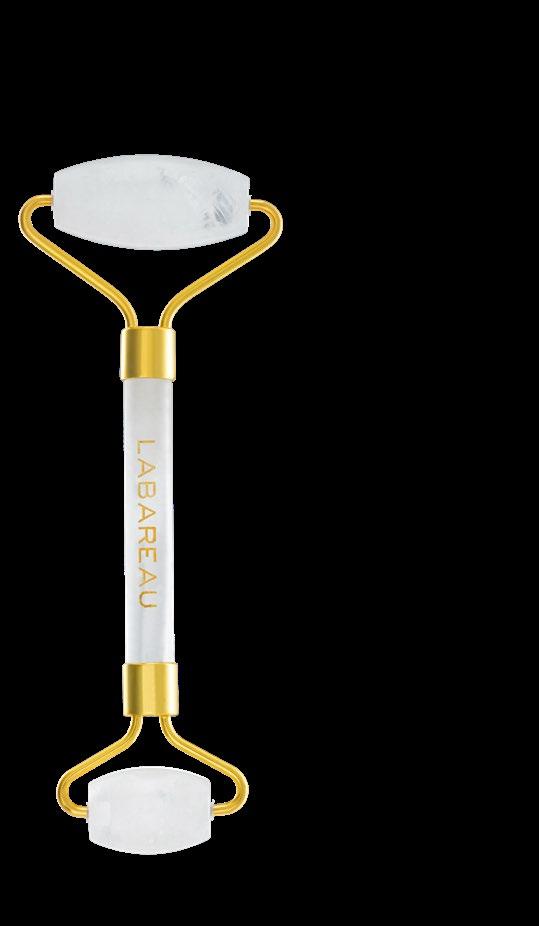



Every great love story deserves a symbol that feels just as unique. For over 185 years, Baker Brothers has helped couples mark one of life’s most defining moments, the choosing of an engagement ring. But today’s couples are rewriting tradition, seeking pieces that go beyond convention to reflect their own values, personality and vision of love.
At the heart of this evolution is the diamond itself. Whether drawn to the enduring rarity of a natural diamond or the innovation and modernity of a lab-grown gemstone, couples are embracing the freedom to choose a gem that truly resonates with them. By starting with the gemstone, they begin their journey not with a ready-made design, but with possibility, shaping a ring that is personal, intentional and deeply meaningful.
For Baker Brothers, this approach is second nature. Our team of professionally trained experts invites customers into an intimate and
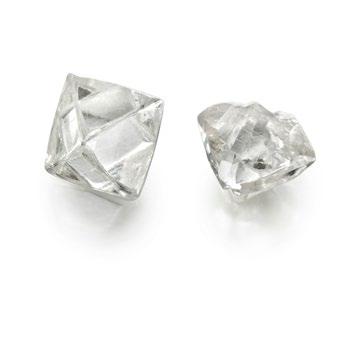
educational process: exploring brilliance under the jeweller’s loupe, comparing subtle shades of colour, and understanding the story behind every sparkle.
“Each diamond, whether natural or lab-grown, has its own character, and our role is to help you find the one that feels as individual as your love story,” says Rebecca Church, Director at Baker Brothers. “For those seeking the extraordinary, our unique network ensures no request is too rare, too unusual or too ambitious. If you can imagine it, we can source it – and craft it.”
Once the diamond is chosen, the conversation turns to design. The mount is more than a frame; it is the stage on which the diamond tells its story. Some couples are drawn to the purity of a solitaire, others to vintage-inspired details, or to bold, modern silhouettes. Every decision, from choosing a precious metal such as platinum or yellow gold, to whether a setting is fine and delicate or sculptural and statement-making, is
considered with care. The result is a piece that doesn’t just sit beautifully on the hand but feels in harmony with the wearer’s life and style.
It is this combination of expertise, craftsmanship and imagination that has earned Baker Brothers its reputation as Bedfordshire’s diamond specialists. A family business spanning generations, we remain as committed today as we were in 1839 to create jewellery that carries meaning, endures through time and becomes part of a family’s story.
An engagement ring embodies far more than beauty alone; it represents a promise, a lasting memory and a symbol to be cherished for a lifetime. At Baker Brothers, we are honoured to be part of that story, crafting rings that celebrate love in all its brilliance.
Contact Baker Brothers via their website bakerbrothersdiamonds.com or phone +44 (0) 1234 438 770

As we look back to the sensational style of London Fashion Week, Tempus meets some of the most exciting faces in design and couturier – and discovers the ones to watch for the coming seasons
Words: Shivani Dubey
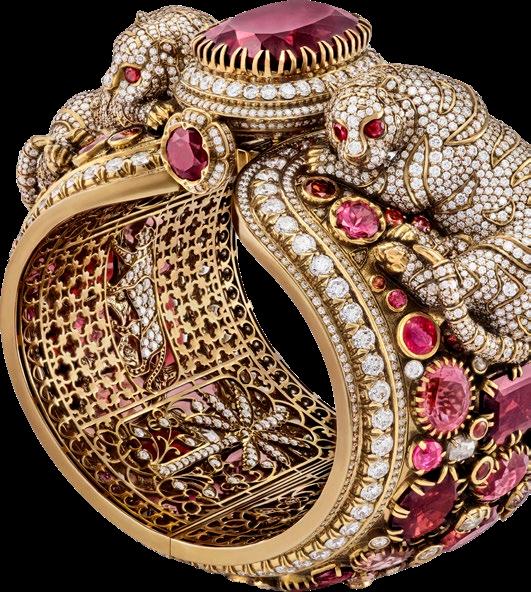
When you think about contemporary Indian couture or luxury bridalware, Sabyasachi Mukherjee is the first name that springs to mind. Since graduating from the National Institute of Fashion Technology, India in 1999 and founding his namesake brand, Sabyasachi – which turns 25 this year – he has dressed some of the biggest actors in the Indian film industry, and expanded his reach across the globe with flagship stores and collaborations with luxury brands across various fashion capitals around the world.
Most recently, he unveiled a high jewellery exhibition (this page) at London’s Harrods – the first Indian designer to display at the Knightsbridge department store. He also made headlines earlier this year when he became the first Indian designer invited to the Met Gala, where he outfitted the country’s most prominent superstar, actor Shah Rukh Khan, as his muse. Sabyasachi adorned the actor in many high jewellery staples, something the designer knows a thing or two about, given his background as a jeweller.
“For culture to be relevant, it needs to be dynamic,” says Sabyasachi. “My two decades as a colourist guides me as a jeweller, especially when working with multi-coloured gemstones. For me, the quality of gemstones is a given, but the beauty of jewellery-making is in disrupting the hierarchy of precious stones and mixing them in a fierce amalgamation of modernity and traditionalism.”
With his label, Sabyasachi has not only created haute couture and runway showstoppers – all while spotlighting the best of Indian craftsmanship – but he has also turned his brand into an entire lifestyle. From high jewellery, homeware and interiors to foraying into the world of beauty and perfumes, he has long been ahead of the curve and, for a quarter of a century, remained one of the most prolific fashion designers in the field. And given the consistent success he is enjoying, it doesn’t seem like Sabyasachi has plans to stop anytime soon. »
sabyasachi.com
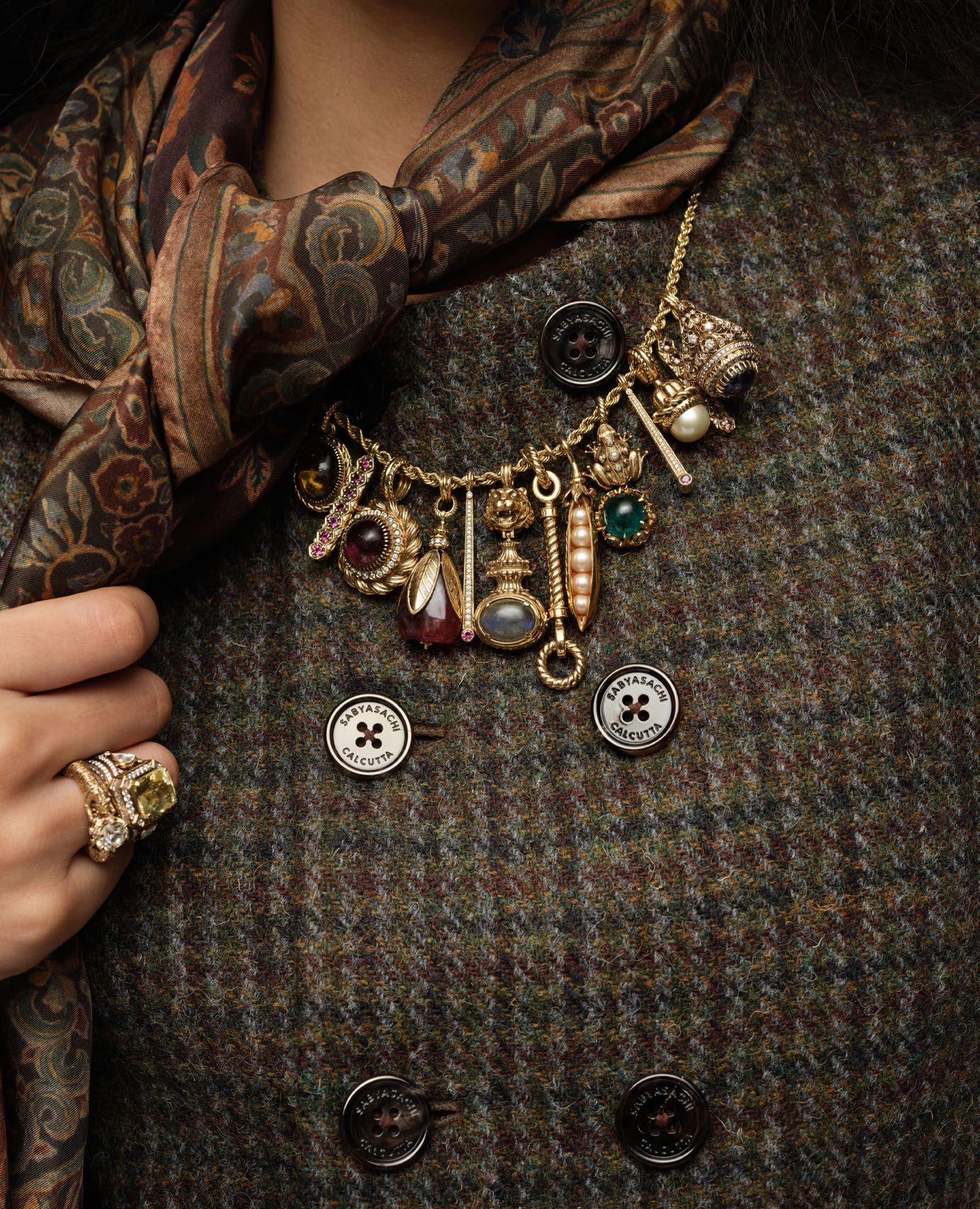
One of the most exciting new designers to showcase at this year’s London Fashion Week, Nathan Slate works from his countryside atelier in Somerset, where he creates designs that intersect art, crafts and sustainability.
“It’s easy for me to live between the world of art and fashion,” says Nathan. “I get good opportunities, like my recent installation with the British Art Council, and then I use the textiles from that installation to create garments for my London Fashion Week collection.”
With techniques such as rainfall-dyed textiles and ceramic accessories, Slate’s work blends experimental processes with artisan values. His designs are one-of-a-kind, blending his ecoconscious ethos with bold, conceptual artistry.
“Sustainability is really important to me. It’s constant flux between what’s morally right and what we can actually do,” says Nathan. “I began using only natural materials and dyes then I realised a lot of natural fibers actually damage the land they are farmed on and use a lot of water. I began dyeing using rain water and developed my rain dye technique. This then spiralled into questioning sustainability –is something synthetic that can last a lifetime more sustainable than something natural that damages the earth too? I believe as designers and artists it’s our responsibility to question and do what we can.”
nathanslate.com

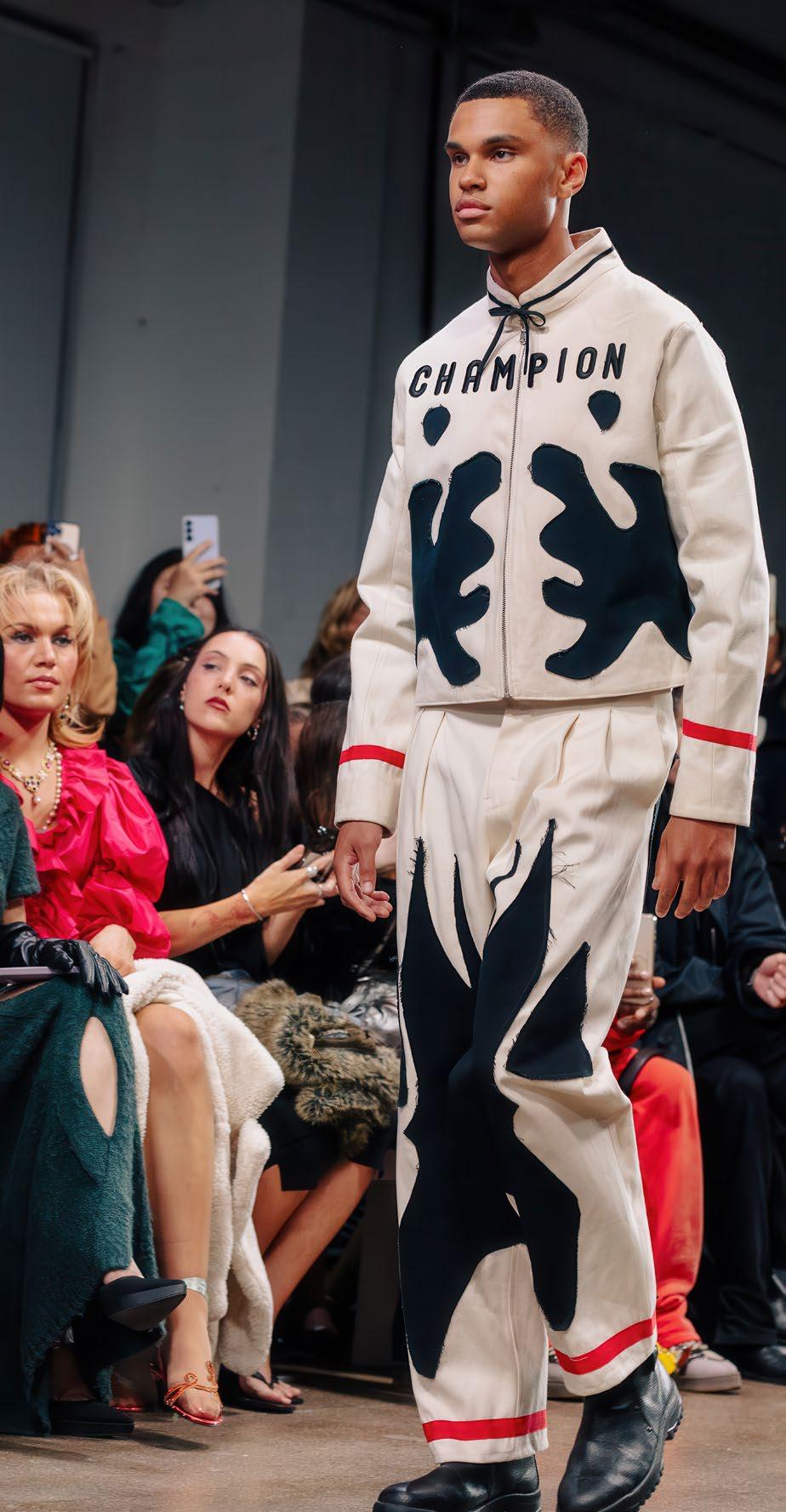

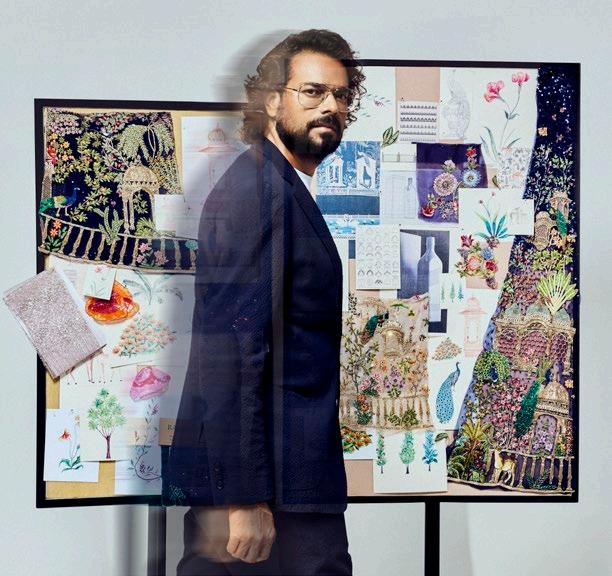
RAHUL MISHRA
Rahul Mishra is a designer renowned for his exquisite embroidery and mastery of colour, as well as his commitment to slow fashion, mindful luxury and supporting local artisans. He was the first Indian fashion designer to be invited to show at Paris Haute Couture Week, and has created designs for celebrities like Priyanka Chopra Jonas, Zendaya, Gigi Hadid and more. Recently, he collaborated with Johnnie Walker Blue Label to create limited edition bottle designs (left).
As one of India’s most prolific couturiers, Rahul jas taken the fashion world by storm – but it is his commitment to championing local artisans and craftsmanship that makes him one of the most exciting designers to watch. His work is rooted in sustainability and the empowerment of the local craft community of India, through both his eponymous couture label (below) and pret-a-porter brand AFEW Rahul Mishra.
“For me, true luxury lies in the handmade and its human value. Supporting craft is not only about sustaining livelihoods but preserving the knowledge and traditions that give Indian design its soul,” says Rahul. “Every weave and every stitch carries the imprint of a community, and, when we choose craft, we are choosing continuity.” »
rahulmishra.in



Tamara Ralph has long been a trailblazer in the fashion world. Whether through her previous luxury label Ralph and Russo or her eponymous haute couture brand, launched in 2022, Tamara puts advocacy and philanthropy front and centre – all while designing high fashion clothing for some of the most discerning clientele in the world, including Beyoncé, Angelina Jolie and Meghan, Duchess of Sussex.
The Australian-born designer is known for her intricately detailed creations and flattering silhouettes, which are regular runway heroes at Paris Haute Couture Week.
“To be authentic means embodying one’s key values and morals across all facets of your life, not just in your personal endeavours but also in your life’s work,” says Tamara. “For example, my designs are rooted in female empowerment with an overarching element of strength. In terms of how this is represented in my collections – the expression of strength in femininity is embodied through different facets and features with an armour-like detailing; it is about confidence, grace and power.”
From fashion and sustainability right through to women’s rights and equality, Tamara upholds these values not just through ideology, but also through fashion – and that is what makes her one of the most exciting designers working today.
tamararalph.com
Making its debut at this year’s London Fashion Week was Nichoir, the exciting new label founded in London by Nicolae-Vladut Radu. Nichoir explores themes of darkness and romance through fashion.
“For me, fashion is where darkness meets romance a place of mystery and intimacy,” he says. “I explore this tension by shaping garments that feel both powerful and tender, allowing people to embrace their complexity.”
Inspired by the Rorschach inkblot test, Nicolae-Vladu’s debut SS26 collection (this page) explores the perception and the subconscious through ambiguous silhouettes that balance strength and vulnerability. Using fashion as a psychological mirror, the designer creates a world that is intimate, haunting and transformative. » nichoiratelier.com

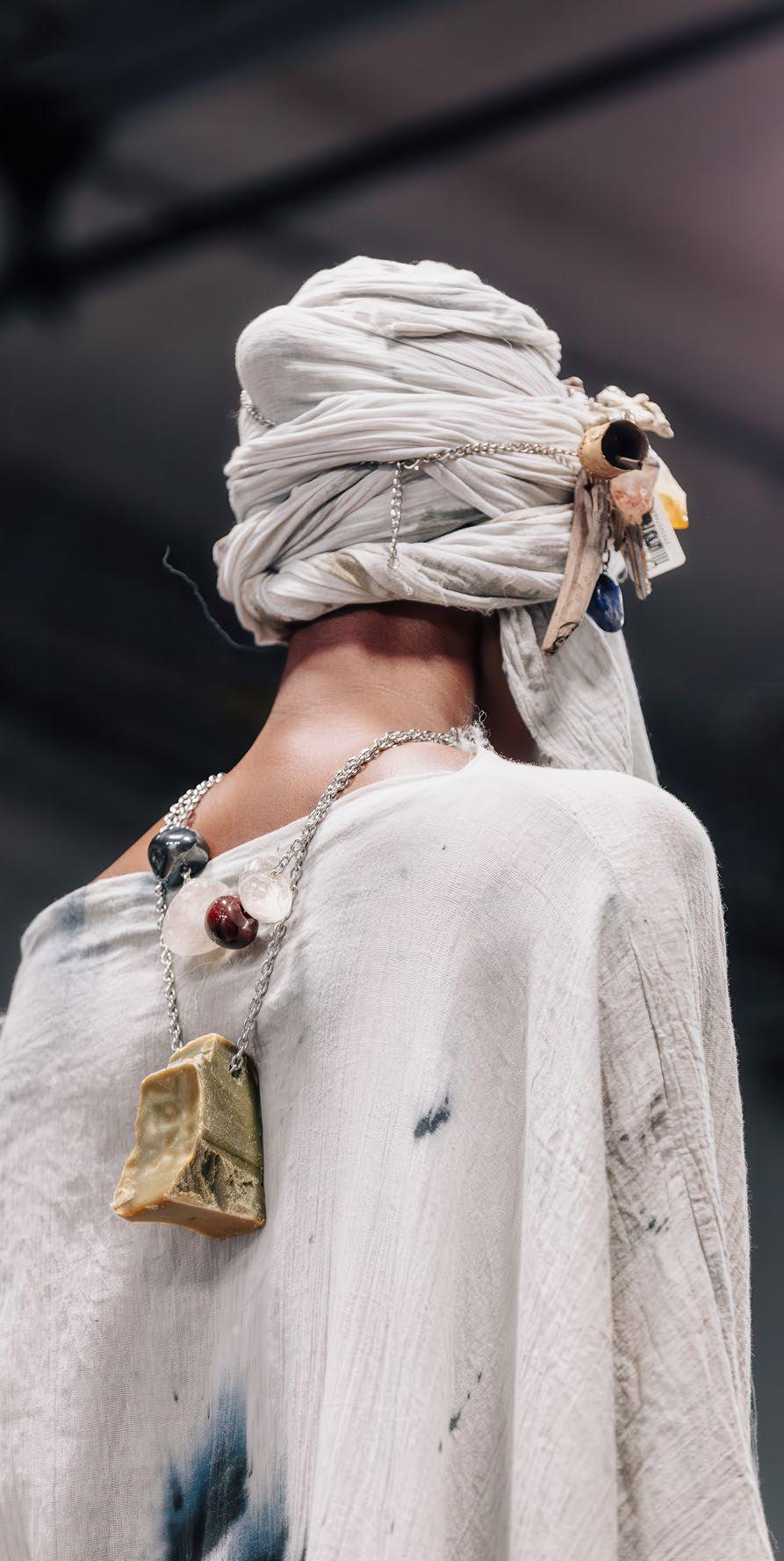

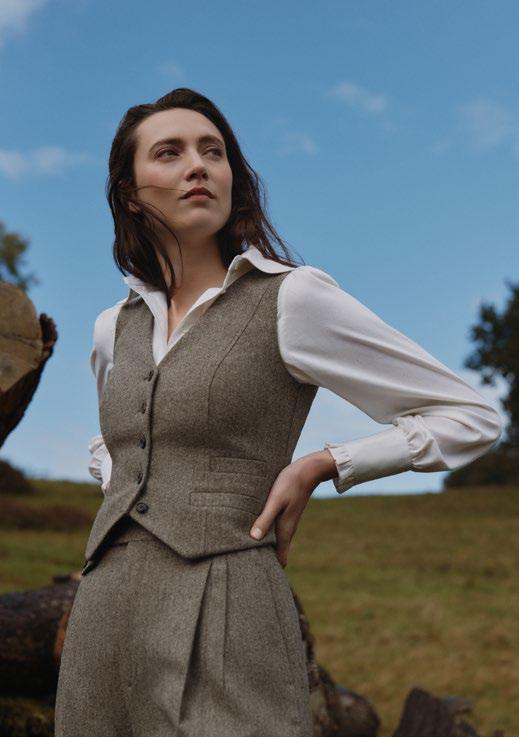

I WANTED TO CHALLENGE THE ANTIQUATED VIEW THAT SUITS ARE ONLY FOR MEN – KNATCHBULL IS ABOUT GIVING WOMEN THE OPPORTUNITY TO BE HEARD AND UNDERSTOOD IN THE WORLD OF
– Daisy Knatchbull
Daisy Knatchbull – and her label Knatchbull (previously The Deck London) – have been Saville Row staples since April 2019, providing women with an unparalleled experience of craftsmanship, quality and tailoring while embracing modern femininity. The designer (above right) spent five years working at Huntsman, one of the Row’s oldest and most prestigious tailors, where she was exposed to the deeply traditional world of men’s suitmaking – and the lack of contemporary alternatives for women. Daisy has since been on a mission to offer a compelling alternative to fast fashion.
“A well-cut suit doesn’t just change how you look, it changes how you feel. At Knatchbull, we accentuate the female silhouette with the right fabrics, fit and colour – every detail is meticulously considered to blend traditional craftsmanship with contemporary style,” says Daisy.
In 2016, she became the first woman to wear a tailored morning dress to Royal Ascot, perfectly honouring the men’s dress code while adding her own unique and refined flare.
“I wanted to challenge the antiquated view that suits are only for men – Knatchbull is about giving women the opportunity to be heard and understood in the world of tailoring,” says Daisy.
In 2024, Knatchbull certified as B-Corp and became the first UK made-to-measure tailoring house to achieve this certification, cementing Daisy one of the most enthralling and sustainability-forward designers working today.
knatchbull.com
As Downton Abbey bids farewell with a cinematic finale, we look back at the dazzling drama of a period piece that opened a door to a forgotten world of British aristocracy
Words:
Tessa Crowley
Fifteen years after Downton Abbey first hit our television screens, bringing new life and star quality to polished period dramas, its famous faces – including Hugh Bonneville (right), Michelle Dockery, Elizabeth McGovern and Dominic West – returned to the stately home for a last hurrah this September with the film Downton Abbey: The Grand Finale
For fans of bingeable drama, the long-awaited third film promises a worthy farewell to the beloved characters and locations, bringing together the inhabitants of the great house – for which real-life Highclere Castle near Newbury doubles as the opulent Crawley estate – for a captivating final instalment.
“I think underpinning everything in Downton Abbey is a sense of compassion and trying to do the right thing even when that goes askew,” says Hugh Bonneville of the show’s success. “That is its great legacy.”
Hugh has starred as the Earl of Grantham since the show’s first episode. His character, a well-meaning and family-oriented patriarch, has navigated the dramatically changing times from the Titanic disaster of 1912 to the latest film, set in the summer of 1930. This is while his family, particularly his eldest daughter, Lady Mary, try to keep Downton Abbey a relevant and functioning estate for their aristocratic clan and the close knit team of staff who serve the family.
A global phenomenon, the opulent and much-loved show treated viewers to decadent interiors, glamorous old-world style and whispered scandals. Downtown Abbey offers a glimpse into a bygone era, a vanished world of landed gentry, complicated family relationships, upstairs-downstairs divides, and unspoken societal pressures. Beneath the straightlaced grandeur, its heartfelt human stories made it a British sensation. »



The finale sees the film’s cast step out into the high society of London in 1930, hitting key social events such as Royal Ascot, and mingling with luminaries like playwright Noël Coward.
The entertainment is led by the show’s writer and creator Julian Fellowes, whose deft script brings tumultuous history to life through the lens of a single community.
“Every generation reinvents how these great houses are lived in,” he said. “That whole way of life had to be reinvented. When I was a young man, the ‘London Season’ still existed with debutante balls, and I took part in it all. I loved it, but when it was abolished, it was gone for good. That’s just life. We invent things, we enjoy them for a time, and then they’re over, or we do them differently, and that’s what we’re trying to say about Downton
“It will go on, but not in the same way we saw it in 1912. That way of life has gone now, and something different will replace it.”
Hugh credits Downton’s success to Julian’s narrative flair. “It took me a few episodes to work out what his knack was,” he says. “There is something soap-like and compulsive in his scripts and there’s a forward propulsion”.
Elizabeth McGovern, who plays Hugh’s wealthy American wife-turned-Countess of Grantham, Cora, agrees: “What I love about this script is it truly focuses on characters. You’re watching the minutiae of the interplay between these characters [and] having lived with each other for so long we’ve created a bond between us that you can’t fake.”
Key to achieving Downton’s heady sense of realism is its visual appeal. From the imposing towers of Highclere Castle as Downton Abbey itself to the warm communal spaces of the kitchens downstairs, the attention to detail is as impressive on the big screen as it has been on our television sets.
Moving through the eras has, naturally, meant the fashions have evolved as well. And, thanks to the period-accurate costuming of designer Anna Robbins, these sumptuous fashions have often stolen the show – even influencing modern-day runways.
“Anna, our extraordinary costume designer, has been given a little bit more license to push into the 1930s,” says Michelle Dockery, whose stoic but daring Lady Mary has slowly stepped into a leading role within the family estate.
“The shapes are slightly different. The waists are higher with a slightly more risqué length and a little bit more ankle. I love that Mary’s colours have slightly changed this time… Mary is in pinker, slightly more vulnerable tones.
“Every series or film, Anna goes above and beyond, and this year is the best, particularly Ascot. Everyone looks amazing, and the hats are incredible. It was like looking at a painting, seeing all the costumes together.”
Says Ann: “Downton Abbey is extremely visually beautiful, but there’s an authenticity and attention to detail underpinning it, which is key. [This film ] It felt like a new project in some ways, to be opening up the 30s… I adore so many designers of that time – Chanel, Vionnet and

Lanvin [and] spent many hours mesmerised by [Chanel’s] dresses and tailoring. I was also hugely inspired by Madame Vionnet who was the master of the bias cut.”
Michelle adds: “Mary’s Petersfield ball dress is stunning. From the first sketch to getting those last final touches of the jewels [from Royal Warrant-holding jeweller Bentley & Skinner], was just such an incredible process to see that happen creatively because you get to be in the room with Anna right at the beginning and see where it starts and where it ends up. It’s a real siren moment for Mary. There’s a cliché in it that she’s arriving in a red dress, and it’s about to be revealed that she’s divorced.”


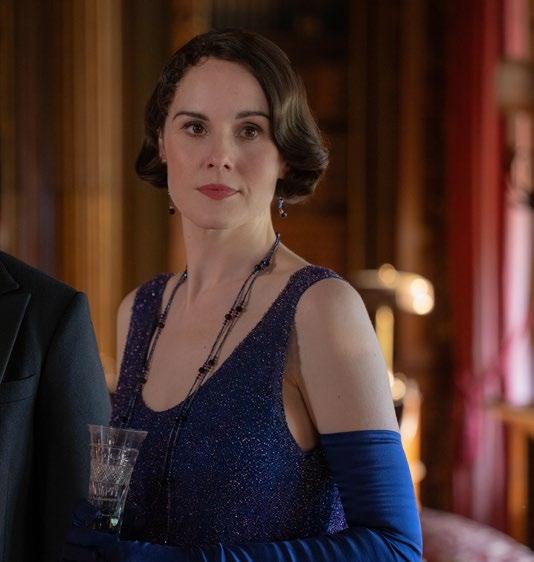
As Downton Abbey draws to a close, what will its stars take away from their time on set?
“It’s wonderful that actors of such great calibre have wanted to come and play with us over the years and this film is no exception,” says Hugh, adding: “The feedback we’ve all had over the years from people saying that the show has meant something to them and their families, and that it struck a chord because of the dynamics within it and the feeling that you get from it makes us all very proud. That all comes from Julian and the writing.”
“In the last film, you could see the beginnings of a changing of the guard, and with Violet’s death, it was very much an end of an era,” says Michelle, reflecting on the 2022 film in which the Dowager Countess Violet, beloved but staunch Victorian-era matriarch, died. Actor Dame Maggie Smith, who played Violet, passed away in 2024, aged 89. “It’s been a very soft transition, but this film is really about change.
“I don’t think I will ever say goodbye to Mary or Downton,” says Michelle, of the bittersweet farewell.
Dominic West – whose character Guy Dexter was introduced in Downton Abbey: A New Era –is somewhat more speculative about whether the age of Downton is truly at an end.
“I’m a little more optimistic about that,” he says. “I had the deep privilege and honour of being in Maggie Smith’s last scene in the second film, and she said she was throwing in the towel and retiring. Then I heard a few weeks later that she was working on another film – so I’m hoping that’s the same with Julian. It’s always the last one, but hopefully there’s a comeback.”
Julian himself is slightly more ambiguous –asked whether there will be another Downton, he says: “One should never say never”.
Downton Abbey: The Grand Finale is available to buy or rent on digital platforms from 30 September


Could an
AI-driven perfume industry
be the next beauty scent-sation? Here are the five things you need to know
Words: Judy Cogan
Artificial Intelligence (AI) is advancing at breakneck speed, driving everything from the way we plan our holidays to how we listen to music and buy clothes. Bot-driven beauty already offers us hyper-personalised tech-focused skincare products. So, what’s next?
An AI-driven perfume industry could be the next beauty sensation, and the scope for development is huge. Global revenue for fragrances is expected to increase at a Compound Annual Growth Rate (CAGR) of 3.31% between 2025 and 2030, according to Statista. Brands are embracing AI to stay ahead of the curve.
Olivia Houghton, lead beauty and health analyst at strategic foresight consultancy The Future Laboratory, says: “In 2026 we will see this increase as luxury [perfume] brands speed up their integration of AI into the design process. [This] will provide consumers with new and innovative scent experiences based on emotive prompts and responses. AI is significantly impacting luxury fragrances by enhancing the way
scents are developed, tested and created.”
Olivia explains our “always-on lifestyles” will drive new directions in fragrances. Instead of remaining loyal to one fail-safe scent, we will have a “scent wardrobe” consisting of different fragrances to suit different occasions, moods and seasons.
“How we interact with fragrance will continue to change,” she says. “For consumers, AI fragrance offers a luxury option that doesn’t just smell good, it feels personally meaningful. This emotional connection is what sets AIdriven perfumes apart from the static, one-size-fits-all tradition.”
Digital fragrance innovator Osmo, known for “giving computers a sense of smell”, launched Generation, a B2B fragrance house that uses AI to develop perfumes for brands, retailers, and beauty houses.
At the heart of this offering is Olfactory Intelligence (OI), an AI tool that analyses ingredients, formulations, and market insights to inform fragrance creation.
“As AI continues to sink into consumers’
lives, they’re looking for creative ways to leverage it,” says Alex Wiltschko, founder & CEO, of Generation by Osmo. “In 2026, consumers will see dramatically more choice and creativity in fragrance from brands they know and new creators they’ve never heard of. OI makes all of this possible.
Adds Olivia: “We will see more AI fragrance experiences in retail – in stores and online. Unlike traditional perfumes, which are created for broad market segments, AI-powered fragrances can be shaped around an individual’s moods, memories and lifestyle. By analysing consumer data, from personal preferences to cultural touchpoints, AI unlocks the possibility of a scent that feels uniquely yours. This goes beyond customisation: it’s about emotional synchronisation, with perfumes that can adapt to different occasions, times of day or even shifts in wellbeing.”
Here, with the help of Olivia and Alex, we share what you need to know about the future of scents. »
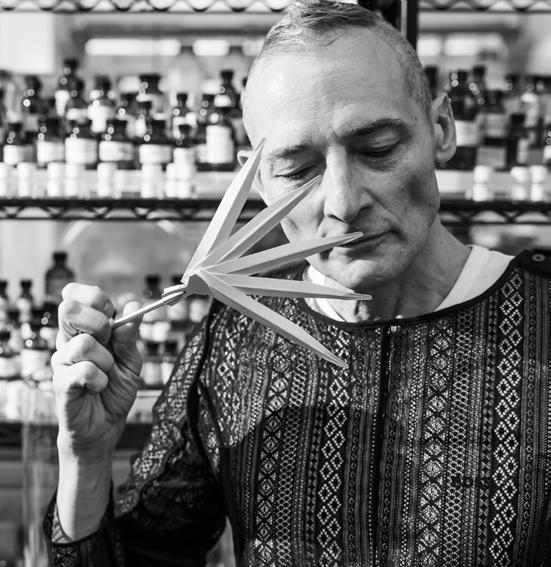
European Union cosmetic manufacturers are required to disclose 82 specific fragrance allergens on product labels, including 28 natural extracts and 54 individual chemicals. “Amid growing awareness of ‘forever chemicals’ –ingredients that can negatively affect [your] health – fragrance-makers are turning to AI to ensure their scents align with evolving ingredient and chemical regulations,” says Olivia, adding that AI fragrances also promise “relevance without compromise” by factoring in sustainability preferences, health considerations and even ingredient availability.
“AI ensures consumers receive scents that align with their values as much as their senses,” she says. “This creates a new kind of trust, where safety, ethics and individuality are seamlessly interwoven.” But when a key ingredient in a fragrance is “lost” due to regulations, tariffs or other supply chain concerns Osmo’s Generation OI can pinpoint an alternative ingredient that produces the same result within minutes.
For the scent-obsessed, perfume is an art form with the master perfumer’s personal touch a vital part of a delicate process. Experts say AI-perfumes will not interfere with the notes, the influences and the stories of your favourite perfume house. “What OI does for creators is enhance, accelerate and refine,” says Alex. “It doesn’t replace intuition, artistry, or the ability to create something deeply human. Instead, it removes blind spots and optimises formulas.” And this is where the magic happens – how about scents that develop during the day from light and citrusy in the morning to decadently woody by evening, or a fragrance that
bottles your grandmother’s discontinued classic, reclaimed for a new generation? It means more choice and endless possibilities. “There have only been 100,000 fragrances ever created, but I want that number to be in the millions,” says Alex.
Olivia says AI is an emerging “co-pilot for the fragrance industry” and is set to streamline everything. “AI’s role is not about replacing the craftsmanship and artistry of traditional perfumery but enhancing the personalisation of luxury scents. This aligns with the notion that luxury brands are embracing advancements in technology to cater to their discerning consumers.”
Moving further away from one-size-fits-all perfumes, the consumer will have much more power in the design process. Earlier this year, International Flavors and Fragrances (IFF), launched ScentChat™, an AI-powered tool developed to enable real-time communication between consumers and fragrance creators via platforms such as WhatsApp. Says Olivia:: “Tools such as ScentChat™ hint at a future where consumers will co-design personalised perfumes tailored to their mood, occasion or sustainability priorities. For brands, this blurs the line between producer and consumer, delivering richer insights into real-time preferences while positioning them as pioneers of participatory beauty.”
The technology not only refines the development process but also opens avenues for potential direct co-creation with consumers, reflecting their preferences. “For consumers, this delivers a sense of agency and intimacy rarely experienced in the fragrance world,” she adds.
Alex predicts the fragrance market is on the brink of expanding exponentially. “This is just the beginning for OI-designed perfumery,” he says. “Scent will become part of a brand’s DNA, going beyond consumer products to be part of art, experiences and culture.”
Osmo has worked with brands and creators who offer fragrances that consumers can purchase now, including The Museum of Pop Culture, The Tilted Chair and Kindred by Alice Panikian.
“We’re excited about another consumer project: Scent the Internet,’ Alex adds. “We’re tapping into culture and turning it into fragrance, starting with the fisherman aesthetic that took over the internet this summer. We’ve launched a limitededition scent called Where Water Ends, featuring notes of driftwood, musk, berries, marine, and lavender.” Samples can be ordered through the Osmo Instagram page @generationbyosmo for a limited time. “It’s about keeping up with what consumers care about,” says Alex.


Uncommon scents: The Future Laboratory (previous and main) says AI is significantly impacting luxury fragrance. Osmo CEO Alex Wiltschko (top left, ©Ben Hider) launched AI-led fragrance house, Generation.
AI IS NOT ABOUT REPLACING THE CRAFTSMANSHIP AND ARTISTRY OF TRADITIONAL PERFUMERY BUT ENHANCING THE PERSONALISATION OF LUXURY SCENTS
— Olivia Houghton, The Future Laboratory
YOU CAN ALREADY BUY AI-SCENTS
Far from being a distant fantasy, AI-driven perfumes are already hitting shelves and it’s likely your favourite luxury brands are on board. In her Vogue article: ‘Now the algorithm is coming for fragrance,’ Nateisha Scott gives some examples: “Tom Ford Bois Pacifique was shaped using Givaudan’s tools to evoke notes of California’s Big Sur, while the Paco Rabanne eau de toilette Phantom utilised EEG data measuring millennials’ electrical brain activity to identify the ingredient combinations that enticed them the most. Prada has used an AI-enhanced jasmine accord in its smash-hit Paradoxe, while YSL Beauty has employed AI to conduct blind testing of customers at its counter with three YSL fragrances tailored to their preferences in 20 minutes.”
Charlotte Tilbury has launched a debut fragrance range enhanced by AI. It consists of six scents including Love Frequency, Calm Bliss and Cosmic Power, created in collaboration with perfumers and neuroscience experts to rouse specific emotions in its wearers. Tilbury drew on data from Scentcube, IFF’s patented AI tool that identifies fragrance ingredients that “stimulate facets of different emotions”. They come in 18th century-style potion bottles.
thefuturelaboratory.com; osmo.ai
Ulysse Nardin’s Matthieu Haverlan reveals the journey to create the record-breaking Diver [Air] timepiece – and what’s in store from the architects of high horology’s Freak Nation
Words: Michelle Johnson
At this year’s edition of Watches and Wonders in Geneva, ground-breakingly original watchmaker Ulysse Nardin defied expectations yet again with the launch of its record-breaking Diver [Air]. The world’s lightest ever mechanical sports watch, the Diver [Air] weighs just 52g (including the strap) and, to the eye, the intensely skeletonised watch looks refined and delicate, belying its robust strength. In fact, the watch is water resistant to 200m and capable of withstanding a force of up to 5,000G –despite the fact that 80% of the watch is, simply, air. It took managing director Matthieu Haverlan and his team five years to bring this
technologically unique timepiece to life, working with five start-up companies on new materials, including Nylo-Foil (made of ocean netting combined with carbon fibre).
“The Diver [Air] is the lightest mechanical dive watch ever made,” Matthieu tells us. “For me, it’s the ultimate high-horology sport watch. It’s made to be worn while playing, not just while lifting the trophy.”
Describing Ulysse Nardin as the industry’s “oldest start-up”, Matthieu considers it the maison’s responsibility to advance the watchmaking industry through meaningful innovation. Its impressive inventions include the
Classic Perpetual Ludwig in 1996 (the first crownonly bi-directional perpetual calendar), the Freak DIAMonSIL in 2007 (an escapement created from diamond-coated silicon), and the Ulysse Nardin Grinder automatic winding system (introduced with the Freak S in 2022).
With recent novelties including the new Freak [X Crystalium] and Blast [Free Wheel Marquetry Silicon Green] offering impressive design savoir faire on top of the maison’s remarkable technology progress, it’s clear the only question is: what’s next?
Here, Matthieu dives deeper into the creation of the Diver [Air] to reveal what drives Ulysse Nardin’s unstoppable creativity. »
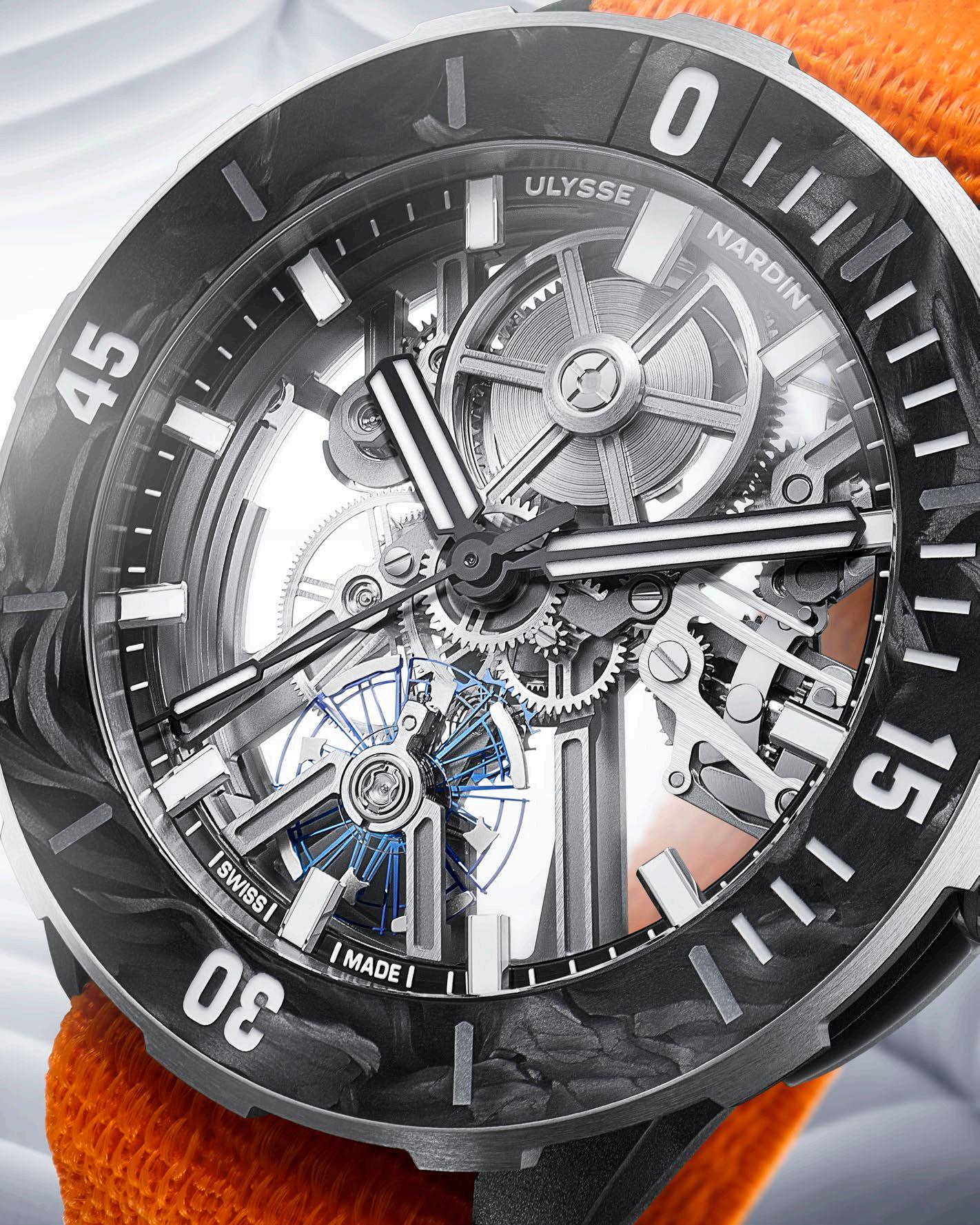
HAPPY
Matthieu, what inspired Ulysse Nardin to create the Diver [Air]?
It was five years in the making. We asked ourselves what the ultimate high horology sports watch could be and identified three ultimate challenges. The first was making a watch that was super lightweight and comfortable, so we set a 50g weight objective. Then, it had to be robust – we have a strong legacy of diving watches and water resistance timekeeping, but this can withstand G-forces of up to 5,000G, or the equivalent of a pro-golfer when he hits the ball, and is water resistant to 200m. Finally, there needed to be a high horology component at the core of the design, so we asked how we could elevate the skeletonised dive watch that we pioneered in 2021. The Diver [Air] features a beautiful, extremely skeletonised new calibre, the 374, of which 80% of the volume of the movement is actually air – only 20% is material.
Talk us through some of the development?
When you start a project like this, you have to focus on the challenge rather than the end result. We’ve used a lot of high-tech components, working with five different startup companies for the case alone. We use high-grade titanium for the movement, silicon technology in the escapement, carbon fibre that we upcycle from the foils of IMOCA racing boats – the fastest boats on the planet. We also make our Nylo-Foil using 40% carbon fibre and 60% ocean netting, recycled from ocean pollution. This is a pioneering material at Ulysse Nardin, which is super light and robust. So, combining titanium, carbon foil, carbonium and silicon, you have really that high-tech component.
Would you agree that the beauty and form of Ulysse Nardin timepieces really comes from the function of the watch?
Absolutely – and, in fact, even more so with the Diver [Air], because we had to solve that impossible
equation. Making something super light and robust, we had to really consider the architecture of the calibre. It’s the same architecture that you have in the Eiffel Tower – that triangle at the base supports a lot of weight, and it’s the same on the calibre. At the same time, because we want to have incredible watchmaking but also beautiful artistry, we’ve done whatever we can to make the movement more pleasing to see. We really tried to have that balance between functionality and having a watch that is beautiful to look at.
What inspires your own passion for watchmaking?
I was a collector before getting my first job in watches. I was 15 years old and working in Paris with my parents. I stopped in front of a shop window on the Rue Madame – it was Antoine de Macedo selling vintage timepieces – and I was amazed. I became obsessed with watches. They’re beautiful objects, I like the stories attached to them and the fact they can be passed on from generation to generation. In our very digital world, watches are probably the only thing left that are completely mechanical. I’ve been working for the Ulysse Nardin for nearly nine years, and I like that it has a huge heritage and a pretty unique edge within the industry. I’ve been leading the brand for a year and I’m living my best life – I do my dream job.
Many of Ulysse Nardin’s material development has a sustainable element to it. Is that central to your DNA?
We have a strong bond with the sea, and that’s why we finance [ocean conservation NGO] Plastic Odyssey. We want to play our part in raising awareness about plastic pollution, while serving our highest purpose. But, to clarify, we don’t start with the intention of making the most sustainable watch. With the Diver [Air], our objective was to make the ultimate high-horology sport watch, so we wanted

to use the best materials possible. If we can have an authentic story that allows us to raise awareness on important topics then even better – but it’s never at the expense of having the best material possible. At Ulysse Nardin we like to add an element of challenge. Using ocean netting for our Nylo-Foil makes sense because it’s the perfect material for the combination of lightness and robustness. While we could get the same composition elsewhere, this also lets us raise awareness of ocean pollution. Equally, the carbonium that we get from the foil of the boat is created within the boatmaking process, so using that leftover carbon fibre means we’re using a superior product while still having a [positive] environmental impact.
Ulysse Nardin always raises the bar in terms of innovation. How do you keep that edge?
For me, it all comes down to relevance, to creating with purpose. If you’re innovating just to show off, then I have no interest – what’s the point? If you really want to advance the watchmaking industry to make it better, then it becomes exciting.
Ulysse Nardin has been advancing watchmaking since the very beginning. We created the Classic Perpetual Ludwig in 1996 to make it easier for the consumer; we created DIAMonSIL to build a new and improved escapement that needed lighter material, with more precision and less friction to work – solving a problem that even Abraham Louis Breguet could not fix. The Ulysse Nardin Grinder, which we introduced with the Freak S, is the most effective winding system on the planet and, when the patent expires in a decade, I’m sure other brands will copy it, but I will be very happy because that means we will have brought progress.
I think our responsibility extends to the industry itself, and so I’m happy that Ulysse Nardin is inspiring other watchmakers. That is why we innovate.
ulysse-nardin.com
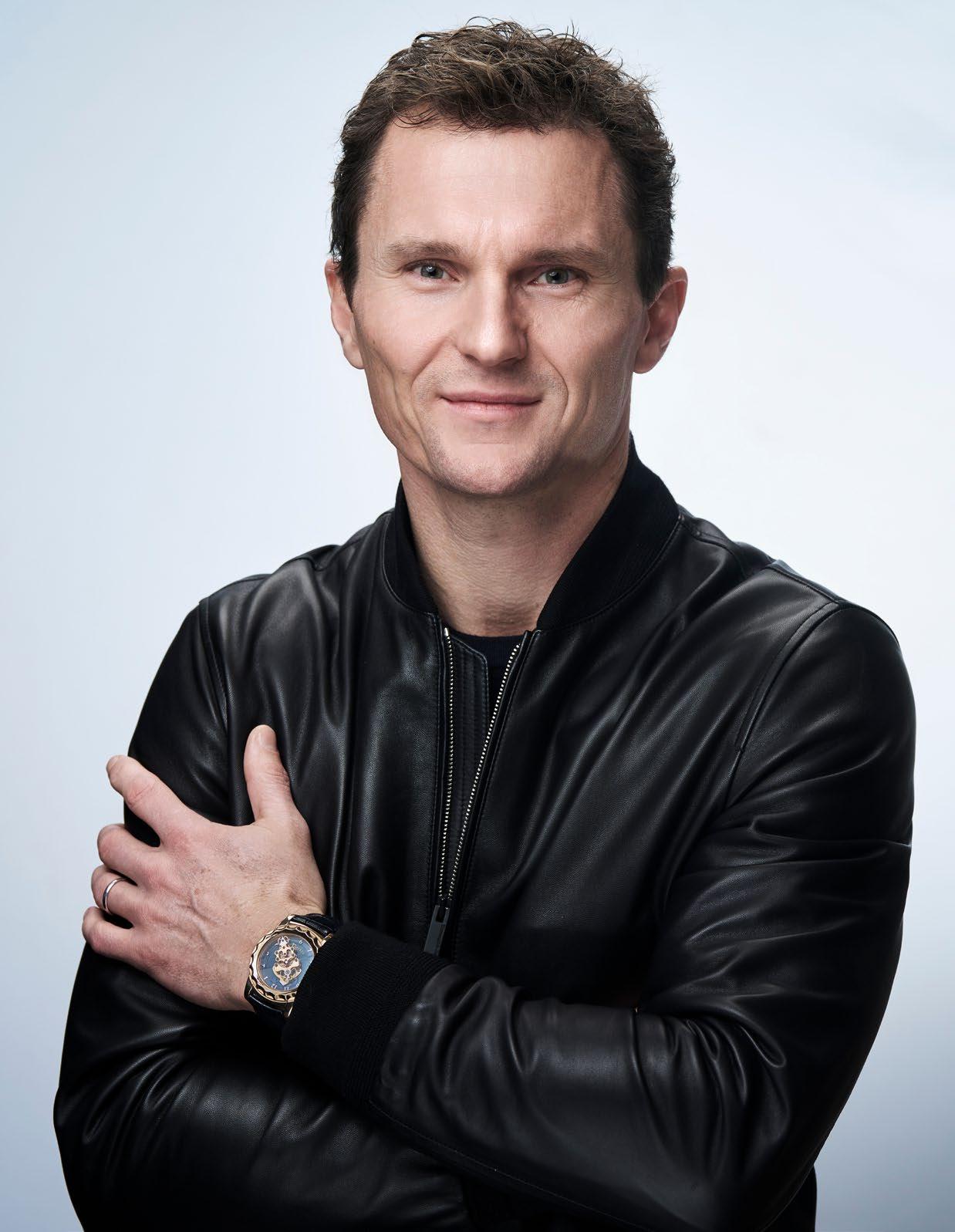
Tempus heads to Whistler
Blackcomb to find out how the famous ski resort – beloved by royals, celebrities and sporting professionals – is continuing its uphill trajectory
Words: Rory FH Smith
Ski holidays in North America can be a tough sell for Europeans. Here in the UK, we’re spoilt for choice when it comes to hitting the slopes. In a matter of hours, we can be transported to a picture-perfect Alpine winter wonderland, complete with cute wooden cabins plucked from the pages of a fairytale. Take your pick: France, Italy, Switzerland and Austria – but also Norway, Sweden, Finland or Bulgaria, Slovakia, Poland and Romania for those adventuring outside of the Alps.
So, for anyone sitting in Europe planning their next ski holiday, the idea of a 10-hour flight before you’ve even reached the slopes is a tough barrier to overcome. In short, there needs to be a good reason to go all that way: which is exactly what I thought when staring at the Air Canada in-flight map half way across the Atlantic on my way to my first long haul ski trip.
I’d always heard great things about Whistler Blackcomb. Known as a favourite destination for royals, celebrities and sportspersons – including Prince Harry, the Duke of Sussex, Oscar-winning actor Leonardo DiCaprio, and action star Tom Cruise – friends would wax lyrical about the sheer size and scale of the resort. It is the largest in North America, with 8,000 skiable acres, more than 200 runs, 16 alpine bowls and three glaciers, all serviced by 35 lifts. Others would praise the off-piste activities; the food, shopping, spas and stunning big sky vistas from the top of the mountains. But few had listed the journey to Whistler itself as a highlight.
Journeying to the mountains is usually a pleasure – the growing sense of excitement as the snow-capped peaks on the horizon draw nearer, and the narrowing road that starts to snake upwards, signalling the final few miles. But it’s a little different en route to Whistler. Think supersized, screensaverworthy Pacific coast vistas dialled up 11, and you’ll come close to imagining the beauty of the ‘Sea to Sky highway’ – a 75-mile stretch of Canada’s Highway 99 that twists its way from Vancouver to Whistler Blackcomb along cliff edges and through dense pine forests. It’s one of the greatest stretches of road I’ve come across in North America and, better still, it serves as the express route to Whistler Blackcomb. »




WHISTLER HAS LONG BEEN DESCRIBED AS THE HOME OF BIG MOUNTAIN SKIING – AND IT’S EASY TO SEE WHY
Compared to most resorts in the European Alps, Whistler is relatively young. Celebrating 50 years this year, Whistler was first established as a ski resort in 1975, but its origins as an occupied region go back thousands of years, when the Squamish Lil’wat First Nation communities settled there. In the years before the resort was created, the area was known as Alta Lake – a fishing camp, turned logging town, turned haven for early ski bums and hippies. But all that would change when a chap called Franz Wilhelmsen joined a group of businessmen to form the Garibaldi Olympic Development Association (GODA) in the early 1960s. They aimed to bring the Winter Olympic Games to Whistler Mountain – a site at the northern end of Garibaldi Park – and develop it as a year-round resort for summer and winter recreation. Despite
the bid failing to clinch the 1968 Winter Games –hosted in Grenoble, France – the foundations for Whistler’s future had been laid.
Just across the valley, Blackcomb Mountain opened a little later in 1980, backed by a new wave of visionaries determined to challenge Whistler’s dominance. The rivalry between the two resorts proved transformative, with both determined to innovate with faster lifts, improved infrastructure and more amenities –until the decision was taken in 1997 to merge, creating Whistler Blackcomb, the largest ski resort in North America. A decade later, the two mountains were united by the 2.7-milelong Peak 2 Peak Gondola, which broke three Guinness World Records as the longest, highest and fastest single-cable cabin lift when it was finished in 2008. In practice, it enables you to cover off both vast mountains and all their
hundreds of runs in just one day.
Checking into the Fairmont Chateau Whistler, it’s hard to find a hotel closer to the slopes. Perched at the base of Blackcomb Peak, the Fairmont is a cosy but Cathedral-like allseason ski-in/ski-out resort with sweeping mountain views and all the trimmings you’d expect from a five-star hotel. Much like the resort it’s based in, the Fairmont is on a scale unlike anything you’ll find in the Alps: the rooms are spacious, with modern Alpine-style interiors and the food in all three restaurants on point – prime steaks, grilled fish and Atlantic oysters by the fire in the Grill Room is exactly what’s needed after a day on the mountain. When it comes to stretching out, there’s a fully equipped gym located next to the centrepiece indoor and outdoor swimming pool, that’s kept steaming hot morning, noon and night.





Finding time to explore the town isn’t easy when there’s so much to see and do on the mountain but wander down the snowy, tree-lined trail from the Fairmont and you’ll soon enter a world of cute, albeit newish, shops, bars and restaurants. Given its half the age of the towns you’ll find in the Alps, it’s doesn’t quite carry the same charm or architectural clout as its European rivals, but the spread and selection of shops on offer is superior.
For food, head to Wild Blue, tucked away in the corner of the town. After two cocktails, you’d be forgiven for thinking you’re in one of Manhattan’s best speakeasy bars and the menu matches up to anything you’ll find in London, New York or any gastro city you can think of. For rocket-strength coffee there’s Arabica, and for a breakfast or brunch head to Provisions. And let’s not forget the classic North American trait of ‘service with a smile’, which you’ll find all across Whistler Blackcomb. Europe: take note.
Before I know it, it’s time to take the transfer back to reality and fly home from Vancouver. When it comes to skiing, Whistler Blackcomb has it all, with 200 runs over 8,000 acres. With a season-long Epic Pass in hand, beginners and seasoned pros alike have access to everything from long and gentle winding runs that cover off most of the mountain with spectacular views, to endless challenging trails, steep faces, couloirs and powder bowls.
Whistler had long been described to me as the home of big mountain skiing and it’s easy to see why. Beyond the traditional, ski terminology sense of the word, it’s simply vast – skiing at scale and with more choice in everything from ski runs to shops and speakeasy-style bars than most Europeans could dream of. Getting back on board the bus to travel down the oh-so-picturesque Highway 99, it dawns on me that there’s not just one good reason to opt for a ‘long-haul’ ski holiday – there are many. For those looking to ring the changes this ski season, it’s well worth looking a little further from home.
fairmont.com; vailresorts.com; epicpass.com



Whether you’re on a fitness challenge or simply looking for a way to connect with the landscapes as you travel, these remarkable running routes around the world are certain to help you gain more ground
Words: Tessa Crowley
Fuelled by a renewed appetite for connection and culture, the joy of running goes far beyond fitness as it’s driven by movement, mindfulness, and community connections. Combined with a trend towards travel for education and exploration, it’s no wonder voyagers are taking to the trails in droves; quite literally veering off the beaten track to soak up the sights and undiscovered corners of destinations, seeking new vantage points in nature and city streets alike.
Whether there’s a big race on the horizon
or you’re simply stretching your legs during your exploration, a running holiday is an easy and energising way to discover a destination. Merging movement with navigation, it’s a sure-fire way to get to grips with a new place, familiarising yourself with its nooks and crannies, discovering its unique beat, absorbing the culture and spotting hidden gems and curious corners worthy of later investigation.
Ready to take your trainers on your next adventure? Consider one of these spots known for their culture, cafes and sprawling vistas – the perfect excuse to pound the pavement. »
Towering mountains, crashing waterfalls, and alpine lakes – the Bernese Oberland (right) has it all. At the foot of the Eiger mountain, Grindelwald offers a scenic starting point for those looking for a multiday excursion in the Swiss Alps. Trace a section of the Via Alpina, following well-groomed trails from one village to the next, and discover a mix of invigorating uphills, switchback trails, and far-reaching views. For the literary-inclined, traverse the nearby valley floor into Lauterbrunnen, to retrace JRR Tolkien’s footsteps and discover his inspiration for Rivendell, the fictional Elven city of Middle-Earth. Alternatively, mountainous routes offer ever-changing alpine flora and an abundance of wildflowers, with innumerable views and vistas along the way. This region’s restorative aura is unescapable, with fresh air, aweinspiring panoramas, and the gentle sound of cowbells in the distance a soothing soundtrack to your stay. Up the mountain, traditional huts offer a truly immersive cultural experience, or head to one of the many villages for more luxurious options, spas and wellness experiences.
Imbued with a sense of stardust from the moment you spot the famed film studios, the sprawling City of Angels – renowned for being a driving city – may not be the obvious spot for a “runcation”. But step away from the hustle and bustle of the highway and there are a wealth of spots to explore. In Hollywood, every block is buzzing with the city’s cinematic industry, with towering walls screening studios large and small.
Inland, Griffith Park beckons, offering undulating trails under the famed Hollywood sign (below), expanses of National Park to the north and the city itself sprawling to the south. Run up to the Griffith Observatory for a quick cultural fix, or wind deeper into the many canyons and trails before heading back along Franklin Avenue to refuel with fresh juice, an array of cuisines, and pop into Counterpoint, which sells vintage vinyl and collectible books. Alternatively, hop in the car and enjoy the drive up the coastal highway to Malibu for a surfer’s paradise, stunning beach views and imposing beachfront houses.
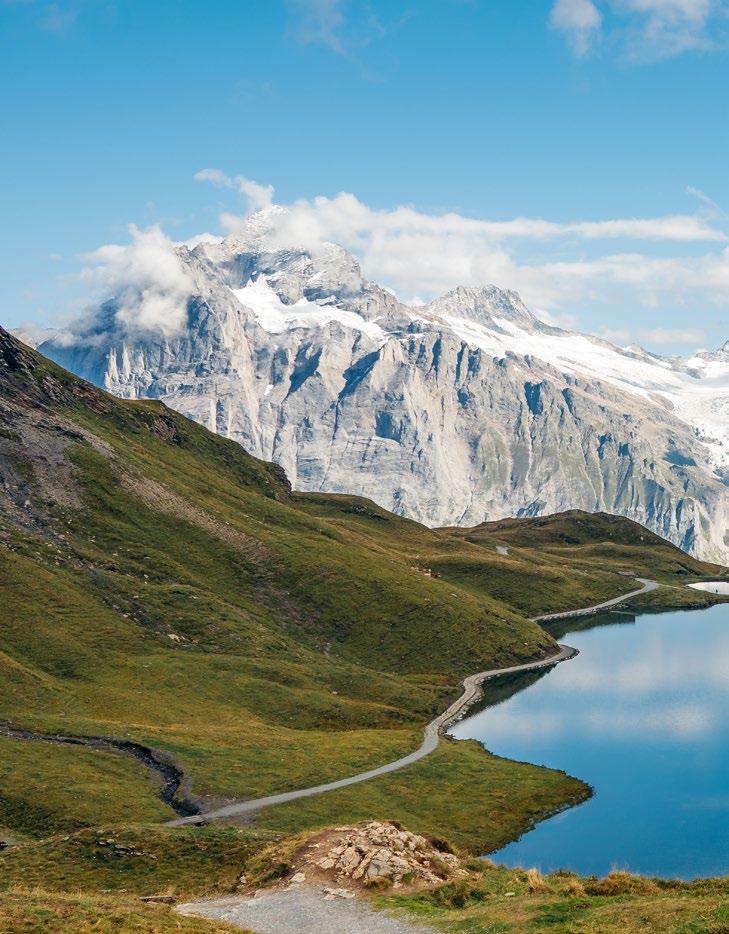
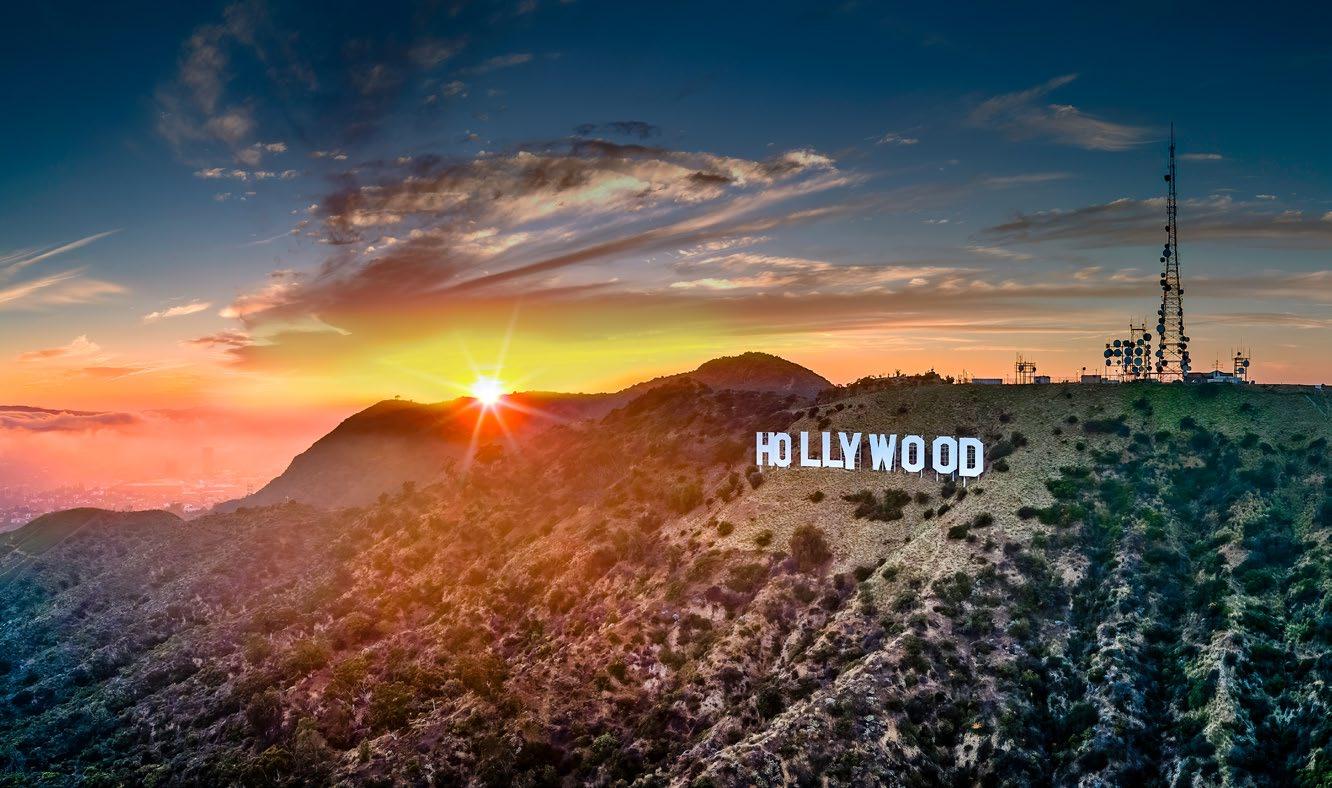
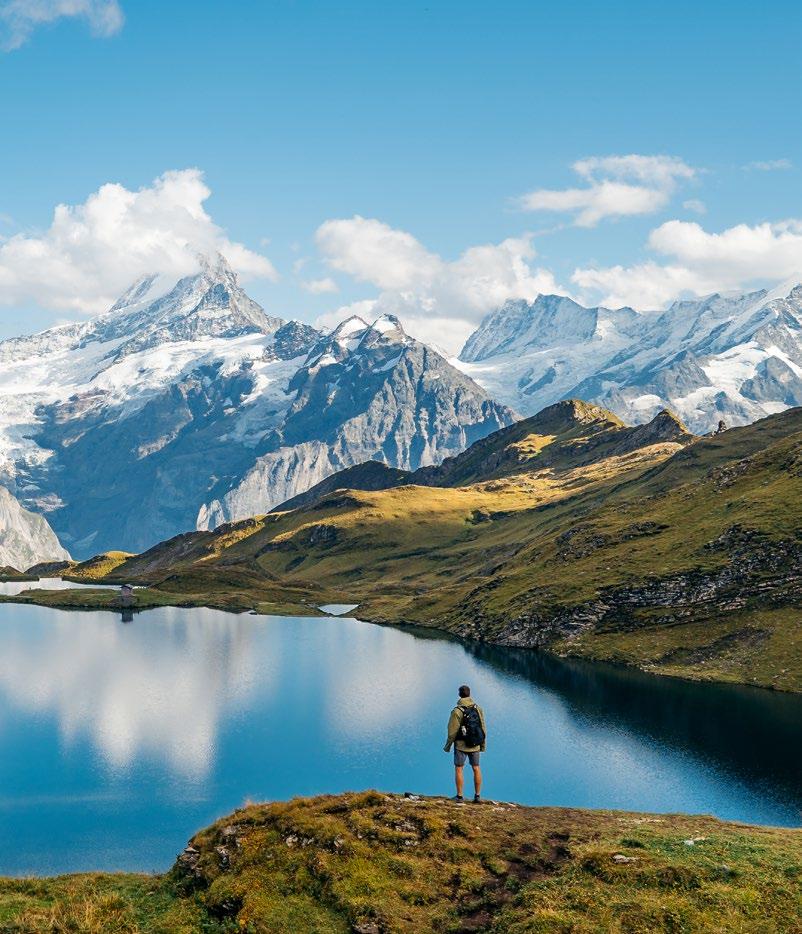
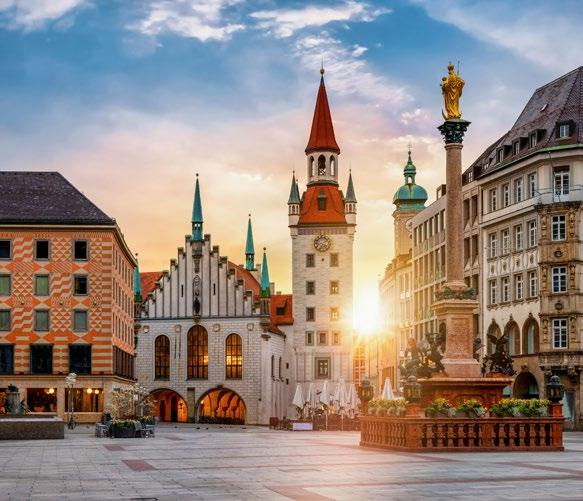
With not a hill in sight, Munich’s pristine city centre (above) and spacious streets makes it a prime location for sightseeing on the run. Mingle with Munich’s well-heeled and impeccably dressed citizens, head to the Old Town and its imposing northern quarter to discover the most exclusive boutiques and hotels, from Rosewood Munich to Bayerischer Hof.
Visit the Marienplatz for towering architecture, or trace the paths through the English Garden, for wide open lawns and miles of greenery. For history enthusiasts, bullet holes in the city’s brickwork hark back to its significant past. Take time to stop off at Hofbrauhaus brewery, the city’s most famous beerhall, or one of Munich’s many beer gardens.
On the run: Sightseeing city runs in Copenhagen and Munich compete with the beauty of natural trails in Switzerland and California in our pick of the best runcation destinations
With a compact city centre brimming with architecture and history, Denmark’s capital is easily explored on the run. Start at the Citadel fortress for a slice of living military history and to view the city’s famed Little Mermaid bronze statue (right), before winding your way south through the city’s design district, bursting with museums and galleries. Take in the enchanting rosefilled Rosenhaven gardens and the 17th-century Rosenberg castle, before turning into the city’s winding streets where traditional stores, cafes, and restaurants abound.
For morning runners, a quick refuel stop with pastries and coffee is the perfect post-run sugar hit or, to truly live like a local, head to one of the many harbour and city swim spots. Many offer changing rooms, water quality alerts, and – if that doesn’t tempt you – the promise of sauna to ease aching limbs. Elsewhere, the city’s famed covered market, Torvehallerne, offers an array of appetising treats and specialty gems or, if the legs allow, a trip up to the winding Rundetaarn round tower offers unparalleled views of the city below.
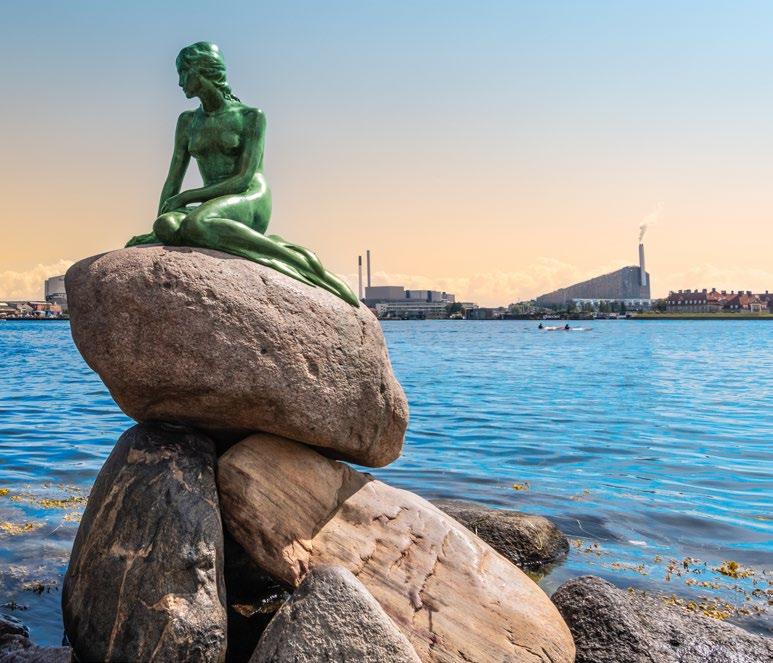

Dedicated to travel, time and exceptional savoir-faire, Louis Vuitton’s pocket watches are far more than just a timepiece
There’s an undeniable romance in the click of a pocket watch, a sound and sensation that conjures a bygone era of cross-continental journeys and the anticipation of adventure. Unlike the fleeting buzz of a smartphone – or, indeed, the quick access of a finely made wristwatch – the pocket watch is all about patience and ritual, of savouring each fleeting moment.
This combined sense of elegance and adventure is central to Louis Vuitton watches’ three remarkable Escale pocket watches – Escale au Pont Neuf, en Amazonie, and a Asnieres. Each piece features Jacquemart-style mechanisms powering seven animations, minute repeater and tourbillon, while the extraordinary dial animations push the maison’s Métiers d’Art further than ever before through the use of exquisite design, materials and artisanal technique.
Created at La Fabrique du Temps Louis Vuitton in Geneva, the watches are powered by the maison’s proprietary LFT AU14.03 calibre mechanical movement and encased in 18k white gold case. Each dial measures an impressive 50mm diameter and 19mm thickness, allowing the animations ample space to impress.
The moving elements of each piece takes La Fabrique’s team 140 hours to complete, while the intricate enamelling of each dial could take up to 300 hours – the equivalent of two months – for a truly unique and special finish.
Keeping with the spirit of adventure, the Escale en Amazonie (inset, top) showcases the wild
fauna and flora of the Amazon rainforest. The audaciously creative piece presents a unique double perspective, with seven animations that bring the lush vegetation to life on the dial, while the transparent caseback displays the intricate mechanisms – and the beautiful hand-finishing thereof.

Activated by a slide piece at six o’clock, the animation shows a pirogue stacked with Louis Vuitton trunks gliding through the rainforest. The trunks open to reveal golden LV Monogram flowers, observed by moving wild animals – a pair of parrots, a snake and a monkey – as a sculpted gold rose compass spins above.
Next, as an ode to Louis Vuitton’s trunkmaking heritage, the picturesque landscape that adorns the dial of the Escale au Pont Neuf (right and inset below) depicts the history of the maison’s founder, showing Paris’s oldest bridge (Pont Neuf) from the banks of the river Seine. As the minute repeater chimes, the stunning animation shows a barge moving from left to right, carrying a selection of Louis Vuitton trunks that open to reveal the golden LV monogram flowers, as the French flag flies on the bow. An orange banner marks the maison’s headquarters as a pair of sparrows overlook the scene. The Métiers d’Art team combined miniature and champlevé enamel to create the iconic scene, while the automation is framed by the diamonds and coloured stones set into the bezel.
Both pieces enhance the standard set by the house’s first pocket watch, the Escale a Asnières, which paid tribute to the Louis Vuitton family home in Asnières through the remarkable interplay of Métiers d’Art techniques by master enameller Anita Porchet and market engravier Dick Steenman. In this first watch, the sun rotates above a scene showing a horse-drawn carriage moving across the dial. The horse’s legs move as the coachman’s arms gee them on, while trunks stacked in the carriage open to reveal the LV monogram flowers that has become so emblematic of the brand – in every era.
louisvuitton.com
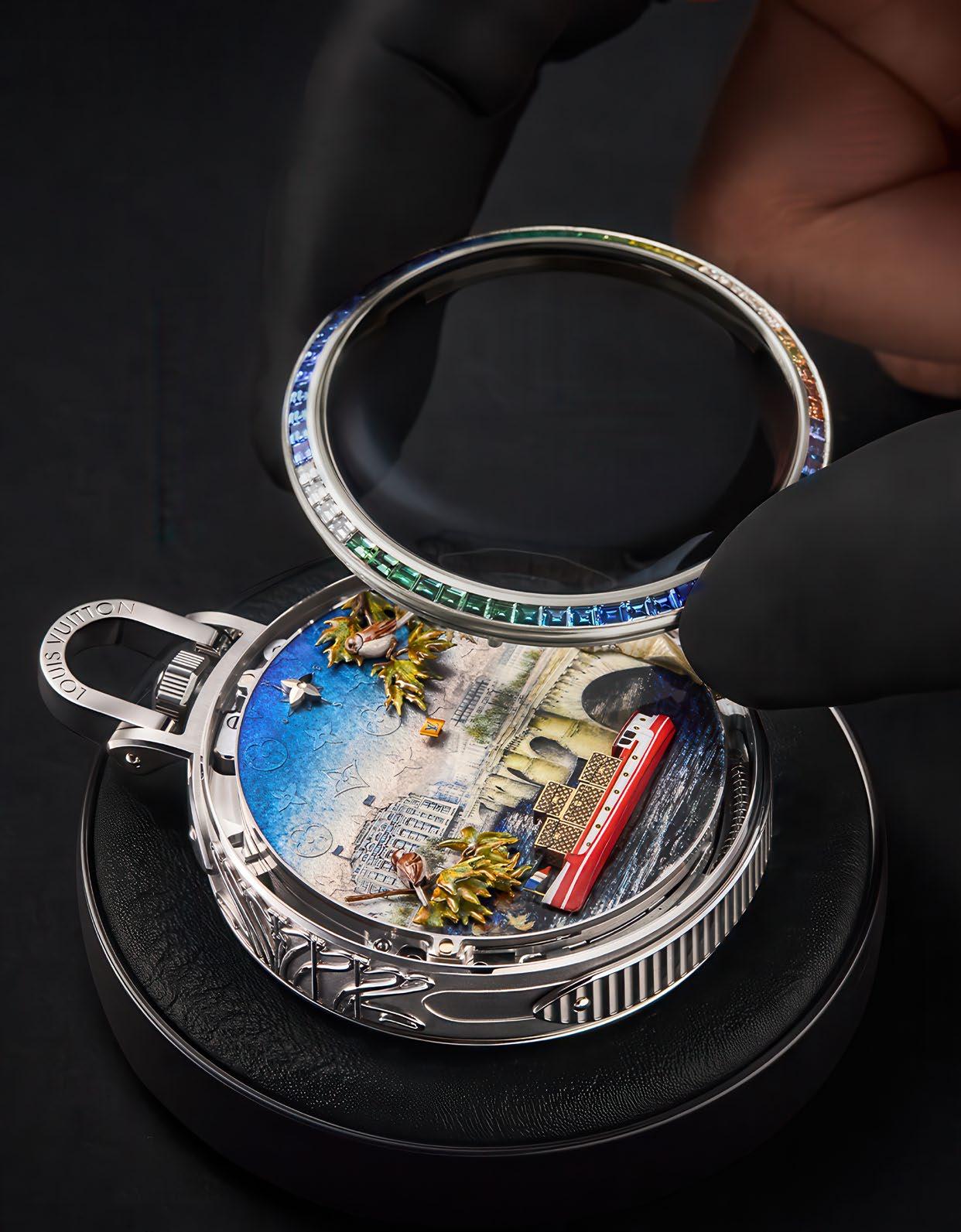
With a new exhibition exploring the changing seasons, Tracing Time, set to debut at the Roof Gardens, artist and environmental activist Leah Wood discusses the art of slowing down
Words: Lysanne Currie & Ali Catterall
It’s the day of the autumn equinox and artist Leah Wood (near right) is sitting in her countryside home talking, appropriately, about the seasons and how they inspired – and guided – her new exhibition, Tracing Time
“I’m really excited,” says Leah. “[The exhibition] has taken me two years, because it’s gone through the seasons. From winter to spring, summer, autumn, and then back to winter.”
The show, a collaboration with her friend,
actor and fellow artist Jemma Powell (far right), is to be held at the Roof Gardens, Kensington, from 16-29 October during Frieze London. The work explores the relationship between urban and natural environments and how they shape our perceptions of time and emotion.
The project came from Leah’s desire to do something slow and immersive – a counterpoint to the world’s relentless pace. From Tim Burton-esque winter trees to delicate summer roses, and the intricate poppy capsules left behind, her work invites viewers to slow
down and appreciate the beauty and subtlety of the changing natural world.
“I wanted to trace the seasons in the countryside,” says Leah. “I’ve never done that before, and it takes time because you actually have to work with Mother Nature. You have to be patient – especially in this day and age where everything is now, now, now. Sometimes winter lasts three or four months. You’ve got to pay attention to what’s happening with the trees, with the landscape, to really understand that moment in time.” »



For Leah, art is a refuge. “As an artist, I go to my art to decompress. I spend hours in the studio painting, losing track of time,” she says. “But I learned that I like working outside. In winter, it was, ‘How quickly can I do this?’ But when spring and summer came, I’d get my shorts on, drag the canvases out and take my time.”
Light, she says, changes everything. “In springtime, the light was completely different from summer. Painting in the garden, the dappled light came through the trees at two in the afternoon, so you’d have to work quickly. Just yesterday, the light was amazing. I was picking up my daughter and looked across the countryside at five in the afternoon – it was like a Turner painting. I thought, ‘This is why I’m happy to be alive.’”
Previous exhibitions have included 2022’s
One Planet. One Chance, highlighting the climate crisis, while she regularly collaborates with sustainable brands and charities including Sky Diamonds and Sea Shepherd.
In addition to her own showcases, Leah also has some major commissions under her belt, including hand-painting more than 100 lifelike English butterflies on the terrace of Mandarin Oriental Hotel, London.
Her art, which combines traditional oils and materials such as cling film (to draw attention
to plastic pollution), typically focuses on nature and endangered species – such as Minerva, the Amur tiger at Woburn Safari Park, which she painted for this year’s National Tiger Day.
The daughter of Rolling Stones guitarist Ronnie Wood, Leah credits a grounded upbringing and extensive travelling for shaping her perspective – and aims to keep her own children, Maggie and Otis, similarly ‘earthed’ amid a world of screens.
“Kids have to start looking outward at the beauty around them,” she says. “I try and get them walking with the dogs, into nature, so they see why mummy does what she does.”
Leah moved to Sydney, Australia for three years shortly after graduating from Chelsea College of Art and Design. Her time living in Sydney left her ever grateful for the UK’s rhythm. “We’re very lucky in this country to have the seasons. I spent three years in Australia and missed the English seasons so much.”
Like most artists, Leah describes herself as her “own worst critic – my husband [Jack MacDonald] tells me to be proud, but I haven’t done enough yet, I need to do more. I want to push my boundaries; see how far I can go.”
Still, nothing matches the thrill of seeing her
work connect. “I still get a buzz when my art sells. When my piece sold at The Future is Female [2024 mixed exhibition], I cried.”
In addition to Tracing Time, Leah and Jemma are collaborating with TimeGivers – a West London-based charity that partners with schools to integrate volunteering into education, helping to empower young people aged 4-18 to engage with their local communities and develop practical skills – and St Lawrence Primary School to create a permanent mural in Feltham Park. As part of this, 10% of the profits from Tracing Time will also go TimeGivers.
Meanwhile, Leah has plans to create “10 or 12 canvasses for an ocean charity in Africa”, and is set to launch a collaboration with fine jeweller India Mahon, whose contemporary collection utilises sustainable and ethically-sourced materials, later this year.
Now, as autumn sets in, Leah is continuing her goal to connect with nature and the seasons by getting ready to harvest apples and plums with her mum, Jo Wood. Soon, she says, it will be time to: “Light the candles, get out the soup, like the Nordics do. In the UK, we need to embrace Hygge – that feeling of a big hug when you finally come in from the cold.”
leahwoodartwork.com




A diverse investment portfolio is often said to be the key to meaningful returns – and these uncommon and unexpected investment trends are putting the fun-factor back into finance
Building a truly diverse investment portfolio isn’t just about balancing stocks, bonds and real estate – it can also mean looking beyond traditional assets to the rare, sentimental and, occasionally, the truly unexpected.
For many investors, the excitement of acquiring collectable items that hold personal meaning or historical significance adds a unique dimension to building wealth. While fine art, classic cars and even property have long been recognised as smart ways to grow one’s portfolio alongside stocks and shares, recent years have seen a surge of interest in rare collectibles and unconventional investments.
From vintage comic books and memorabilia to rare coins and stamps, these passion-driven assets can offer both emotional satisfaction and impressive financial returns. As markets evolve and collectors become savvier, the world of alternative investments continues to expand, blending nostalgia, history and the possibility of lucrative returns.
Words: Shivani Dubey

A classic area of investment, there is no limit to the passion for fine wines and whisky. According to the Oeno Group, 27% of HNW investors plan to invest in whisky in the next three years, versus 15% for fine wine. So where does one start? The latest trends in fine spirits and liquids goes beyond the bottle to the heritage and storytelling itself. Look for discontinued brands, rare casks and specially designed bottles that will appreciate in value as the liquid matures. A great place to start is Diageo’s Rare & Exceptional collection, which features investment-worthy brands such as Justerini & Brooks, Jonnie Walker, Don Julio and Port Ellen – which recently reopened after four decades of closure. Port Ellen’s reputation as ghost distillery has served to make its liquid highly coveted – and highly priced, with bottles and casks selling at auction for record prices. Its Prism 46 Year Old 1978 (right) is predicted to fetch £150,000-£300,000 at this year's Distillers One of One charity auction. »
diageo.com; oenogroup.com
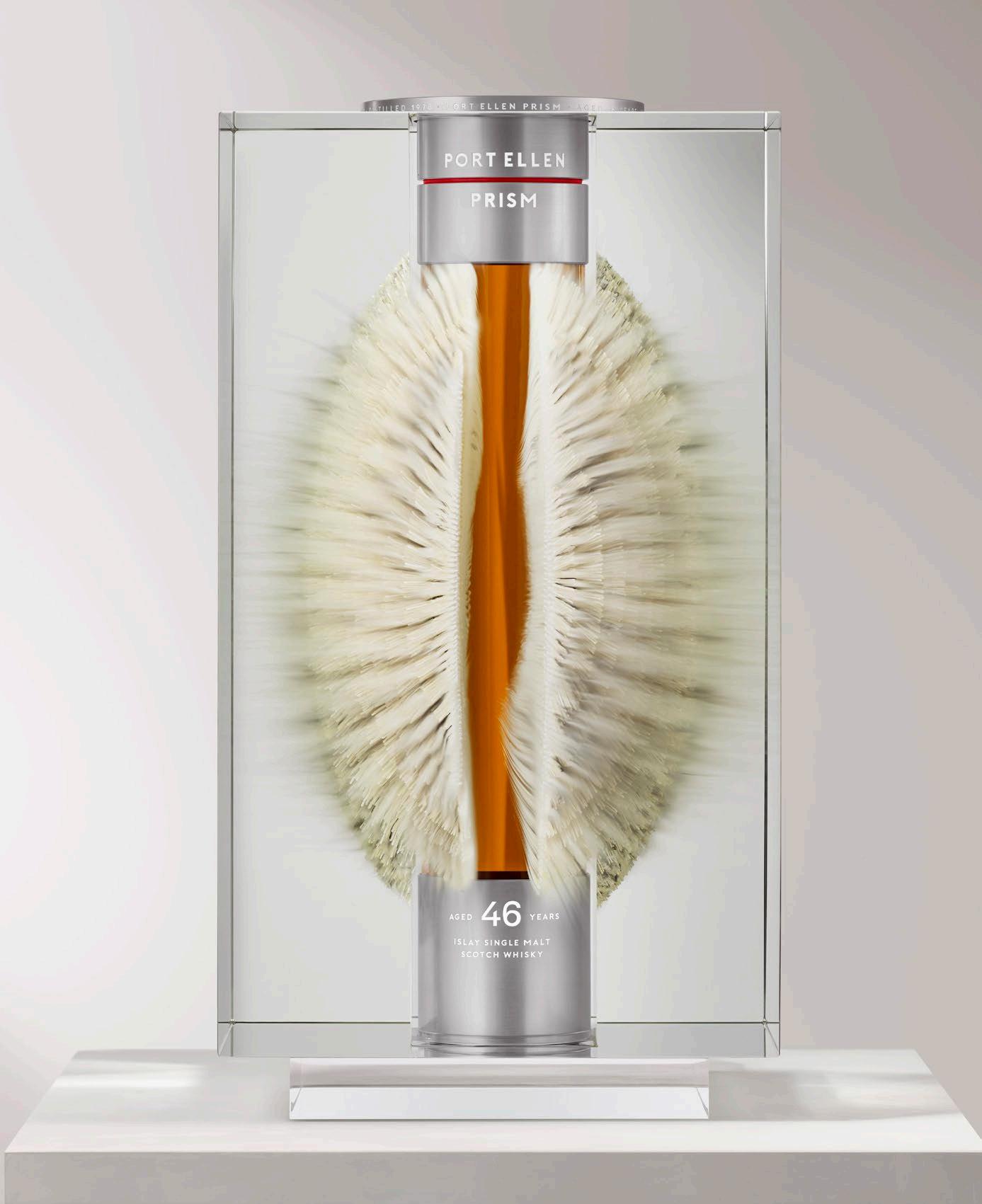

As lovers of cars and yachts will know well, ownership is often more than just the product; it is a lifestyle. From classic car meets to driving accoutrement, yacht shows and sailing style, there is a world built around our favourite machines that allows us to show and share our passions. Enter Amalgam, a brand that builds lifelike scale models of cars by famous marques and from automotive history, allowing owners to expand or reflect their car collection in miniature form. These pin-point accurate models have become high value investment pieces that showcase your automotive passion – while never losing the element of fun. As Amalgam founder Sandy Copeman says: “In the secondary market, resale values typically achieve at least the original retail price. Thanks to both the intrinsic value of the product and the strength of the brand, we expect those values to remain resilient and continue tracking in line with inflation.”
amalgamcollection.com
THE EXCITEMENT OF ACQUIRING COLLECTABLE ITEMS THAT HOLD PERSONAL MEANING ADDS A UNIQUE DIMENSION TO BUILDING WEALTH

Coin collecting is one of the oldest hobbies in the world – with famous numismatists including actor Jack Black, French king Louis XIV and Roman Emperor Augustus – and a rare collection can offer serious financial interest. Whether your collection focuses on historic coins or rare mistakes, this is one investment that never goes out of style. Similarly, currency collecting can be a lucrative investment that offers far more return than what seems at face value. Money itself has changed over the years – from new currencies to changing mints – and sets based on antiquated larger notes, mint-perfect recent currency issues and notes that were, at the time of printing, redeemable for silver or gold at national banks, can make for a great addition to your portfolio. Start your journey with The Royal Mint’s guide to starting a collection.
royalmint.com


With the NFT market in steep decline, art collectors are returning to physical pieces that connect us to our communities and the natural world. In addition to blue chip artists –like Andy Warhol, Pablo Picasso, Jean-Michel Basquiat, Banksy and Damien Hirst – who remain a fixture of valuable art investment, London galleries including Maddox Gallery and HOFA (the House of Fine Art) identify key trends that are igniting interest in the art world, including nature-infused artwork, such as David Hockney’s landscapes; highly textural pieces like those by Ilhwa Kim and Gordon Cheung; retro and vintage revival; and oversized abstract art that makes a true statement.
maddoxgallery.co.uk; thehouseoffineart.com
Fund-factor: Port Ellen Prism 46 Year Old 1978 (previous). Clockwise from top left: Amalgam Bentley Birkin Blower 1929 at 1.8 Scale; artist Andy Warhol's screen prints of Marylin Monroe; inside the Country Music Hall of Fame, Nashville; 13th-century Byzantine gold coins.
In an age of streaming services and TikTok trends, one would be forgiven for thinking the days of shelves packed with our favourite records would be well and truly over. However, music lovers will be delighted to discover that vinyl records are sustaining and exceeding their expected value – thanks to a resurgence in sales driven, in part, by Gen Z investors. For truly remarkable pieces, look out for first and limited-edition pressings, significant artists, the physical condition of the record (and whether it has its original inserts and sleeves), and even printing mistakes and unusual quirks. The most expensive records ever sold include Elvis Presley’s first pressing – ‘My Happiness’ – bought by musician Jack White for $300,000 in 2015 and the first copy of the Beatles’ 1968 White Album, sold by drummer Ringo Starr for $790,000. The most expensive vinyl ever sold was the Wu Tang Clan’s Once Upon a Time in Shaolin – a one of one record pressing – which was sold at auction for $2m (£1.5m) in 2015.
Wealth is changing hands – and Gen Z is rewriting what it means to be wealthy. Born between 1997 and 2012, this generation, along with their elder Millennial siblings, is about to inherit a jaw-dropping $90 trillion from the Baby Boomers. Yet far from passively collecting a handout, they’re transforming it into an entrepreneurial mix of profit, purpose, and sustainability. We find out how Gen Z is shaping the future of wealth
Words: Lysanne Currie
Over the coming decades, the ‘Great Wealth Transfer’ will mark the biggest generational handover in history – a tidal wave of capital flowing to the youngest wealth holders. But if anyone assumed this apparently fragile, TikTok-addicted lot were about to squander it, they’re dead wrong. Generation Z grew up under the crushing weight of soaring inflation, spiralling housing costs and student debt. And while the Bank of America forecasts Gen Z income soaring to $74 trn by 2040, many are struggling to save right now amid rising living costs.
Meanwhile, on this side of the pond, a recent UK study highlighted a “shame gap” for Gen Z, with 63% feeling judged for their money habits – while 25% report their present income doesn’t cover essentials.
Yet this is a resilient, optimistic, cautiously pragmatic generation. Far from spending sprees and frivolity, Gen Z is all about the long game, prioritising saving and cautious investing over immediate gratification. As Sarah Porretta, CEO of Young Enterprise says,
“The myth that young people are careless with money just doesn’t hold up. Gen Z want to be financially capable.”
In a sharp contrast to earlier generations, a whopping 54% start investing by 21 years old, way ahead of their older Millennial or Baby Boomer predecessors – and they’re poised to surpass other generations in opening savings accounts. Wealthier types are buying stocks or investing in private markets – while real assets have become key parts of their growing portfolios.
Not for nothing have they earned the nickname “Generation Startup.” More than 60% of tech-savvy European Gen Z entrepreneurs plan to launch their own (mainly digital) businesses within a few years – and testament to their resilience, nearly half are funding these ventures themselves. There’s also been a 38% rise in ultra-high-net-worth Gen Z women in recent years, typically those who have inherited family businesses. »
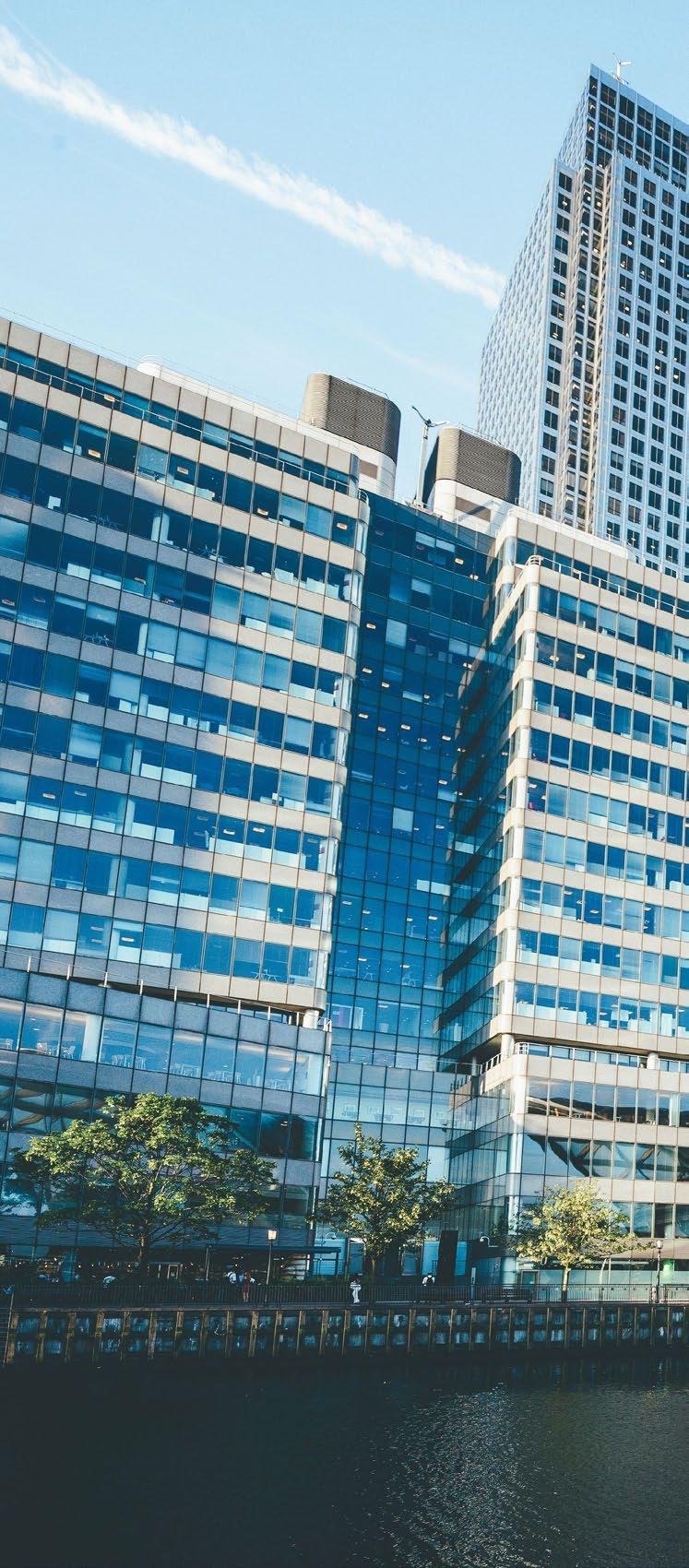
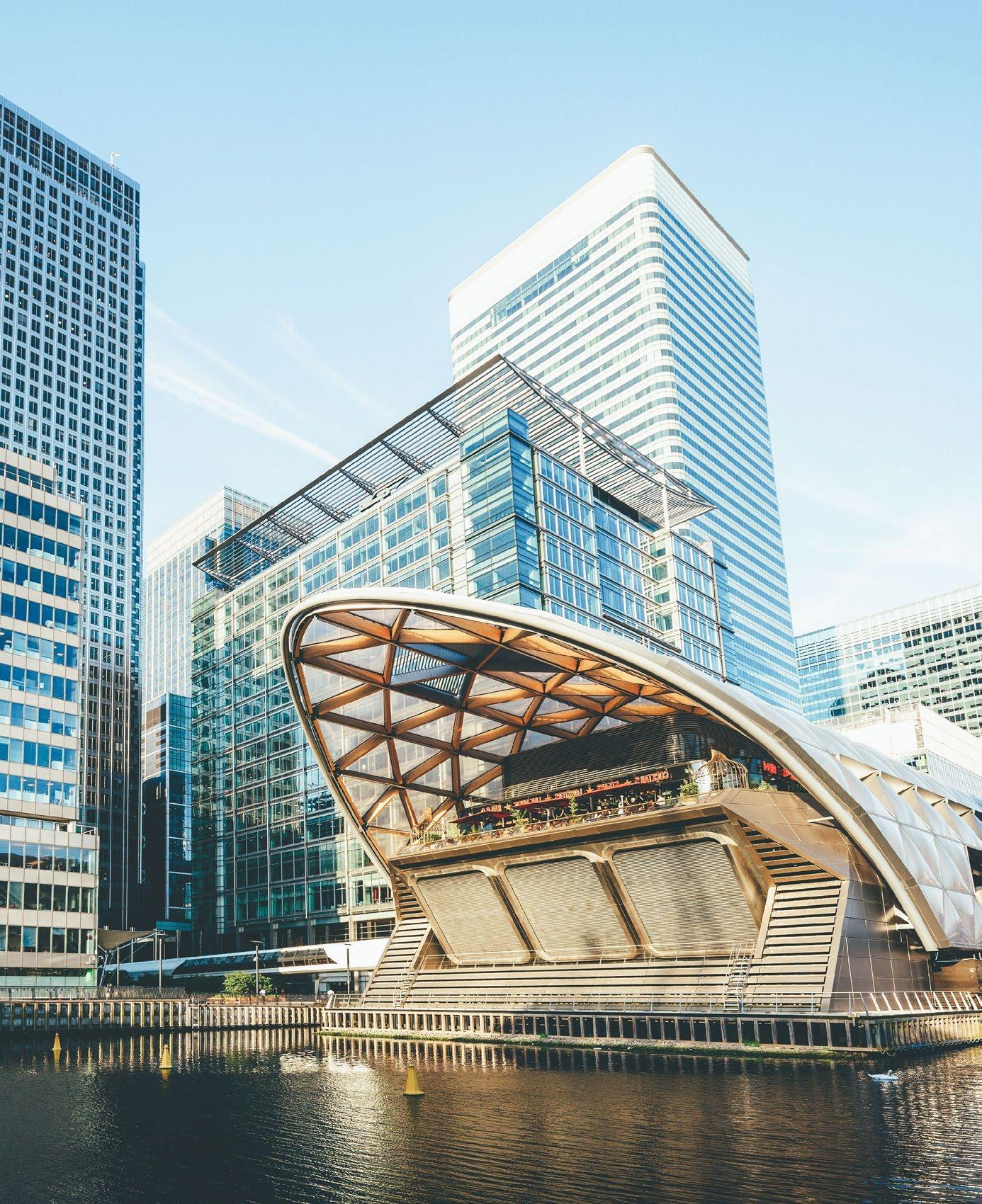
Young women, generally, are increasingly stashing away funds for property reasons. Housing affordability still remains a massive challenge, with deposits often out of reach. Gen Z are also questioning if owning is necessary or practical amid soaring prices – with some actually preferring flexible living arrangements, such as short-term leases.
Here’s where the “Bank of Mum and Dad” comes in handy. Recent surveys show nearly two-thirds of Gen Z individuals turn to their parents for financial support – especially around big purchases such as weddings or homes. This is a generation that knows full well that family support usually comes with strings attached, and as Sally Ashford from international law firm Charles Russell Speechlys notes, “It’s common for parental support to come with expectations, creating new dynamics and pressures”.
Perhaps surprisingly, when it comes to weddings, nearly half are open to prenups.
As Sarah Boon, a partner at Charles Russell Speechlys explains, “Prenups aren’t about pessimism; they’re about empowerment and mutual respect, practical planning for uncertain futures.”



Markedly, Gen Z’s relationship with money is deeply tied to purpose. They want to be changemakers and role models. They also give more than previous generations (according to a study by Enthuse, about 31% of this generation donate more regularly than the average population) – and in return, they demand brands lead on sustainability.
Authenticity is everything – and Gen Z reward brands that keep it real, popping their pounds into purpose-driven missions. As Paul Donovan, Chief Economist at UBS, puts it, “Wealth is not just an economic measure – it’s a social and political force.”
Unlike past generations, who often quietly gave to churches, the arts, or military charities, Gen Z aren’t shy about their philanthropy either, proudly putting their names to causes they care about. They’re also embracing fresh ways to give, from charitable trusts to donor-advised funds.
Take Becky Holmes and her sister Lauren Gupta, daughters of Bill Holmes who started the tech company Radius. Fiercely passionate about protecting biodiversity – and on a mission to inspire other young multimillionaires to follow their lead – they founded their own Helvellyn Foundation, through which they channel their family wealth to projects including the African Wildlife Foundation and Rewilding Britain.
Similarly inspirational is Bukayo Saka, the young Arsenal star funding life-changing surgeries in Nigeria and providing shelter for earthquake victims. Elsewhere, F1 driver Charles Leclerc spearheads flood relief fundraising in Italy and Covid-19 aid, and Caleb McLaughlin blends his Broadway career with efforts to boost financial literacy for young people.
As marketing expert Georgie Walsh puts it: “Gen Z aren’t just chasing trends; they’re shaping them. Gen Zers know what they want – and what matters.”
WEALTH IS NOT JUST AN ECONOMIC MEASURE, IT’S A SOCIAL AND POLITICAL FORCE
— Paul Donovan, UBS
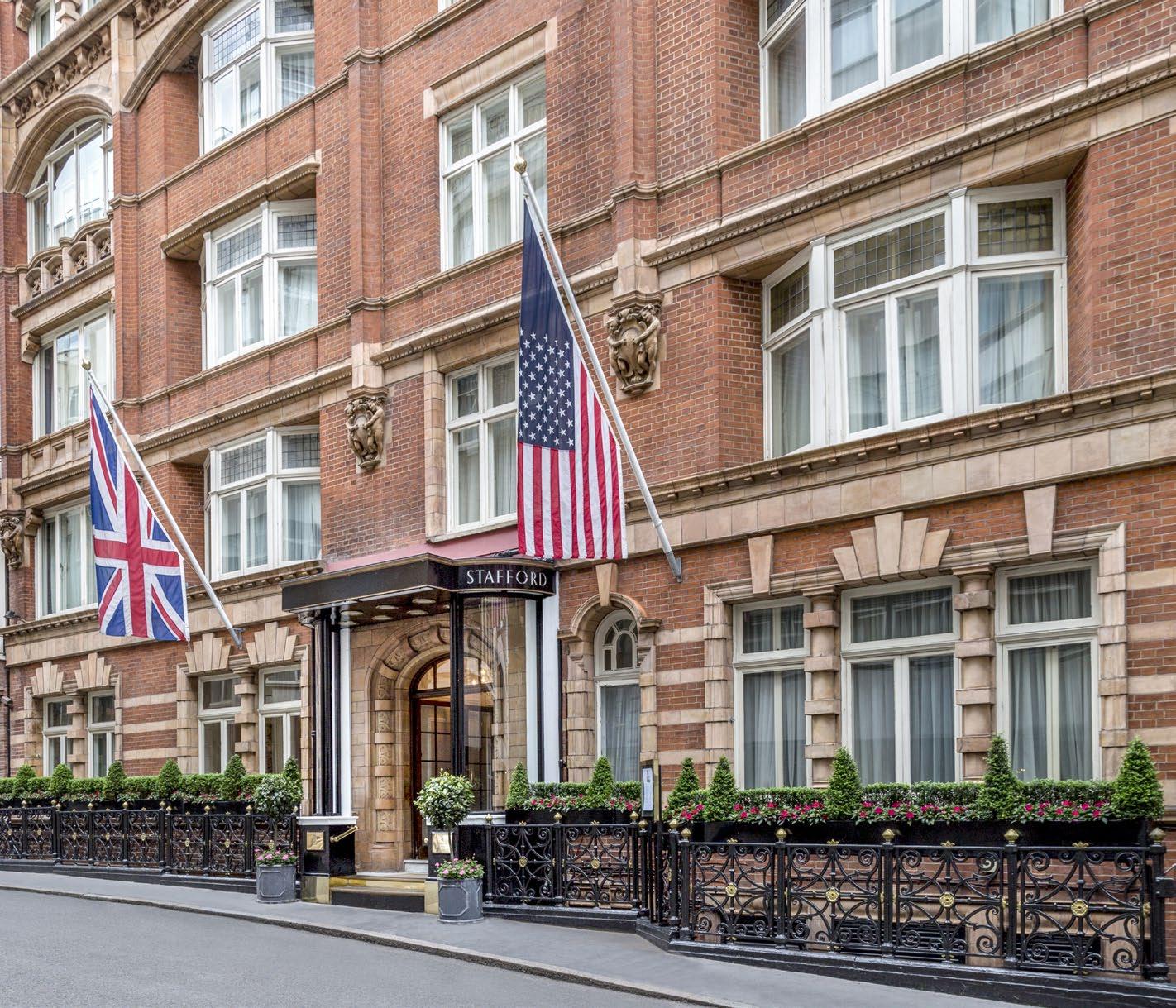
From ‘New York Happy Meals’ to a new residency by chef Michael Caines, we find out how The Stafford London is transforming the capital’s dining scene
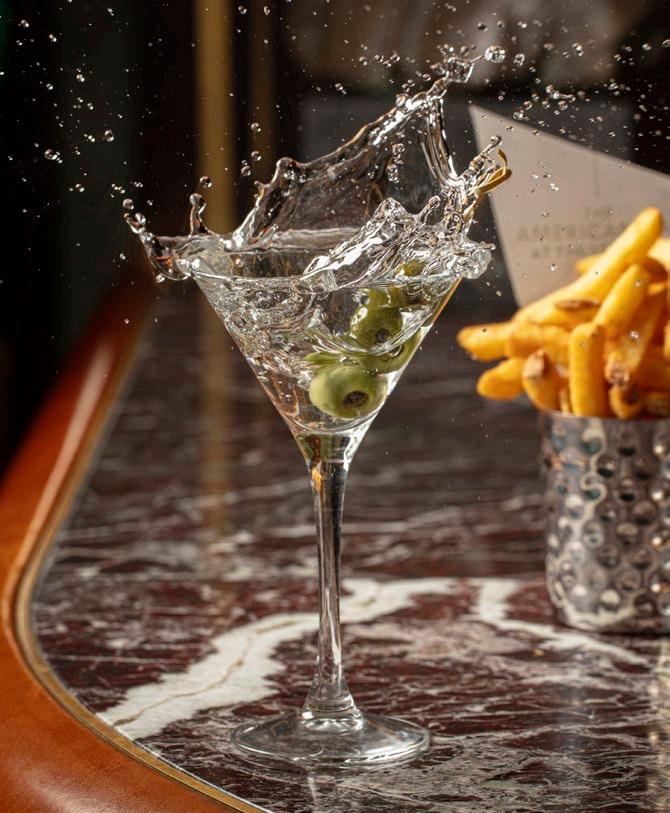
When it comes to hospitality, London has long been known for its fivestar service. From the world’s grand dame hotels offering Michelin-star meals to the moreish concept of restaurants-withrooms that blend overnight experiences from a kitchen-first perspective, there are few happier marriages than that of the capital’s hotel and restaurant industries.
Nestled in St James’s, The Stafford London is taking this to delicious new heights to position itself as a truly gastronomic hotel destination within the UK’s foodie capital, with its concept of ‘Stay, dine, celebrate’.
First established as a hotel in 1912, The Stafford began life as a private residence in the 17th century, and has served as a retreat for royalty, dignitaries and discerning travellers alike. The Stafford London was formed when the existing hotel expanded to include its neighbouring buildings – including the Stafford private members’ club.
During the Second World War, the hotel served as a club for American and Canadian officers stationed overseas – who often sought refuge in the historic Wine Cellars, which were

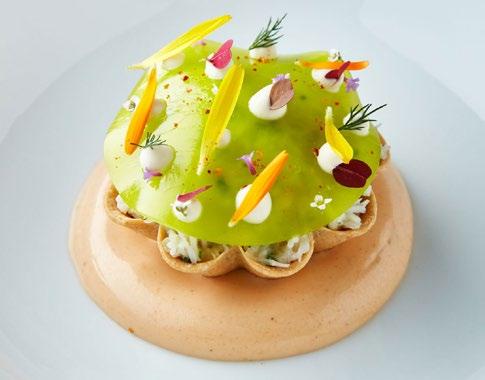
used as air raid shelters.
Part of the Preferred Hotels & Resorts collection since 2014, each of The Stafford London buildings emanate their own unique character. In the Main House, renovated in 2022, guests will find sumptuous suites that combine Victorian grandeur with modern comfort, from the Queen Rooms to expansive Master Suites; the Mews House acts as a private residence or collection of suites, set within the tranquil courtyard and complete with private entrance. Finally, the 380-year-old Grade IIlisted Carriage House, which once served as the stables of British nobles, offers guests the chicest possible environment when it comes to absolute privacy that is veritably drenched in understated opulence.
On the dining scene, The Stafford London is upping the ante, having signed Michelin-starred chef Michael Caines MBE as culinary strategist in April. The hotel has long been beloved for its exquisite Sunday roasts, delicate afternoon teas and its exceptional American Bar – one of the oldest American bars in London, serving up cocktails for refined guests since the 1920s. Its 400-year-old wine cellar, in addition to doing its
duty as a wartime shelter, is home to an extensive collection of rare and fine wines.
This summer, the bar’s courtyard terrace celebrated a sparkling new collaboration with Chapel Down English wine, as well as launching its hugely successful New York Happy Meal – a martini created to your preferred taste and paired with French fries.
This September saw the launch of Michael Caines at The Stafford – the chef’s debut London restaurant and core to his redesign of the hotel’s dining offering. The menu is rooted in seasonal British ingredients, modern European techniques and a nod to heritage favourites including Stafford Beef Wellington and Brixham Dover Sole.
The Stafford Collection – which also boasts Fitzrovia’s Sicilian-inspired restaurant Norma London – recently welcomed chef Michael’s Devon hotel, restaurant and vineyard Lympstone Manor as an associate member, underscoring its dedication to driving “exceptional hospitality and culinary excellence” from the very heart of St James’s.
staffordcollection.com

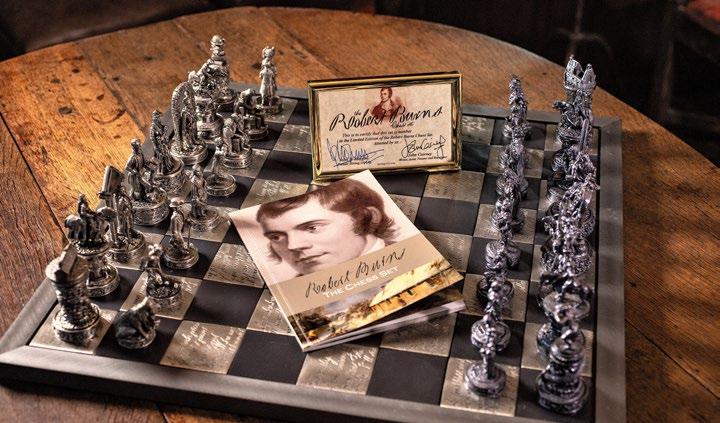

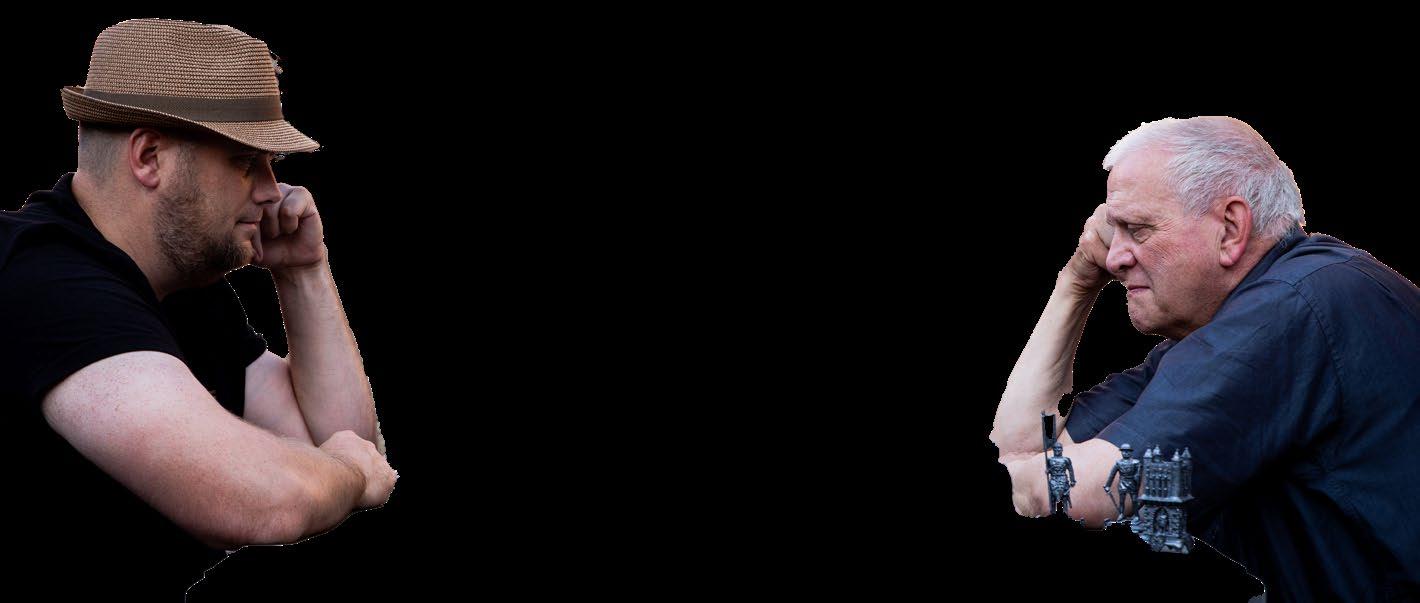
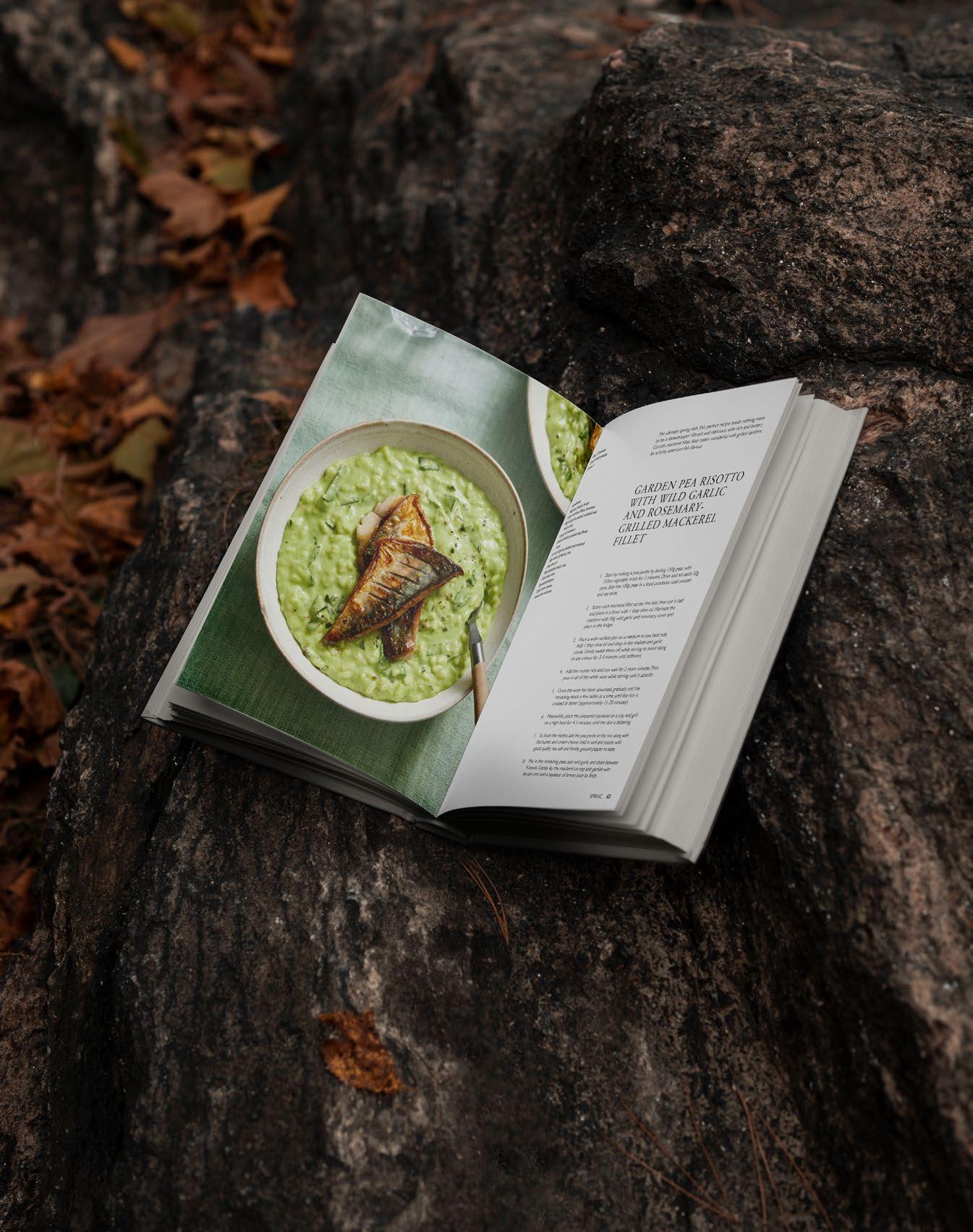
Seasons: A Taste of Cowdray brings seasonal fine dining into our homes
• Frieze London and Frieze Masters bring fine art to Regent’s Park
• London Film Festival prepares a star-studded cinematic line-up
• Cliveden Literary Festival begins its new chapter
• Save the Date: your global luxury calender
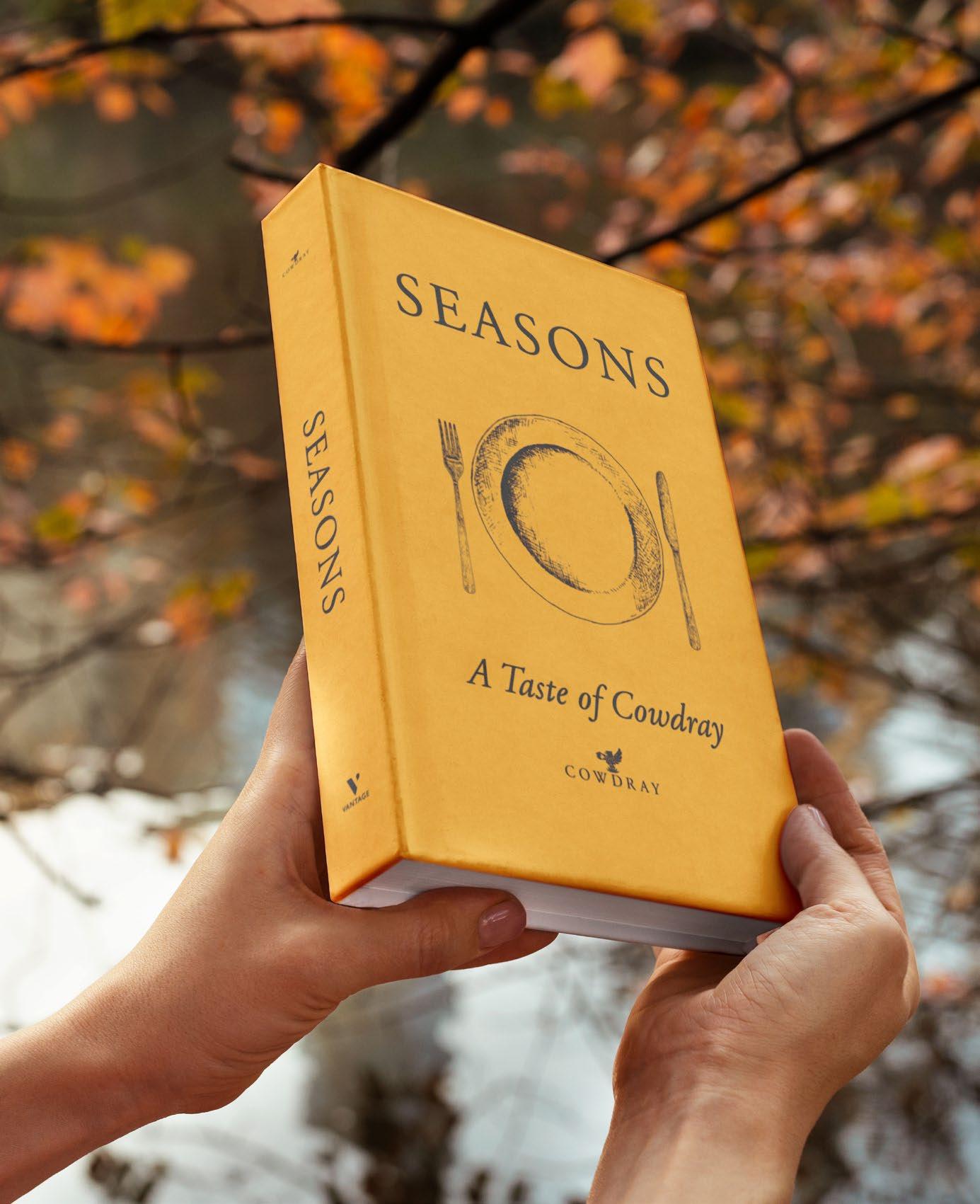

In the heart of the picturesque South Downs lies the historic Cowdray Estate, renowned for its remarkable Tudor history, prestigious polo club, 16,000 acres of scenic countryside, and commitment to locally sourced produce. One of many jewels in the estate’s crown is its Cowdray Farm Shop, which sells an array of fresh, seasonal produce from Nutbourne heritage tomatoes and asparagus to Cowdrayreared Wagyu, Aberdeen Angus beef and estate wild venison.
Now, to celebrate the Farm Shop’s 15th anniversary, Cowdray has released its first cookbook, Seasons: A Taste of Cowdray Inspired by the farmland, produce and people that make the estate so special, the book is packed with more than 80 seasonal recipes, using fresh British ingredients and bringing Cowdray’s favourite meals into our homes.
“We are incredibly proud of our produce at Cowdray, and we’re delighted to launch Seasons: A Taste of Cowdray to give you a glimpse of life on the estate,” says Michael Pearson, Fourth Viscount Cowdray, whose family has owned the estate for four generations. “These recipes carry stories of Cowdray and are designed to be a reminder that food tastes best when it is grown slowly, harvested gently, and shared generously.”
Recipes include informal bites to lavish
roast meats, grilled vegetables, gloriously dressed salads and indulgent desserts. Take your pick from dishes such as vibrant summer Nutbourne tomato salad, flavourful spring herb-crusted lamb rack, showstopping venison wellington and autumnal apple and filo pastry pie.
The book also delves into the production, and producers, of hero ingredients and estate stories, featuring interviews with Cowdray’s estate forager, deer manager, Home Farm land manager and executive chef Ben Jupp. It also provides tips on the best sauces and dressings to elevate meals, how to create the perfect polo picnic, and more.
“Whether cooking for many or preparing something for yourself, the book was created to inspire you to embrace the joy of seasonal living and have fun cooking in your own kitchen,” says Michael. “We hope readers enjoy learning more about the landscape, the produce and most importantly the people, and look forward to welcoming readers to Cowdray in the future.”
Seasons: A Taste of Cowdray is available to buy in store and online at Cowdray Farm Shop & Lifestyle, and in stores at Fortnum & Mason.
cowdray.co.uk
Frieze
and Frieze Masters invite “conversations with nature” at this year’s artistic extravaganza
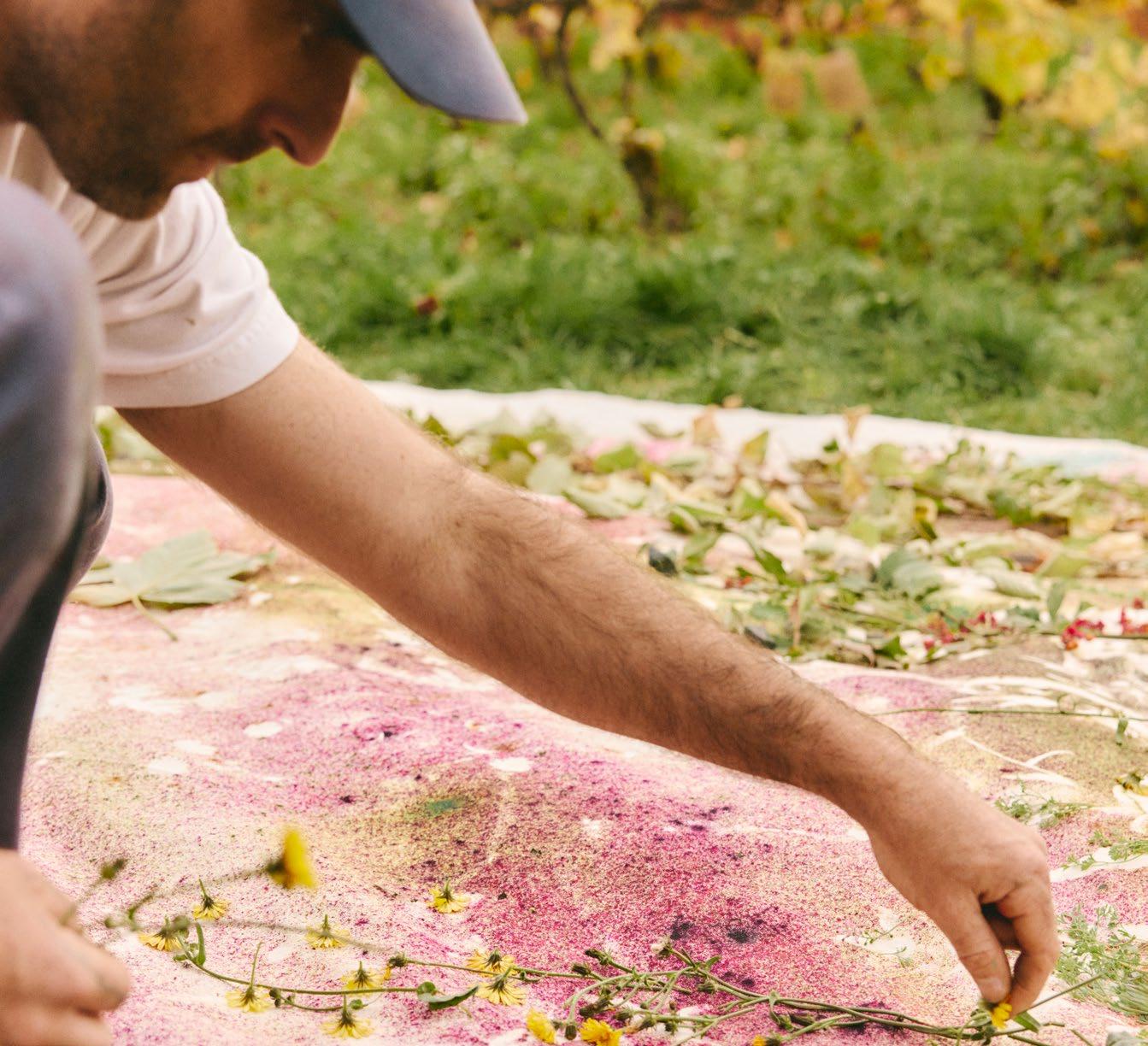
Celebrate art and culture in Regent’s Park this October as Frieze London and Frieze Masters showcase more than 280 galleries from around the world. This year, Frieze London debuts a groundbreaking new floorplan for the first time in a decade. Curated sections such as Echoes in the Present will explore the connections between contemporary artists from Brazil and Africa, while Focus will champion emerging international talent through 34 solo and dual presentations. The popular Artist-to-Artist feature will see six established creators – including Camille Henrot and Chris Ofili – introduce their favourite emerging stars.
Frieze London award-winning artist Sophia
Al-Maria will make a guest appearance that uses classic comedy to discuss important global matters. She describes stand-up comedy is “the last honest art form”, due to the fact that it “requires presence” – something that, she notes, is becoming increasingly important as AI bleeds into the industry. Her exhibition, Wall Based Work, will include daily live performances at the fair.
Meanwhile, Ruinart, the official champagne of Frieze, will host a standout exhibit by contemporary artist Sam Falls (above), titled Conversations with Nature. Exhibited within the Ruinart Art Bar at the London fair – where Ruinart cuvées can be paired with canapés by Moonyung Lee, head chef of Silo restaurant – the artist’s
works including 'Rewilding' were created in situ at the maison’s historic Taissy vineyard.
Frieze Masters, which spans 6,000 years of fine art, brings together leading galleries such as Åmells Konsthandel and ArtAncient to showcase popular antiques, as well as specialist galleries presenting lesser-known works. Discover under-recognised 20th century artists – this year focusing on works spanning from the 1950s to the 1970s – at the fair’s Spotlight section, while its Studio division celebrates acclaimed living artists such as Dorothy Cross, Glenn Brown and Anne Rothenstein.
Regent’s Park, London. 15-19 October frieze.com
The annual London Film Festival returns to the Southbank this October, after breaking records with more than 230,000 visitors attending the event in 2024. In excess of 250 films will be at this year’s festival, covering a various genres and local and international films. Kicking off with the much-anticipated Wake Up Dead Man: A Knives Out Mystery – the third instalment of the beloved detective franchise starring Daniel Craig (right) – director Rian Johnson credited London as: “the birthplace of the golden age of detective fiction”.
Among the many star-studded galas to be hosted at the Royal Festival Hall are Guillermo del Toro’s Frankenstein, starring Jacob Elordi and Oscar Isaac; H is for Hawk, starring Claire Foy; and period drama Hamnet, featuring mesmerising performances by Jessie Buckley and Paul Mescal.
South Bank, London. 8-19 October bfi.org.uk

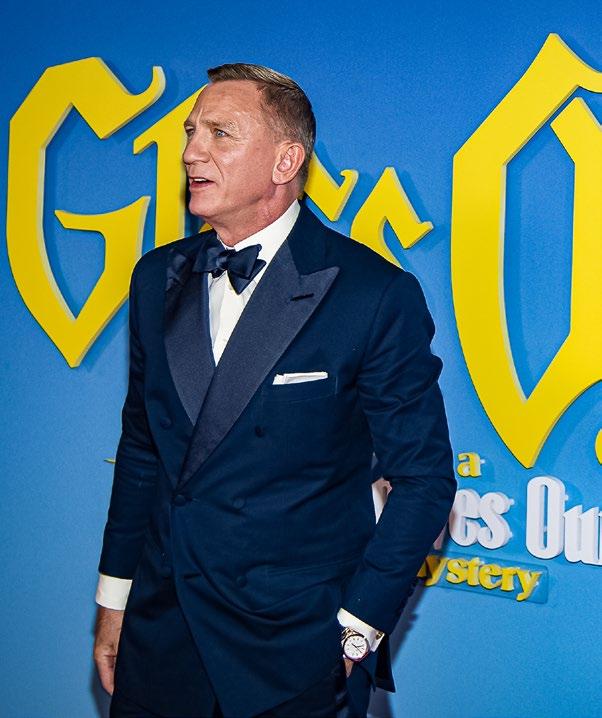
The UK’s most elegant literary festival will once more bring together writers, creatives, experts and book lovers in the scenic surrounds of Cliveden House. Returning for its eighth year this October, Cliveden Literary Festival will introduce a star-studded guest list including authors Ian Rankin, Elif Shafak, Salman Rushdie, and Richard E Grant.
The festival, run by a committee of authors and historians, is a place for discussion, debate and innovation hosted in the impressive grounds of Cliveden House (left). The former stately home is now a five-star hotel owned by the National Trust, and boasts a storied literary history – it was frequented by writers and thinkers including Alexander Pope, Alfred, Lord Tennyson, and Sir Winston Churchill. This tradition is continued at the literary festival, where attendees can enjoy author talks, reading seminars from industry experts and more.
Cliveden house, Buckinghamshire. 11-12 October clivedenliteraryfestival.org
Your luxury events calendar for this season

17-19 Oct 4-5 Oct 25 Oct - 2 Nov
Prepare for spectacular action at Europe’s most lucrative horserace, which has prize money of €5m (£4.3m). Hosted at Longchamp racecourse in Paris, the prestigious Prix de l’Arc de Triomphe welcomes thoroughbred horses from across the globe. parislongchamp.com
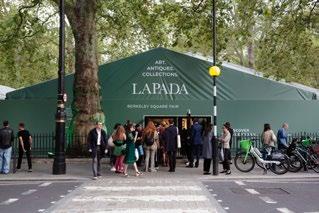
28 Oct - 2 Nov

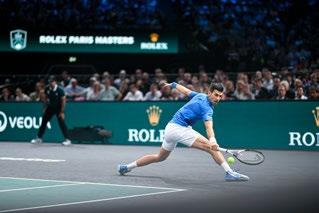
Formula 1 champions take on the Circuit of the Americas in Austin, Texas, as they saddle up for a thrilling US Grand Prix. With fivestar southern hospitality and entertainment from music stars, including DJ Kygo and country star Garth Brooks, this is one race that’s not to be missed. formula1.com
The largest indoor men’s tournament on the ATP circuit becomes even bigger this year as it moves its new venue, the Paris La Défense Arena, which has an increased spectator capacity of 23,000. Visitors will love every game, set and match of this thrilling event. rolexparismasters.com

29 Oct - 2 Nov
13-16 Nov

One of the world’s most renowned arts and antiques fairs returns to the heart of London’s Mayfair, inviting more than 80 exhibitors offering authenticated antiques, stand-out design and unique decorative arts. A treasure trove of sought-after pieces awaits. lapada.org
The world’s largest in-water boat show will display more than 1,300 spectacular boats from 1,000 exhibiting brands. Located steps from the beach in sunny South Florida, it covers more than three million square feet of exhibit space, connected by a network of water and ground transportation services. flibs.com
While every effort has been made to ensure accuracy, changes to event calendars may occur. Please check with individual event organisers for more information.
Watch as the top 50 golf players from the Race to Dubai series descend upon the Greg Norman-designed Earth Course at Jumeirah golf estates in Dubai. This prestigious event sees world-class golfers compete to become the champion of the DP World Tour. europeantour.com
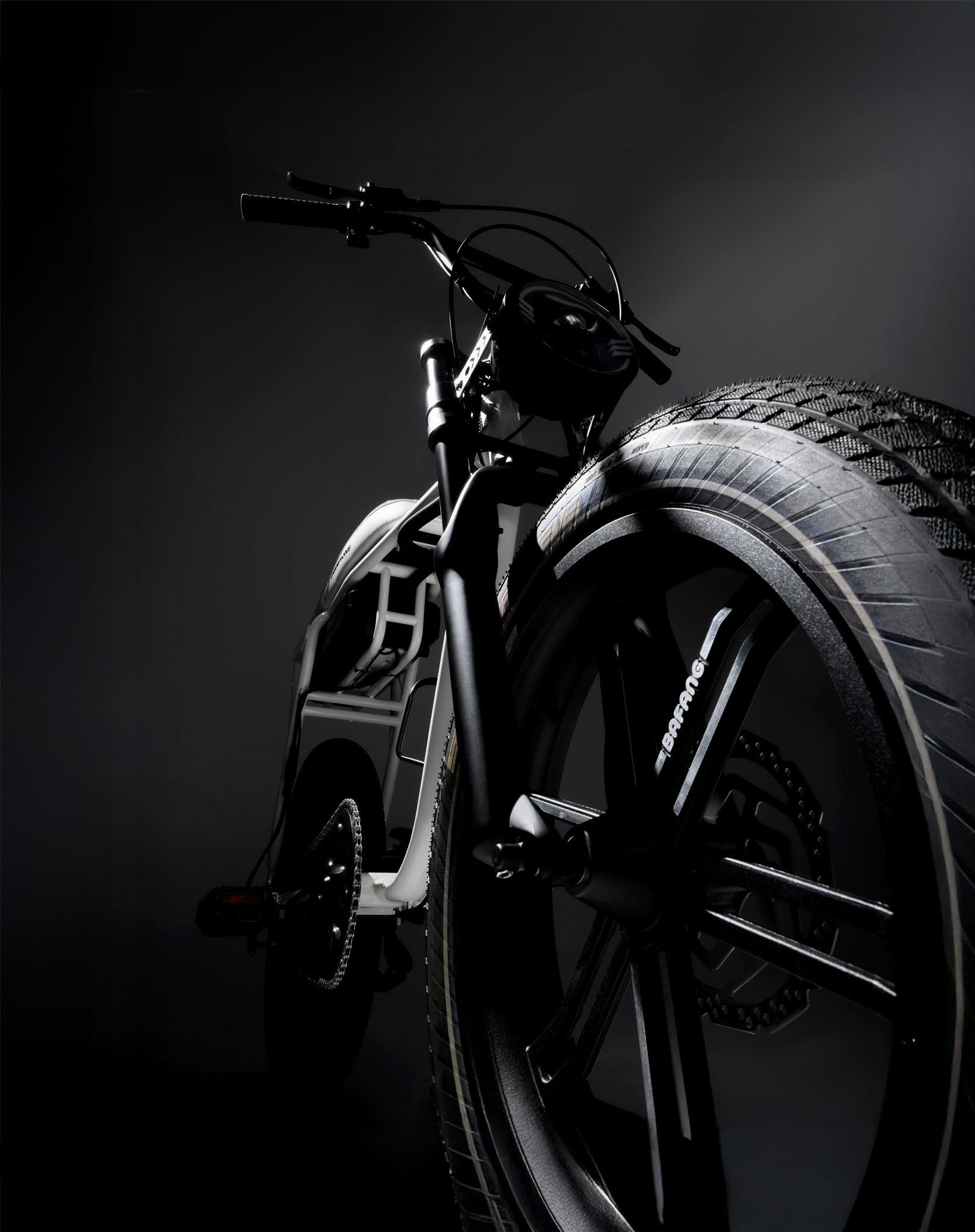

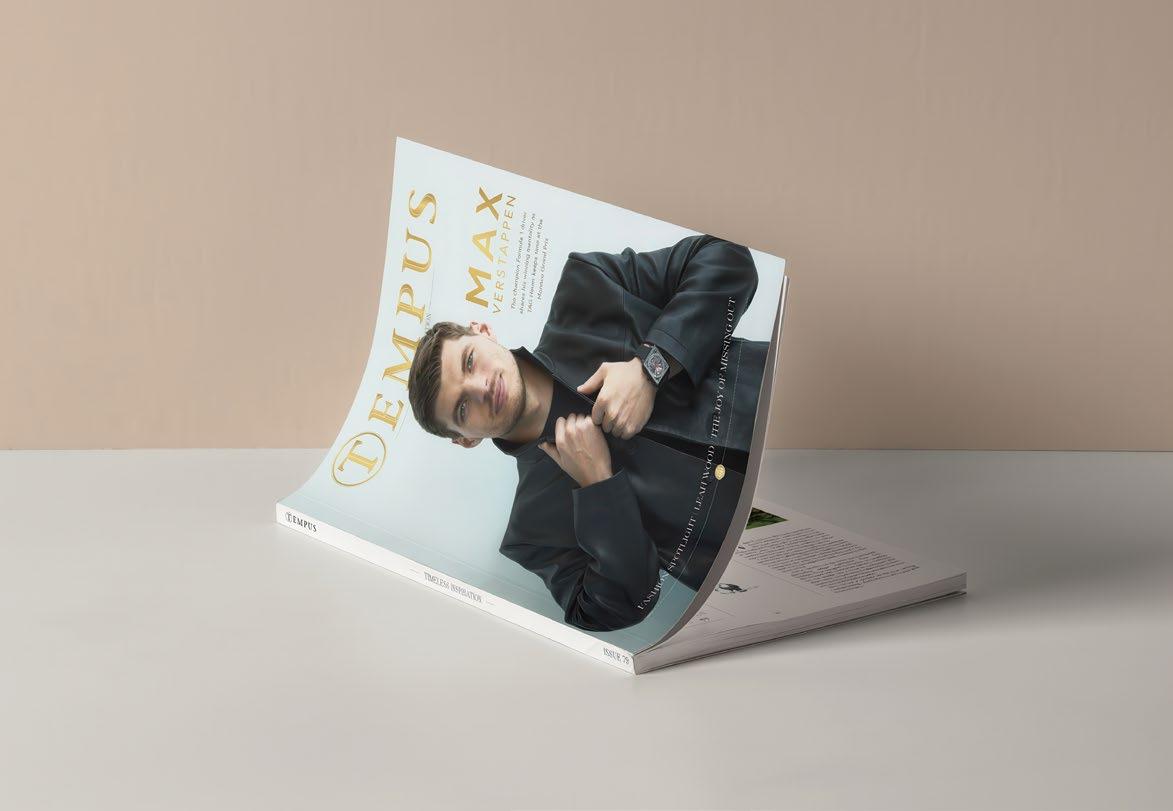
Get all the essential news and views from the world of luxury delivered direct to your door FOR YOUR DAILY DOSE OF THE BEST IN LUXURY NEWS, FEATURES AND EXCLUSIVE CONTENT
Four copies of Tempus magazine delivered to your address every year
Exclusive invitations to private events, from shoot days and polo matches to supper clubs and boutique showcases
Access to exclusive digital content
Regular newsletters featuring the latest news, reviews and exclusive member benefits
Visit tempusmagazine.co.uk/subscribe

tempusmagazine.co.uk



It’s fair to say jeans are having something of a moment. From the controversial American Eagle advertisement starring actor Sydney Sweeney, to the intentionally inclusive campaign by GAP featuring K-pop group KATSEYE, there’s a reason your social media feeds have been full of denim, dance routines and subsequent op eds. Denim has always been something of a stalwart when it comes to garment choices. Not only is that due to the wide variety of weights, washes and styles, it’s also because this material has a tendency to take on a life of its own. Having a brand-new pair of jeans is all well and good, but after wearing them for a year or two – once the denim becomes distressed allowing for whiskers, honeycombs and other creases to appear – they just look infinitely cooler.

Unisex, classic and uncompromising, this is an essential pair of jeans crafted from 13oz Japanese selvedge denim, featuring a high rise waist, and straight leg with subtle taper.
blackhorselane.com
As a relatively stocky individual, I’ve always loved the idea of Levi’s but I’ve never quite found a pair that fit me. I also don’t like shopping on the high street as the options are usually poor quality, synthetic and most of the time, they still don’t fit my shape. It led me down various trails and rabbit holes to these three brands that I adore.
Blackhorse Lane Ateliers will always be top of my list as they provide incredible quality and construction, plus a lifetime of repairs. Any jeans you buy from them (and even ones you don’t), you can bring in for repair, extending their lifespan. As I like a fuller leg, my pick of the bunch is their E6 Wide Straight 13oz Neppy Japanese Selvedge jean, which is the pair I’m wearing as I sit in a cafe on Savile Row writing this column. Natalino, meanwhile, is probably my

favourite menswear brand of the moment. Their incorporation of soft tailoring into otherwise casual attire is unmatched, and my favourite pair of jeans that they offer is the Light Blue Wash Straight Leg Japanese Denim. When paired with a good, tailored sports jacket, white tee and baseball cap, it gives that 1990s-Dad-but-make-it-cool aesthetic, which is essential styling for autumn 2025.
Finally – and these are certainly more of a statement than an everyday wear – the Denim Flares by Edward Sexton. Trust the Savile Row icon to elevate a casual item and make it rock’n’roll. The high-rise, the rich denim colour and almost obnoxiously wide flares give these jeans a ‘70s-inspired edge. They’re an incredible option if you’re looking to turn heads.

These uber-smart denim essentials sit somewhere between a dressed-up jean and an informal trouser. The classic blue parallels have a seriously cool, 1970s-inspired rock’n’roll twist typical of Edward Sexton's stylish tailoring. edwardsexton.co.uk
Light Blue Wash Straight Leg Jeans by Natalino
Quintessentially cool – who doesn’t love some ‘90s flare? This unfussy, five-pocket denim jean woven on vintage shuttle looms in Okayama, Japan, is perfect for dressing down a tailored outfit.
natalino.co
